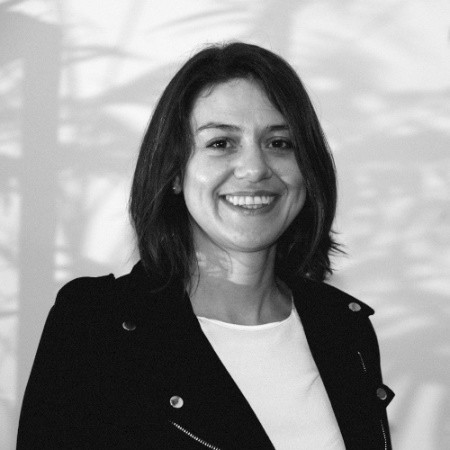Series: Westerners in India.



The following is an expanded and more compressive article that is sourced from Ashrams of India Volume 2.
In 1911, Frank Humphreys, a policeman stationed in India, became the first Westerner to discover Sri Ramana. He wrote articles about him which were first published in The International Psychic Gazette in 1913.
Sri Ramana only became relatively well known in and out of India after the publication of two books in 1934 and 1935 by Paul Brunton, who had first visited him in January 1931 along with Bhikshu Prajnananda (former military officer Frederick Fletcher known later as Swami Prajnananda).
Some of the other foreign visitors that followed included Maud Alice Piggot who in January 1935 is thought to be the first English lady to visit Sri Ramana,
American social psychologist, Professor Pryns Hopkins (Prynce Hopkins) visited Sri Ramana after reading about him in Paul Brunton’s A Search in Secret India,
Grant Duff (Douglas Ainslie 1865 – 1948) was a Scottish poet, translator, critic and diplomat born in Paris, France, visited in 1935,
American anthropologist and writer Walter Yeeling Evans-Wentz in 1935,
American Chemist Dr Bernhard Bey in 1935,
Paramahansa Yogananda (accompanied by his secretaries Richard Wright and Ettie Bletsch) in November 1935,
Maurice Frydman, a Polish-Jewish devotee who was a research engineer working in Bangalore was a frequent visitor from 1935,
Major A.W. Chadwick in November 1935,
Hans-Hasso Ludolf Martin von Veltheim-Ostrau in December 1935,
English Poet Lewis Thompson in approximately 1935 and stayed for 7 years,
Polish writer Wanda Dynowska (Uma Devi) lived in India from 1935 until her death in 1971 visited often,
American spiritual writer, author of the spiritual book series Life and Teaching of the Masters of the Far East, Baird T. Spalding (1872 – 1953) with a party of tourists that included the American couple Mr and Mrs Taylor in 1935 or 36,
S.S. Cohen, an Iraqi Jew, who made Ramanasramam his home in 1936,
American Dr Henry Hand in 1936,
American birth control advocate Margaret Sanger visited in January 1936,
There were some French ladies and gentlemen and American as visitors to the Asramam in January 1936,
33 year old Dutchman Sadhu Ekarasa (Dr G.H. Mees) came in 1936, (he mentored Hildegard Elsberg, a German Jew who lived in India for 10 years from 1937, teaching at a convent school in Kodaikanal – it is not known when she first arrived in the ashram but is thought to be 1937/38),
Olivier Lacombe (L’Attache Culturel, Consulat General de France, Calcutta) was a French doctor of philosophy who came for darshan in May 1936,
British scholar and Theosophist Duncan Greenlees, came in October 1936 for a few days,
French Dr Suzanne Alexandra Curtil Sen (Sujata Sen) in December 1936,
Pascaline Mallet visits in December 1936, a French writer and seeker whose 1938 book Turn Eastwards details her nine-month pilgrimage in India from December 1936 to September 1937,
Alfred Julius Emmanual Sorensen (Sunyata) was a Danish devotee made the first of four trips to Ramana in 1936,
American Mrs Roorna Jennings of the International Peace League, January 1937,
Professor Banning Richardson arrived in May 1937 and stayed for three days,
Swiss author Lizelle Reymond and future husband Jean Herbert in 1937,
David MacIver in 1938,
American engineer Guy Hague arrived in Sri Ramanasramam in 1938 after travelling the world, he stayed 2½ years,
Christina Austin brought Somerset Maugham (and his companion Gerald Haxton ?) to the ashram in January 1938 for a few hours (his 1944 novel The Razor’s Edge models its spiritual guru after Sri Ramana),
Three ladies on a short visit in Feburary 1938, Mrs Hearst from New Zealand, Mrs Craig and Mrs Allison from London,
A young English woman, identified as Miss J, arrived in May 1938, dressed in a Muslim sari, she had evidently been in North India and met Dr. G. H. Mees,
An American gentleman, Mr J. M. Lorey in June 1938,
Cuban-American writer of the 1920s and 30s Mercedes de Acosta stayed for three days in 1938,
renowned American painter Eliot C. Clark visited in 1938,
from Morocco, Bernard Duval in 1938 for about 15 days,
Two ladies, one Swiss and the other French, visited Maharshi in December 1938,
English woman Miss Ward-Jackson 1938/39,
Eleanor Pauline Noye arrived in 1939 and stayed for 10 months,
Ethel Merston visited in 1939,
Ella Maillart was a Swiss travel writer and photographer who remained in India from 1939 to 1945 and resided mostly in Tiruvannamalai,
William S. Spaulding Jr of New York City visited Sri Ramana in the 1930s,
Mother of Dr Suzanne Alexandra Curtil Sen, Jeanne Curtil and Suzannes’s daughter Monica arrived in 1940, Monica would attend school in Bangalore but would visit the ashram once or twice a year until 1952,
Lucia Osborne with her children Catherine, Frania and Adam, arrived in 1942,
Blanca Schlamm (Atmananda), an Austrian concert pianist in 1942,
William Samuel stayed and sat in the silence with Ramana Maharshi for 14 days in April 1944,
Alexander Phipps (Madhava Ashish) visited in 1944,
Australian travel writer Frank Clune visited in 1944,
Arthur Osborne in 1945,
Osborne’s fellow POW, Dutchman, Louis Hartz would visit after the Second World War,
Georges Le Bot, Private Secretary to the Governor of Pondicherry, and Chief of Cabinet of the French Government visited in December 1945,
British teacher Mr Phillips who was a former missionary and had been in Hyderabad for about 20 years visited in May 1946,
European Mr Evelyn in May 1946,
Mrs Barwell (whose husband was a barrister in Almora), accompanied by Australian Miss Eleanor Harriet Rivett, principal of the Women’s Christian College in Madras, visited in September 1946,
Wanda Dynowska (Uma Devi) arrived with a party of 25 Polish people, mostly girls in October 1946,
Miss Boman, a Swiss lady who had been in India for about eight years, and was head of the Baroda palace staff of servants, stayed for 4 days in October 1946,
American Robert Adams also stayed for three years from 1947 (disputed as to whether he was ever at the ashram),
Swiss Henri Hartung first came in 1947 for ten days,
Elsa Lowenstern is mentioned in Thelma Rappold’s 1948 diary entry,
a French sannyasin is also mentioned in the same diary who came for Bhagavan’s darshan, leaving France four months previously without any money, stowing away on a French ship bound for India. Barefoot and with nothing to call his own but the clothes on his back, he was making a pilgrimage through India in search of spirituality,
American Thelma Benn (later Rappold) spent nearly three years with Ramana Maharshi from February 1948 until Summer 1950 (her husband Sam Rappold was there for most of this time – these two Americans arrived in India independently, they married in Varanasi before leaving India), her friend from Seattle Mrs Wally Groeger visited her in the ashram in December 1948 and stayed for nearly a year, before going on to meet Swami Ramdas and then later returning to the States,
British national Sangharakshita (Dennis Philip Edward Lingwood) and his Indian friend Buddharakshita arrived in late November 1948, and stayed for six weeks,
American journalist Winthrop Sargeant arrived in 1948 for the Life Magazine article published in 1949,
American Photographer Eliot Elisofon spent two weeks on the ashram in 1948 taking the photos for Life Magazine that were published in 1949 (he made several trips to the ashram),
French photographer Henri Cartier-Bresson first visited in 1948, and later in 1950, arriving 10 days before the Maharshi’s mahasamadhi,
Krishna Prem (Ronald Nixon) met Ramana Maharshi in 1948,
two English women from South Africa Gertrude de Kock and Eureka Wessels arrived in 1948 staying for 10 days,
Stanford University professor Frederic Spiegelberg visited Ramana Maharshi sometime between 1948 and 1949,
friends of Eleanor Pauline Noye, Melva Cliff and Ananda Jennings were at the ashram for some weeks in 1949,
Swede Peer Wertin / Per Westin (Swami Ramanagiri) in 1949 and in 1950,
Mieczyslaw Demetriusz Sudowski (Mouni Sadhu) Polish author of spiritual, mystical and esoteric subjects in 1949 for a few months,
Henri Le Saux (Swami Abhishiktananda) first visited the ashram in January 1949 along with Fr. Jules Monchanin (Parama Arubi Ananda) who was on his third visit,
Dutch teacher and writer Wolter A. Keers was taken to Ramanasramam in 1950 by Roda Maclver, wife of David MacIver,
Miss Eleonore de Lavandeyra in 1950,
American yogini Judith Tyberg (Jyotipriya) stayed for a week sometime between 1947 and 1950.
Unidentified Western visitors and devotees of Ramana Maharshi at the end of the article.
https://archive.arunachala.org/ramana/devotees



In 1911, Frank Humphreys (Francis Henry Humphreys, later as Nicholas Francis Humphreys), Assistant Superintendent of Police in Vellore, was the first Westerner known to sit in Ramana Maharshi’s presence. He was born in 1890 in London, of High Anglican parents. His father was a struggling physician; his mother was interested in the occult and practiced fortune-telling, table-turning, second sight and later, Spiritualism. He was to contract pleurisy, malaria and suffer numerous other health issues that plagued him throughout his life. He had more than twenty-five serious operations and spent over seven years in hospitals at different times. The 21-year-old British police officer had at least three face-to-face visits with the young Sri Ramana who was at the time living in the Virupaksa Cave. He was brought to meet the Maharshi by S. Narasimhayya (who was a disciple of Sri Kavyakanta Ganapati Muni and a devotee of Bhagavan) and Ganapati Muni. Fortunately, Humphreys recorded some of his experiences, he published the book Glimpses of the Life and Teachings of Bhagavan Sri Ramana Maharshi. The book is based on articles that Humphreys first published in The International Psychic Gazette in 1913. Humphreys was baptised a Catholic (brought up as an Anglican) and took his first vows in the Dominican Order at the age of 37 (14 years after leaving India). He wrote, “I was at home at last, and through the kindness of the Order have been at home ever since.” He took “Nicholas” as his name in religious life. He worked tirelessly for 45 years serving the needy in South Africa, where he died in on September 20, 1975, and was buried at Stellenbosch.
From https://english.sreyas.in/light-of-the-world/ The story of Humphreys itself was unusual. He arrived at Bombay in 1911 on being appointed as an Assistant Superintendent of Police, and within a short time of landing at Bombay fell sick. By then he already had practised yoga and was capable of travelling to any place in the subtle body leaving the gross one. Through his subtle body, Humphreys was able to find a Pandit (Munshi) at Vellore to teach him Telugu. On March 18, the Telugu Pandit, Sarvepalli Narasimham (later, Swami Pranavanada) came to him.
The student began questioning the Munshi about philosophic matters. He also asked the teacher to fetch him books on astrology. The next day when the Munshi came, he asked him if there were any Mahatmas in the vicinity and if he knew any such one. The Munshi probably thought that all talk of a guru to the Englishman was unwarranted and hence replied that he knew no Mahatma. The next day, the student said, “Munshi, you said yesterday that you did not know of any Mahatma but your guru appeared in my dream this morning. In fact, you were the first person of Vellore that I saw even at Bombay.” The Munshi protested that he had never visited Bombay at all. Thereupon, the student told him of the occult powers acquired by him through the practice of yoga. The teacher was impressed and as requested by the student, showed him some pictures of great souls. On seeing Ganapati Muni’s picture, Humphreys exclaimed, “This is the great man who appeared in my dream this morning. Is he not your guru?” Then the Munshi had to acknowledge that Ganapati Muni was indeed his guru.
Within a fortnight, Humphreys fell ill again and had to be moved to Ootacamund. He kept writing to the Munshi every now and then. Once he wrote that he saw a person with matted hair, a long beard and brilliant eyes. On another occasion, he said that he proposed to give up non-vegetarian food to facilitate his practice of pranayama and dhyana. On yet another occasion, he asked whether it would be proper for him to rejoin an esoteric society of which he was a member earlier. After the return of Humphreys from Ootacamund, he and the Munshi joined Ganapati Muni in November 1911 on a visit to the Maharshi. In his very first question posed to Bhagavan, his struggle as a youth, his high ideals and his desire to help others were revealed. The Maharshi also spoke to him partly in English.
Humphreys: Swami, can I do anything to reform the world?
Maharshi: You reform yourself first. It is as good as reforming the world.
Humphreys: I wish to do good to the world, will I not be able to do it?
Maharshi: You do good to yourself first, after all you are also part of the world. Not only that, you are the world, the world is you. Both are not apart.
Humphreys (after a pause): “Swami, will I not be able to perform any miracles like Krishna, Jesus and the like?
Maharshi: Did those people think that they were performing miracles while doing those acts?
Again after a pause Humphreys replied in the negative. Maharshi perhaps thought that interest in such
powers would cause harm to Humphreys and warned him that the only thing to be obtained was the atma and that he should devote all his energies towards that end. He added that Humphreys should work towards the goal with an attitude of complete self-surrender.
Bhagavan once described Arunachala as a unique hill of light, so was he. Those who visited him once were bound to return over and over again. Humphreys paid a visit to Bhagavan a second time. In the midday hot sun, he travelled all the forty miles from Vellore on a motor cycle to Tiruvannamalai and there, picking up Raghavachari, a P.W.D. Supervisor, paid a visit to Bhagavan. He was tired and dust-laden; on seeing him, Bhagavan offered him some refreshments and quietened him. At that moment, the District Munsiff A.S. Krishnaswami Iyer was also there. With both Raghavachari and Krishnaswami acting as interpreters the conversation proceeded.
Humphreys: Swami, I easily forget the lessons, only the last words remain in my memory. What should I do?
Maharshi: You can attend to your duty as well as to your meditation.
Humphreys had Bhagavan’s darshan a third time. By then his regard for him had reached such a level that he considered it sacreligious to climb the hill with his shoes and hat on. So, he discarded them and reached the cave barefoot. Bhagavan while returning to the cave from somewhere saw Humphreys’ belongings on the way and asked Palaniswami, who was with him, to pick them up. No one knew what instructions Bhagavan gave Humphreys on that occasion.
Humphreys wrote a letter to his friend in England, detailing his visits to Bhagavan and the instructions he received. The friend, Felix Rudols, put it in the form of an article and got it published in the International Psychic Gazette. Later, that article was translated into several other languages and seekers of various lands benefited from the instructions of Bhagavan. Much later, the Englishman quit his job and became a monk of the Roman Catholic Church.
Glimpses of the Life and Teachings of Bhagavan Sri Ramana Maharshi https://realization.org/p/frank-humphreys/temp/glimpses.html
Face to Face with Sri Ramana Maharshi Compiled and Edited by Professor Laxmi Narain.
https://www.stillnessspeaks.com/wp-content/uploads/2016/07/Face_to_Face_with_Sri_Ramana_Maharshi.pdf



Download: Not So Trivial A Tale : Memoir of Nicholas Francis Humphreys O.P. 1890 – 1975 https://archive.org/details/not-so-trivial

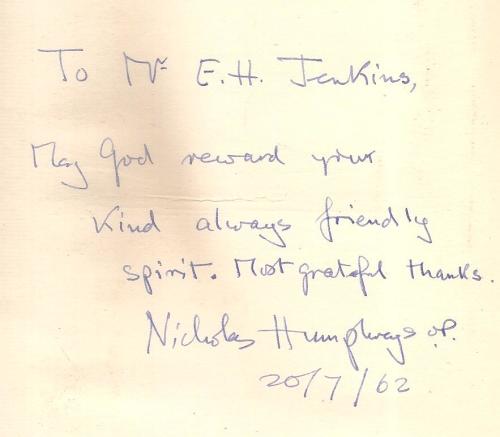


Among the first Westerners to come and stay at the ashram were Paul Brunton (the pen name of Raphael Hurst) (21 October 1898 – 27 July 1981) and Bhikshu Prajnananda (former military Frederick Fletcher officer known later as Swami Prajnananda, founder of the English Ashram in Rangoon) who lived in a two-room cottage to the north of the tank in Palakothu. Brunton, who arrived in 1931, was a British philosopher, mystic and traveller who had left a journalistic career to live among the yogis, mystics and holy men to study Eastern and Western esoteric teachings. He has been credited with introducing Ramana Maharshi to the West through his books A Search in Secret India published in 1934 and The Secret Path published in 1935.
Bhikshu Prajnananda was an Englishman and an Oxonian, his earlier name was Frederick Fletcher. He mastered several European languages and was a commander of the armed forces during the world war. The immense destruction and loss of life during the war touched him, repelled by the slaughter he eventually gave up his military career and became more inward looking. He embraced Buddhism and became a bhikku (monk).
In 1932, he spent two months at Ramanasramam and heard Bhagavan’s teachings in person. He profited greatly by them and developed a reverential attitude towards Bhagavan. He remained in touch through correspondence seeking Bhagavan’s advice on matters spiritual. He would also write to his friends extolling Bhagavan’s divine qualities. In the Sunday Express of 28th of May 1933, there is an article about him ~ HAR Men with the Elixir of Life by Rhy Darby.




Maud Alice Piggott (1877 – 1974) was born in England, traveled to India several times, but ultimately settled down in Hollywood, California where she passed away on August 19th, 1974 at eighty-seven. She joined contemporaries such as Douglas Ainslie (Grant Duff), Sunyata, Anagorika Govinda, Pauline Noye, W. Y. Evans-Wentz, who also earlier in life had had some association with Ramana Maharshi and for one reason or another migrated to or lived in California. At that time California was an incubator for spiritual discovery and intellectual openness that attracted scores of seekers looking for new approaches to inner and outer fulfillment.
Records show that in the beginning of January 1935 she first visited the ashram for a few days and then returned from Madras before the end of the month prepared for a longer stay. That is when she befriended an American visitor, Y.W. Evans-Wentz, the Tibetan translator of The Life of Milarepa, The Tibetan Book of the Dead and others works. They discussed spiritual matters and she took courage from him to question Bhagavan further until she was satisfied. Dr. Evans-Wentz himself asked many pertinent questions, especially useful for Westerners seeking enlightenment. Fortunately these questions and answers, and much of Maud Piggott’s dialogues, were diligently recorded in Talks with Sri Ramana Maharshi for posterity.
Maud Alice Piggot is believed to have been the first English lady to visit Sri Ramana Maharshi.
“I have visited India before, but my first visit off the beaten track was in 1932-33. It was my wish to meet one of the holy men of India, but so far it had been a vain one. Then I was told of Ramana Maharshi. The friend who gave me the welcome news offered to take me to him, and so we arrived at Tiruvannamalai.
He was seated on a divan in front of which sandal sticks were burning. About a dozen people were present in the hall. I sat across-legged on the floor, though a chair had been thoughtfully provided for me. Suddenly I became conscious that the Maharshi’s eyes were fixed on me. They seemed literally like burning coals of fire piercing through me. Never before had I experienced anything so devasting – in that it was almost frightening. What I went through in that terrible half hour, by way of self-condemnation and scorn for the pettiness of my own life, would be difficult to describe.
When we returned for the evening meditation, the hall was compellingly still. The eyes of the Holy One blazed no more. They were serene and inverted. All my troubles seemed smoothened out and difficulties melted away. Nothing that we of the world call important mattered. Time was forgotten.
For that time onwards started a routine that was to be the same for many weeks. The rickety cart would turn up at six in the morning. It took me to the Ashram and came back again for the evening journey. I soon acquired a technique of the balance that promised safety in the cart. I was given a small hut, seven feet by seven, for my use during the day; the Ashram did not provide night accommodation for ladies in those days.
Among those who had turned up at the Ashram was the well-known author, Paul Brunton. We had many enlightening talks. Asking questions in the open hall was rather an ordeal, but backed by him I lost some of my diffidence. An interpreter was always on hand; for although the Maharshi understands English he does not speak it with ease. He knows immediately, however, whether the exact shade of meaning has been accurately translated, and if not, he perserves until one has understood him completely.”
Face to Face with Sri Ramana Maharshi Compiled and Edited by Professor Laxmi Narain.
https://www.stillnessspeaks.com/wp-content/uploads/2016/07/Face_to_Face_with_Sri_Ramana_Maharshi.pdf

American social psychologist, Professor Pryns Hopkins (Prynce Hopkins) visited Sri Ramana after reading about him in Paul Brunton’s A Search in Secret India (Originally published January 1, 1934).

Prynce Hopkins (March 5, 1885 – August 16, 1970), who was born Prince Charles Hopkins, was an American Socialist, pacifist, philanthropist, and author of numerous psychology books and periodicals. He was jailed and fined for his strident anti-war views, pro-union activities, and investigated for his associations with such social reformers as Upton Sinclair and Emma Goldman.
A Talk with Ramana Maharshi by Pryns Hopkins.
In as much as India is notoriously the most metaphysically minded of all countries, it was natural that I should seek discussions in this field.
Ever since I had read Paul Brunton’s A Search in Secret India, I had been keen to visit Ramana Maharshi, the sage whom Brunton found most impressive of all those he sought out. Soon after my arrival at his Ashram, I bade one of the two men who mainly ministered to him to inquire whether I might ask of him two questions. Accordingly, I was requested to take my seat in front of the group of visitors and an interpreter sat next to me (although the Maharshi usually gets queries directly through English) and was invited to present my question.
The first of these questions was: “If it is true that all the objective world owes its existence to the ego, then how can that ego ever have the experience of surprise as it does, for example, when we stub our toe on an unseen obstacle?”
Sri Bhagavan answered, “The ego is not to be thought of as antecedent to the world of phenomena, but rather that both rise or fall together. Neither is more real than the other. Only the non-empirical Self is more real. By reflecting on the true nature of the Self, one comes at length to undermine the ego. At the same time one realizes that the material obstacle and the stubbed toe are equally unreal, and one learns to dwell in the true Reality which is beyond them all.”
He then went on to outline that we only know the object at all through the sensations derived from it remotely. Moreover, physicists have now shown that in place of what we thought to be a solid object there are only dancing electrons and protons.
I replied that while we have, indeed, direct knowledge only of sensations, we know less, for all that knowledge, about the objects which give rise to the sensations, about which knowledge is checked continually by making predictions, acting on them and seeing them verified or disproved. Furthermore (here I went on to my second query), “If the outer phenomena which I think I perceive have no reality apart from my ego, how is it that someone else also perceives them? For example, not only do I lift my foot higher to avoid tripping over that stool yonder, but you also raise your foot higher to avoid tripping over it too. Is it by a mere coincidence that each of us independently has come to the conclusion that a stool is there?”
Sri Maharshi replied that the stool and our two egos were created by one another mutually. While one is asleep, one may dream of a stool and of persons who avoided tripping over it just as persons in waking life did, yet does that prove that the dream stool is any more real? And so we had it back and forth for an hour, with the gathering very amused, for all Hindus seem to enjoy a metaphysical contest.
During that afternoon’s darshan I again had the privilege of an hour’s talk with the Maharshi himself. Observing that he had given orders to place a dish of food for his peacock, I asked, “When I return to America would it be good to busy myself with disseminating your books to the people just as you offer this food to the peacocks?” He laughed and answered that if I thought it good it would be good, but otherwise not. I asked whether, quite apart from whatever I thought, wouldn’t it be useful to have pointed out a way to those who were ripe for a new outlook? He countered with, “Who thinks they are ready?”
The Maharshi went on to say that the essential thing is to divorce our sense of self from what our ego and our body are feeling or doing. We should think ‘feelings are going on, this body is acting in such and such a manner,’ but never ‘I feel, I act.’ What the body craves or does is not our affair.
I then asked, “Have we then no responsibility at all for the behaviour of our ego?”
He replied, “None at all. Let it go its own way like an automaton.”
“But,” I objected, “you have told us that all the animal propensities are attributes of the ego. If when a man attains jivanmukti he ceases to feel responsibility for the behaviour of his ego and body, won’t he run amok completely?” I illustrated my point with the story of Dr. Jekyll and Mr. Hyde.
Maharshi replied, “When you have attained jivanmukti, you will know the answer to those questions. Your task now is not to worry about them but to know the Self.”
But I am forced to doubt the whole theory unless it explains away this discrepancy: “Here before us is the Maharshi who has attained jivanmukti and so withdrawn from all responsibility for the conduct of his ego and the body we see before us. But though he declares them to be the seat of all evil propensities, his ego and body continue to behave quite decorously instead of running wild. This forces me to suspect that something in the hypothesis is incorrect.”
He answered, “Let the Maharshi deal with that problem if it arises and let Mr. Hopkins deal with who is Mr. Hopkins.”
Dr Pryns Hopkins (1885-1970) was a resident of Santa Barbara, California, a scholar of psychology, an enthusiastic follower of Freud, a world traveller, philanthropist, founder of two progressive schools and author of many books. He inherited wealth and spent it generously on social programs and organizations. During his travels he met with the great thinkers and political kingpins of his day, including Winston Churchill, Hitler and Freud. He was the son of distinguished parents, whose history traces back to the founding fathers of the nation.
Prynce Hopkins, christened Prince Charles Hopkins, spelled his name Pryns from about 1921 to 1948, and thereafter Prynce, he was a wealthy Californian described by the several newspapers as a “socialist millionaire.” He had inherited a good deal of stock in the Singer Sewing Machine company, which his father, Charles Harris Hopkins, obtained from his second wife, Ruth Merrit Singer, after she died in childbirth. (Prynce was the only child of Charles’ third wife, Mary Isabel Booth.) In 1913, Charles Hopkins died and left Prynce $3 million. Mary received $3 million. Prince’s brother, George P. Hopkins, who was a millionaire in his own right, received $100,000. Prynce used his money to fund leftist causes, which he labelled the “uplift movement,” and self-publish books on psychoanalysis, social reform, and religion.
Hopkins obtained his BA from Yale, a Master’s degree in education from Columbia University, and a Ph.D. from London University in psychology. He lived in England and France, where he owned and ran a school for boys based on Montessori-like methods, from 1921 to England’s entrance in WWII in 1939. During the 1940s, while living in Pasadena, California, and publishing a socialist journal titled Freedom, he lectured on comparative religion at Pomona College.
Grant Duff (Douglas Ainslie) (1866 – 1948) first visited the ashram in January 1935. A distinguished Scottish diplomat, poet, world traveller, philosopher and above all, a sincere seeker of Truth. Duff studied life and literature intensely for decades before he discovered in Ramana Maharshi, the ultimate aim and purpose of life personified.
Duff must have spent at least a year in India on this visit, which he could never repeat in spite of writing in the 1940s that he was hoping to fly to India soon. While in India, besides visiting the Maharshi at least three times, he studied Sanskrit in Ootacamund for six months.
It is interesting that two other foreigners that he met at Ramanasramam in 1935, Maud Piggott from England and Evans-Wentz from Florida, all spent the last decade of their lives in close proximity to each other in California along with Lama Govinda (Lama Anagarika Govinda (1898-1985), born Ernst Lothar Hoffmann. During the later part of his life, the Lama and his wife Li lived on the Evans-Wentz estate in the Kumaon Himalaya and finally in a small house in Marin County, California. Li Gotami was Parsi artist from Bombay and had been his student at Santiniketan in 1934, they married in 1947).
From The Mountain Path October 1974 – Grant Duff writes – Mark my words. I do not know what happened when I saw Maharshi for the first time, but the moment he looked at me, I felt he was the Truth and the Light. There could be no doubt about it, and all the doubts and speculations I had accumulated during the past many years disappeared in the Radiance of the Holy One.
It is very difficult to describe in words the unanticipated change that came over me. Suffice it to say that though my visits to the Ashram were brief, I felt that every moment I was there I was building up within me what could never be destroyed, whatever may happen to this body and mind.

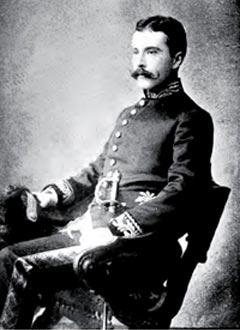
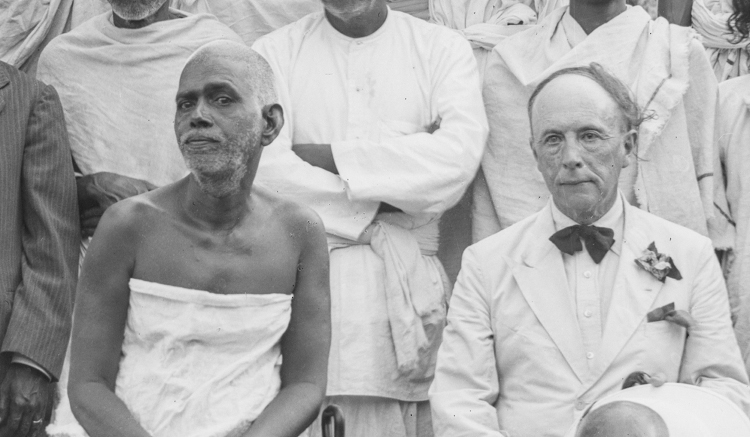
German born American Walter Yeeling Evans-Wentz (1878 – 1965) pioneered the study of Tibetan Buddhism, mostly known for publishing an early English translation of The Tibetan Book of the Dead in 1927, Tibet’s Great Yogi Milarepa (1928), Tibetan Yoga and Secret Doctrines (1935), and The Tibetan Book of the Great Liberation (1954), visited Ramana Maharshi in 1935. In 1946, he wrote the preface to Yogananda’s well known Autobiography of a Yogi. He stays for two weeks on the ashram in 1935.

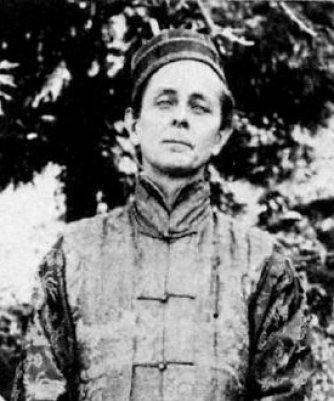

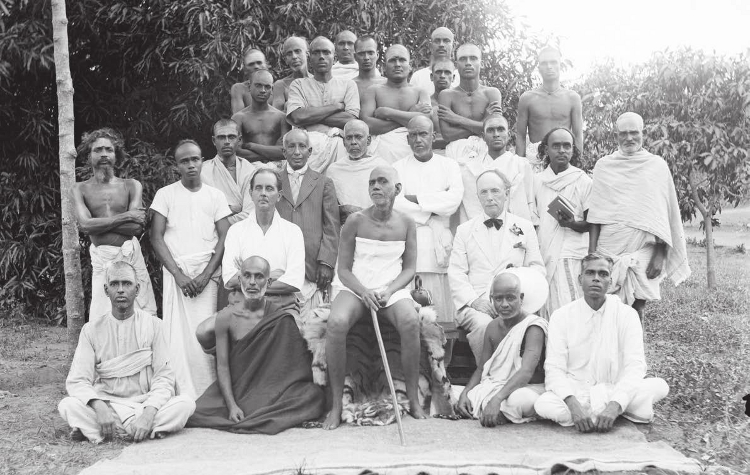
Swami [Chinnaswami]; 2. (in front) Yogi Ramiah; 3. (behind) Dr. W.Y. Evans-Wentz; 4. Bhagavan Sri Ramana Maharshi;
5 (behind) Grant Duff (Douglas Ainslie); 6. (front) Munagala Venkataramiah (compiler of Talks). 7. Sub-registrar
Narayana Iyer; Standing; middle row: 1. Nondi Srinivasa Iyer; 2. Krishnamurti (office attendant); 3. Somasundara
Swami (Book-Depot); 4. K.R.V. Iyer (Calcutta); 5. Sama Iyer; 6. Ganapati Shastri (Head Accountant; Taluk Office); 7.
Vishwanatha Swami; 8. T.K. Sundaresa Iyer; 9. Father of Ranga Rao; Standing; back row: 1. Rangaswami (Attendant);
(behind) & 3. Unidentified; 4. Ramaswami Pillai; 5. Ramakrishnaswami; 6. Subramaniam Swami; 7. Kumaraswami
(Stores); 8. (behind) Ranga Rao (Cook); 9. (in front) Unidentified; 10. Annamalai Swami; 11. Madhava Swami. Photo: The Mountain Path 1994.
American Chemist Dr Bernhard Bey in 1935.
From Talks with Sri Ramana Maharshi 15th October, 1935. Talk 81. Dr. Bernhard Bey, an American Chemist who had interested himself in Vedanta for the last twenty years, now in India, came on a visit to the Master. He asked: “How is abhyasa to be made? I am trying to find the Light.” (He himself explained abhyasa as concentration = one-pointedness of mind.)
The Master asked, what was his abhyasa till now.
The visitor said he concentrated on the nasal base, but his mind wandered.
M.: Is there a mind?
Another devotee gently put in: The mind is only a collection of thoughts.
M.: To whom are the thoughts? If you try to locate the mind, the mind vanishes and the Self alone remains. Being alone, there can be no one-pointedness or otherwise.
D.: It is so difficult to understand this. If something concrete is said, it can be readily grasped. Japa, dhyana, etc., are more concrete.
M.: ‘Who am I?’ is the best japa.
What could be more concrete than the Self? It is within each one’s experience every moment. Why should he try to catch anything outside, leaving out the Self? Let each one try to find out the known Self instead of searching for the unknown something beyond.
D.: Where shall I meditate on the Atman? I mean in which part of the body?
M.: The Self should manifest itself. That is all that is wanted.
A devotee gently added: On the right of the chest, there is the Heart, the seat of the Atman.
Another devotee: The illumination is in that centre when the Self is realised.
M.: Quite so.
D.: How to turn the mind away from the world?
M.: Is there the world? I mean apart from the Self? Does the world say that it exists? It is you who say that there is a world. Find out the Self who says it.
Two American ‘students’ accompanied Paramahansa Yogananda on his return trip to India, Mr. C. Richard Wright, and an elderly lady from Cincinnati, Miss Ettie Bletsch. The entourage visited Ramanasramam in 1935.

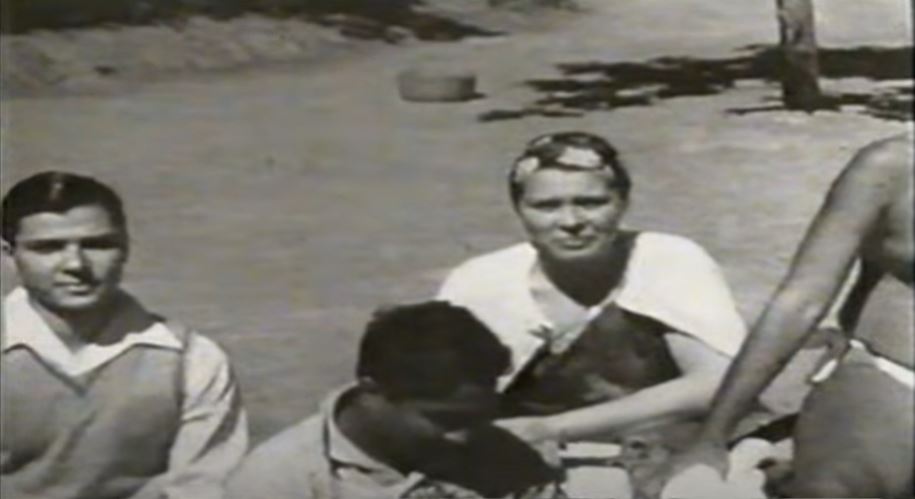
Buddha Bose was born in 1913, in Sri Lanka, while his Indian father and English mother were en route from London to Calcutta. His mother would only stay in India for 5 years before returning to London, leaving young Buddha behind. He grew up in the Garpar area of Calcutta, a block from the Ghosh home where Yogananda and Bishnu lived. Buddha married into the family of Bishnu Ghosh and Yogananda.
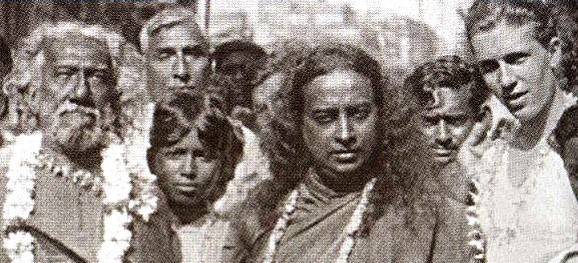
Maurice Frydman (1894 – 1976) came across Brunton’s book A Search in Secret India after moving to Paris sometime in 1928, and eventually arrived in India and the ashram in 1935. He lived in India for decades and was also known as Bharatananda. He was a disciple of Mahatma Gandhi and lived in his ashram, where he made the spinning wheel that Gandhi used. He was close to Nehru, and was associated with Sri Ramana Maharshi and J. Krishnamurti. He was also a long-time friend of Nisargadatta Maharaj, who considered him a Jnani. Frydman edited and translated Nisargadatta Maharaj’s recorded conversations into the 1973 book I Am That. When he died in 1976 in Bombay, India, Nisargadatta was by his bedside. During his last days of life Frydman gets a visit by a professional nurse he does not know. The nurse had been visited in a dream by an old man in a loin cloth telling her to go and take care of Frydman. Frydman refuses to accept the nurse’s offer. As the nurse is leaving she walks past a picture of the old man that had visited her in her dream. Upon telling Frydman this, he accepts her offer and allows her to take care of him. The picture: it was Ramana Maharshi who had left his body over three decades prior. In an article that Maurice wrote very late in his life, he lamented the fact that he didn’t fully appreciate Ramana Maharshi’s teachings and presence while he was alive.
From Death Must Die : Based on the Diaries of Atmananda by Ram Alexander – Maurice Frydman was a Polish engineer who spent most of his life in India. He was in the inner circle of Krishnamurti; however today he is best remembered as the discoverer of Sri Nisargadatta Maharaj (died 1981), a great Maharashtrian jnani who lived in a poor section of Bombay. Frydman thought so highly of him that he learned his dialect and was the editor and translator of a collection of his discourses called I am That. The book attracted many serious seekers, both Indian and foreign, to Sri Nisargadatta in the 1970s.
From Ramana Periya Puranam (Inner Journey of 75 Old Devotees) by V. Ganesan, grand nephew of Sri Ramana Maharshi – Once, I went to Nisargadatta Maharaj´s house because he had asked me to stay with him. I stayed there for eight days. In the morning, from eight to ten, he would ask me to be seated while he did pooja. There were photographs of saints such as Ramakrishna Paramahamsa, the Buddha, Jesus Christ, Ramana Maharshi, and yes, even Maurice Frydman, in his room. Maharaj would apply sandal, vermillion powder and perfume to the photographs and garland them. As he was doing this ritual one day, I was asking myself, “Why is he doing this?” He turned to me and said in a compassionate tone, “Maurice Frydman was a jnani. He was a saint, a sage.”
Author David Godman writes, Maurice Frydman is one of most extraordinary people I’ve ever come across and virtually nothing is known about him. And because of his connection with Ramana Maharshi, Krishnamurti, Gandhi, Nisargadatta, the Dali Lama I kind of view him in my own mind as a Forest Gump of 20th century spirituality. He was in all the right places in all the right times to get the maximum benefit of interaction with some of the greats of Indian spirituality… He was a Gandhian, he worked for the uplift of the poor in India, he worked with Tibetan refugees, he edited extraordinary books [like] “I am That,” probably one of the all time spiritual classics.
This man for me a shining beacon of how devotees could and should be with their teachers. He was just absolutely an extraordinary man. And went out of his way to cover his tracks; to hide what he actually had accomplished in his life. So I’ve enjoyed the detective work of looking in obscure placers, digging out stuff that he personally tried to hide, not because it was embarrassing, but because he didn’t like to take credit for what he’d done. So I see this as an opportunity to wave the Maurice flag and say “look look, this is one of the greatest devotee, sadoc seekers from the West whose been to India in the last 100 years, and I think more people should know about him.”
Dr M. Sadashiva Rao writes, Maurice “Bharatananda” Frydman: The great karma yogi you never heard of…
“We ripen when we refuse to drift, when striving ceaselessly become a way of life, when dispassion born of insight becomes spontaneous. When the search ‘Who Am I?’ becomes the only thing that matters, when we become a mere torch and the flame all important, it will mean that we are ripening fast. We cannot accelerate that ripening, but we can remove the obstacles of fear and greed, indolence and fancy, prejudice and pride.”
You might have come across his name on the cover of the classic giant I Am That. He was the man who tape recorded conversations in the Marathi dialect with Sri Nisargadatta Maharaj and then translated and pushed to publish the book. What you might not know is that he carried out that deed late in his life after five decades of service to India directly and to the world of spiritual seekers at large. The people that he came across and was in deep relationship with included J. Krishnamurti, Sri Ramana Maharshi, Mahatma Gandhi besides Maharaj. Furthermore, he was also involved with the liberation of India from English rule in the state of Aundh by writing the constitution there, as well as being active in the villages of the state. Later on, he spent years pushing the Indian government for and receiving land and money to create the settlements where thousands of uprooted Tibetans escaped the Chinese invasion.
Maurice Frydman was born in the Jewish ghetto of Krakow, Poland in 1894. Being an exceptionally bright student, he excelled in school and studied electrical engineering. He was fluent in Hebrew, English, French, Russian, German and added to that Hindi later in life. His seeking started at a young age and involved delving into Judaism and studying the Talmud. He followed this by becoming a monk in the Russian Orthodox church. This path did not free his thirst and he was said to have been fed up with all dogmas. His brilliance in his school did pave the way for him to drastically change his life from his humble beginning. He had many patents to his name, by the age of twenty when he moved to Europe for his studies and started work.
During this time he came across his first teacher J. Krishnamurti in Switzerland. This meeting was prior to Krishnamurti’s break with the Theosophical Society and the relationship lasted many decades. Maurice was known to be a fierce debater with Krishnamurti whom he held in high regards. He would organize meetings for him as well as translate some of his work into French. After a period of several years, in 1928 he made a more permanent move to Paris to start a job at an electrical factory. In Paris he came across Paul Brunton’s book Conscious Immortality: Conversations with Sri Ramana Maharshi that started a burning desire to go to India.
His wish came true several years later when in 1935 he was offered a job to set up an engineering firm in Mysore, which he accepted. In his early years in India in the late 1930s he found Ramana Maharshi and spent time with the Bhagavan. As one of the regular devotees, many of his questions and the master’s response were recorded in Maharshi’s Gospel. Ramana said of Frydman “He belongs only here to India. Somehow he was born abroad, but has come again here.”
Concurrently he came into relationship with Mahatma Gandhi and was involved with his struggle to free India from British rule. It was during this time in 1938 that he asked the Raja of Aundh province to help Gandhi’s cause by freeing his control of seventy two village properties which the Raja agreed to. He then drew up a draft of declaration of independence which then was given to Gandhi. He in turn wrote the constitution of the state, giving full authority to the people of the state, a rare event in pre-independent India. An interesting side fact is that during his time with Gandhi Frydman worked on and improved the design of the cotton spinning wheels that became synonymous with Gandhi and his movement.
Frydman’s family perished in Poland during WWII and he never returned there after that.
At this juncture in his life he gave up on his job and worldly possessions. He took on the robe of a sannyasi under Sri Swami Ramdas who named him Bharatananda; a robe he later gave up as being meaningless while living the spirit of it to his death. From this time on, he did give up his salary to the needy around him. He had no room for symbols and spiritual materialism that did not reflect true ripeness; he found them to be shallow and counter productive. He regretted his inability to take further use of Ramana Maharshi’s teachings while the Bhagavan was alive. He wrote after Ramana Maharshi’s death, “Now He is still with us, but no longer so easily accessible. To find Him again we must overcome the very obstacles which prevented us from seeing Him as He was – and going with Him where he wanted to take us. It was Tamas and Rajas – fear and desire that stood in the way – the desire for the pleasure of the past and fear of austere responsibility of a higher state of being. It was the same old story – the threshold of maturity of mind and heart which most of refuse to cross.”
Maurice Frydman died in Bombay on March 9th of 1976 with Sri Nisargadatta Maharaj by his side. A beautiful event ends this incredible life. During his last days of life Frydman gets a visit by a professional nurse he does not know. The nurse had been visited in a dream by an old man in a loin cloth telling her to go and take care of Frydman. Frydman refuses to accept the nurse’s offer. As the nurse is leaving she walks past a picture of the old man that had visited her in her dream. Upon telling Frydman this, he accepts her offer and allows her to take care of him. The picture: it was Ramana Maharshi who had left his body over three decades prior.
Frydman helped Wanda Dynowska, a Polish theosophist who came to India in the 1935 and visited Ramanasramam frequently, in 1944 to establish a Polish-Indian Library (Biblioteka Polsko-Indyjska). During the Second World War he helped with the transfer of Polish orphans from Siberia, displaced there by the Soviets after their annexation of Eastern Poland to Siberia in 1939-1941. They were moved from Siberia via Iran (with the Polish army of General Władysław Anders) mainly to India, Kenya and New Zealand. In 1960, after the 1959 Chinese take over of Tibet he helped Wanda Dynowska with Tibetan refugees in India.
https://en.wikipedia.org/wiki/Maurice_Frydman
The Extraordinary Life of Maurice Frydman (Biographical Collection)
Face to Face with Sri Ramana Maharshi Compiled and Edited by Professor Laxmi Narain.
https://www.stillnessspeaks.com/wp-content/uploads/2016/07/Face_to_Face_with_Sri_Ramana_Maharshi.pdf
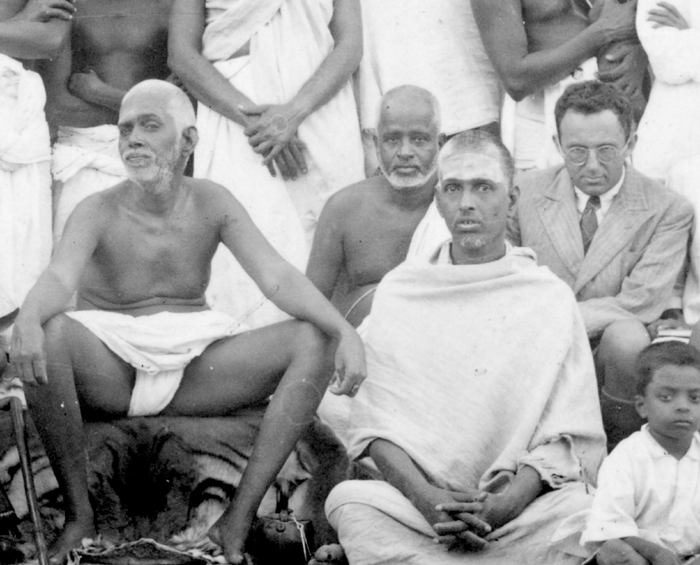


Urgyen Sangharakshita writes about his meeting with Maurice and his wife Hilla – They ran down the slope holding hands, laughing like happy children. The scene was the garden of The Residence, Gangtok, where they were staying as guests of Apa Pant, the political officer with whom I also sometimes stayed. It was my first sight of Maurice and Hilla. We soon became acquainted, and they invited me to visit them at their Bombay home the next time I was in the city. The time must have been the mid-1950s.
Read the full article https://www.sangharakshita.org/articles/some-bombay-friends
Sangharakshita, born Dennis Philip Edward Lingwood (1925 – 2018) was a British spiritual teacher and writer, and the founder of the Friends of the Western Buddhist Order, which in 2010 was renamed the Triratna Buddhist Community.
After reading A Search in Secret India Major Alan Wentworth Chadwick O.B.E. (19 March 1890 – 17 April 1962) who was in the British army serving in WW1 and afterwards living in South America, arrived in Sri Ramanasramam on November 1st 1935, and remained there for the rest of his life, becoming the first European devotee to live permanently at the ashram. He established himself at the heart of the ashram in a way no other Westerner could ever repeat. He was one of the few who had a relaxed relationship with Ramana. His cottage was like a foreign embassy in the heart of the ashram as he was able to mediate for so many who found at times the ways of the ashram difficult. He became Sadhu Arunachala and is buried in the ashram. He was instrumental in initiating the regular performance of Sri Chakra Puja in the Mathrubhuteswara Temple and helped start a Veda Patasala in the Ashram. He translated all the original works of Sri Ramana into English and wrote the book A Sadhu’s Reminiscences of Ramana Maharshi (1961).
Major Chadwick writes: In the early days of my stay (1935-36), I was living in a big room adjoining the Ashram storeroom. Here Bhagavan often used to visit me. On coming into my room unexpectedly he would tell me not to disturb myself but to go on with whatever I was occupied at the time. I would remain seated, carrying on with whatever I was doing at the time. I realize now that this was looked upon as terrible disrespect by the Indian devotees, but it had its reward. If one put oneself out for Bhagavan or appeared in any way disturbed he just would not come in future; he would disturb no body, so considerate was he. But if one carried on with what one was doing then he would himself take a seat and talk quite naturally without the formality, which usually surrounded him in the hall. I had no idea how lucky I was and how privileged, but certainly appreciated the visits. A Sadhu S Reminiscences of Ramana Maharshi, p.23.
Face to Face with Sri Ramana Maharshi Compiled and Edited by Professor Laxmi Narain.
https://selfdefinition.org/ramana/Ramana-Maharshi-Day-by-Day-with-Bhagavan.pdf
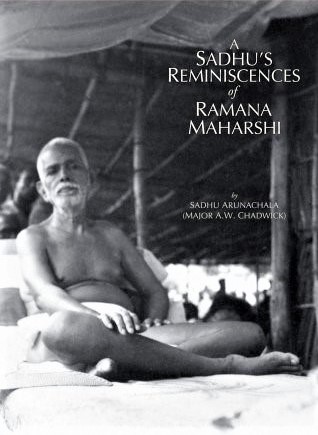
Download: https://archive.org/details/asadhusreminiscencesbychadwicka.w.sadhuarunachala_202004_466_K




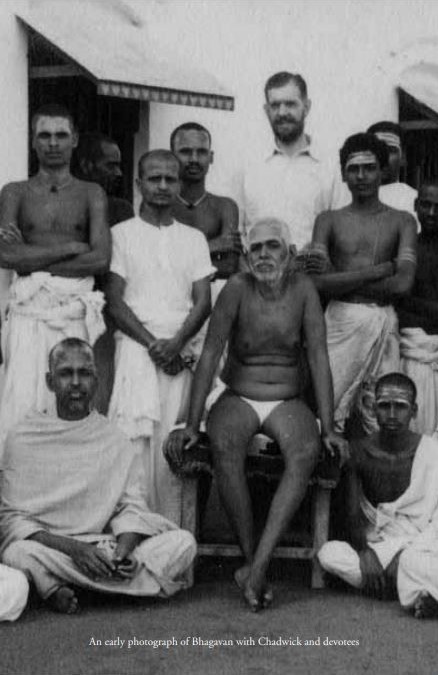





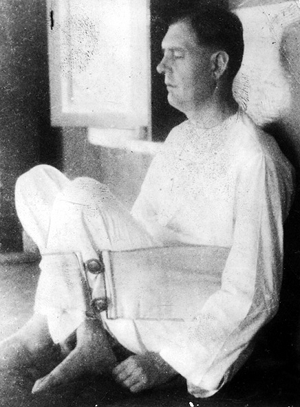
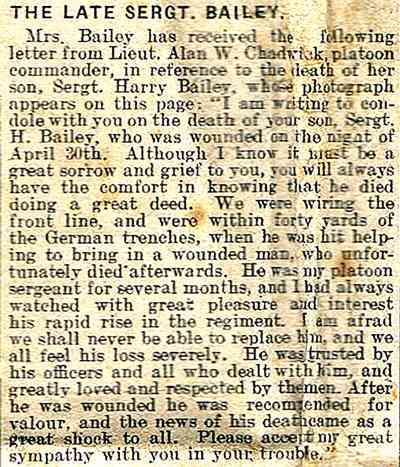
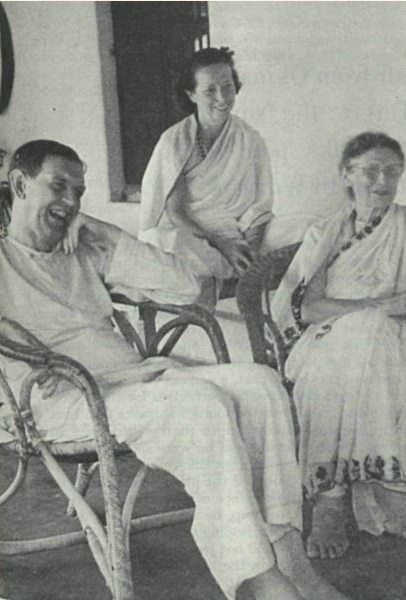
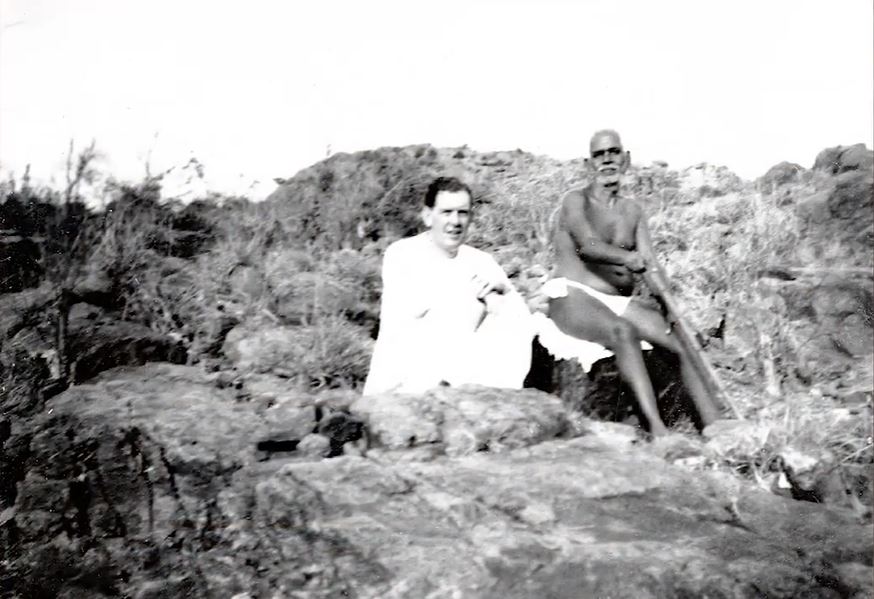

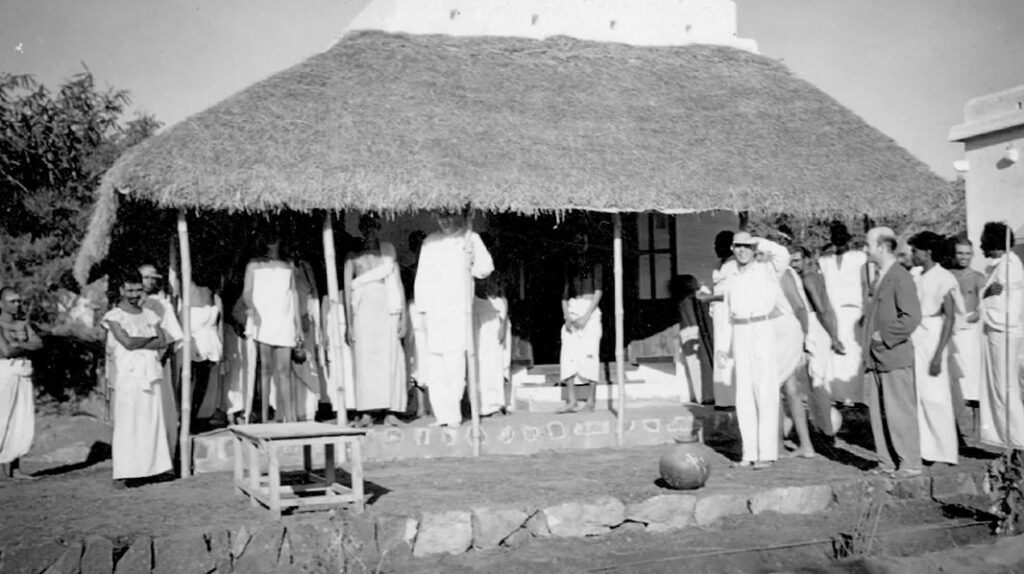
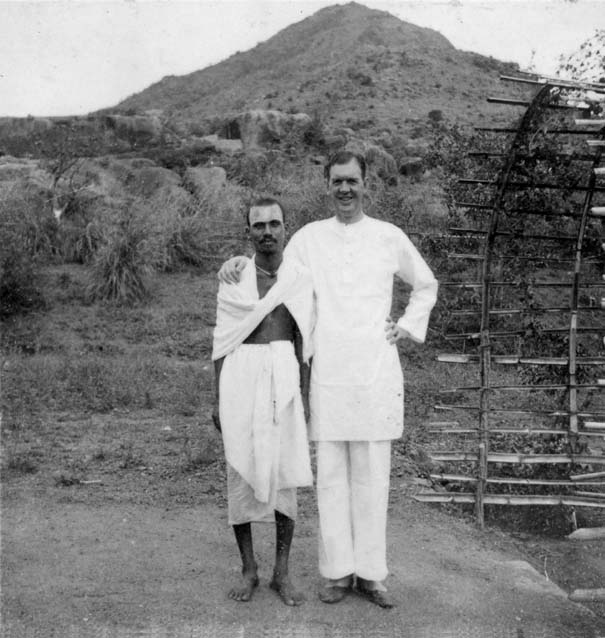
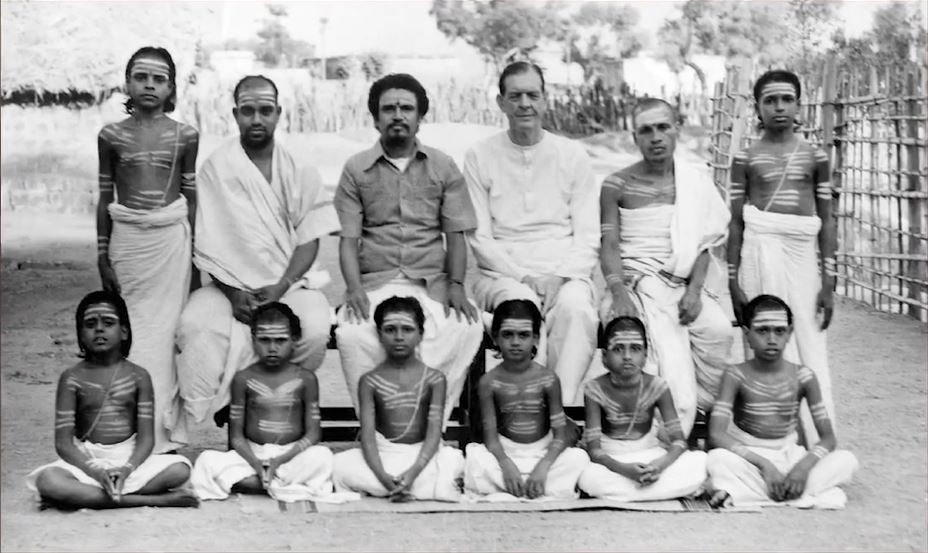
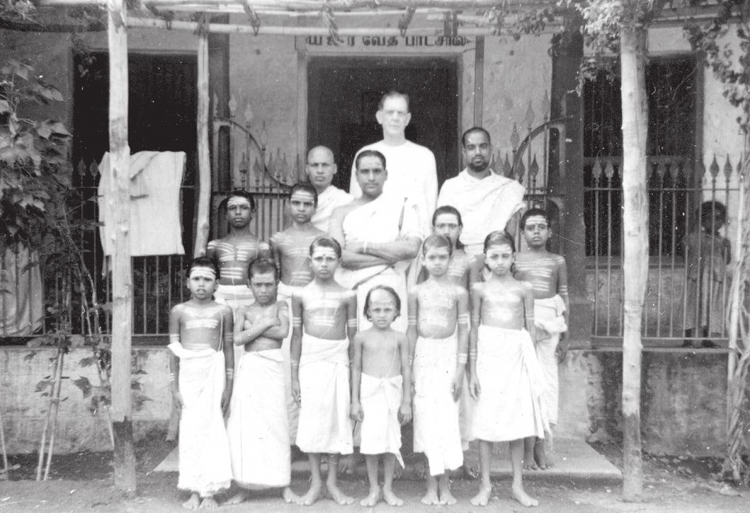

taught to chant the Vedas.
The Ashram Vedic School was established in 1934 for the regular instruction in the Krishna Yajur Veda with students performing daily recitation of the Vedas in the hall. Prior to this, pundits from town had come each day for morning and evening recitations and would chant before Bhagavan who, it is said, would sit bolt upright each time they began. Among the group from the school in town was a senior student, Sri Krishna Ghanapatigal, who was selected in the presence of Sri Bhagavan as the first Ashram Veda Patasala teacher, and who in time proved instrumental for the steady growth of the newly formed Ashram school. After Bhagavan’s Mahanirvana, the school closed temporarily for lack of funds and it seemed that the chanting of the Vedas, which had become such a regular part of Ashram life, might come to an end simply because there was no one to carry it on. In 1953 the Ashram Managing Committee authorised Major Chadwick to solicit funds to revive the school and to initiate the Sri Chakra puja in the Mother’s Shrine. Under Chadwick’s stewardship, funds were raised and, five days after the Sri Chakra puja was inaugurated in March, 1953, the Ashram school was reopened.
In the 1970s the school again suffered from lack of funds and students, and appeals were made for support. Finally thanks to Sri Vaidyanatha Ganapatigal of Mysore, the school was revitalised. In 1980, after 40 years of service, Sri Krishna Ganapatigal retired and was succeeded by Sri T.S. Ramaswamy Ghanapatigal. Today, under the guidance of Sri Sentilnatha Ghanapatigal, the school enjoys a vitality, enthusiasm and regular influx of students unknown since the Patasala’s inception nearly 80 years ago (2013) https://archive.arunachala.org/sri-ramanasramam/veda-patasala
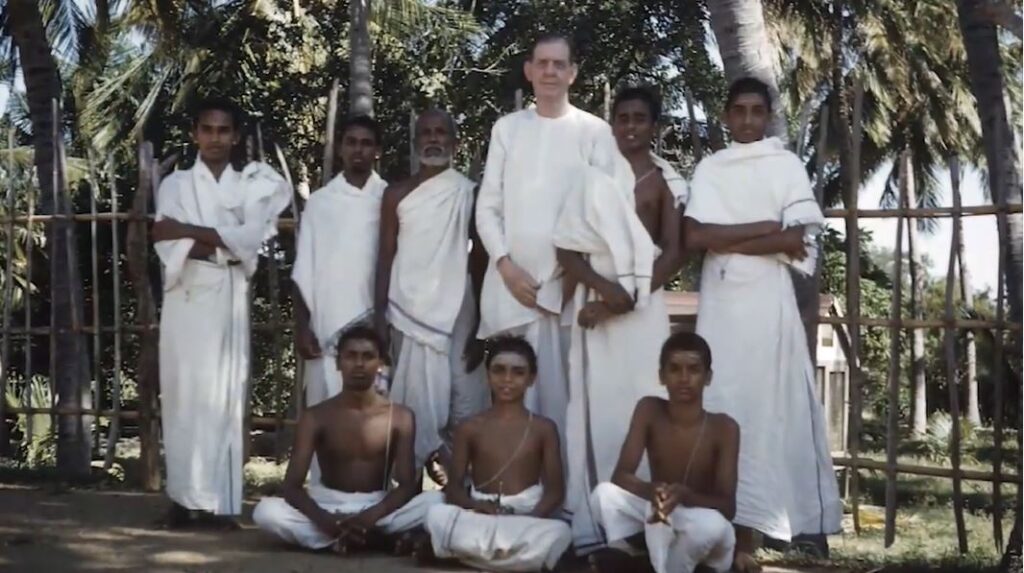


VS Mani recalls his time with Major Chadwick. Excerpt from Sri Ramana Maharshi – JNANI : The Silent Sage of Arunachala.
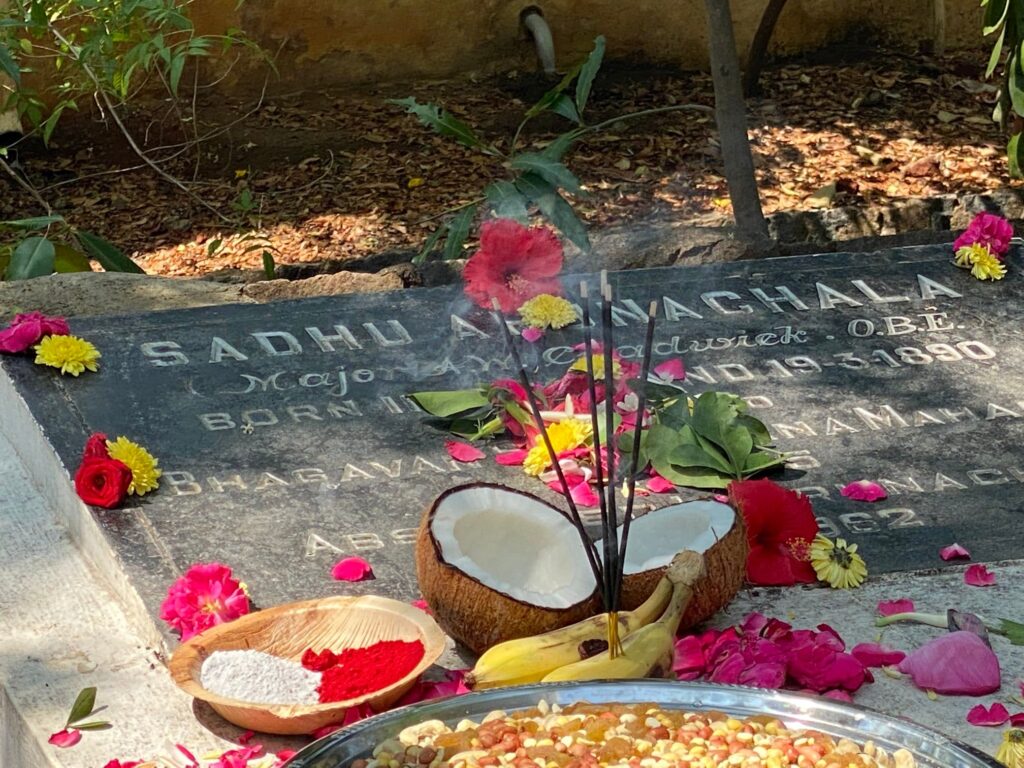


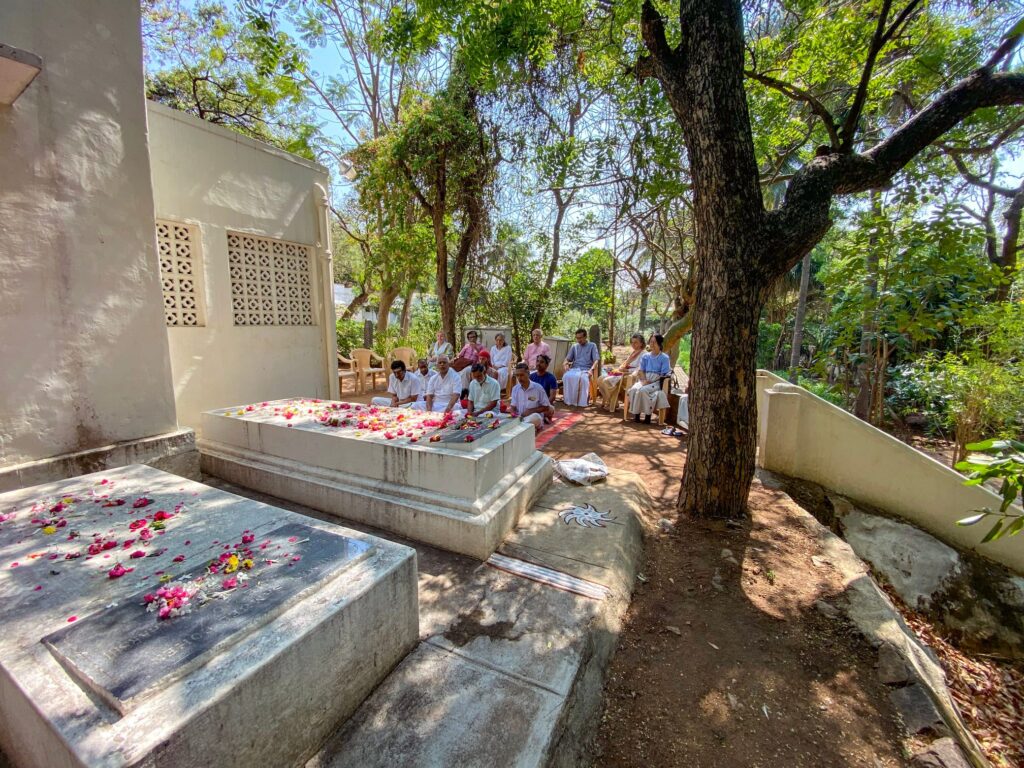
Major Chadwick and The Razor’s Edge
From Tracing the Pilgrim Life of Ella Maillart Part II by Michael Highburger (The Mountain Path April 2019) – In the course of conversations with Ella on the veranda of his hut in Ramanasramam, Major Chadwick narrated the account of Somerset Maugham’s scandalous visit to Sri Ramanasramam in 1938:
“Somerset Maugham ran away from Pondicherry, he hated it so much. He came here with Mrs. Austin, had lunch in front of Olaf’s hut with beer and gin – what a horror! Chadwick sent everybody away to avoid a scandal. Then Somerset Maugham asked to lie down. Chadwick sent Grant Duff away from his room and (went to tell) Bhagavan that Somerset Maugham (was not in a position to) come to the Hall. So Bhagavan came (to Chadwick’s hut) and sat opposite Somerset Maugham for half an hour. At the end of it Maugham said: “Do I need to say something?” “No, silence is a good thing,” Bhagavan said. (Bhagavan then added:) “I ought to go back (to the Hall). They will be waiting for me.”
Maugham had not made a great showing and Chadwick was unhappy with him. But Maugham seems to have been awestruck by Chadwick. In a letter to her mother in Switzerland, Ella writes: “Chadwick had impressed Somerset Maugham because he looked so perfectly happy. Do you remember, I must have told you that I had lunch with Somerset Maugham at his daughter’s place just before he left for India; he was certain that Europe had run off the track somehow
and he wanted to see something of the ageless wisdom of India.
Neither Chadwick nor Ella realised that Maugham, despite having behaved inappropriately at the time, had in fact been deeply taken by his experience of Bhagavan. Indeed, when his bestseller was published in 1944, anyone who had ever visited Ramanasramam would have easily recognised the spiritual master Sri Ganesha as based on Bhagavan. Few, however, would have been able to identify Major Chadwick as the principal subject on whom Maugham’s iconic character Larry Darrell was modelled. Both Larry and Chadwick were from good families, both had been wounded in the First World War, both had lost a close friend in battle, and at the end of the war, both gave up promising careers in order to travel to India to seek the transcendental meaning of life.
Though unimpressive during his visit, Maugham had presciently diagnosed the spirit of the times and landed on the emerging archetype of twentieth-century Europe. His character matched not only the life of Major Chadwick but that of Guy Hague, Lewis Thompson, Paul Brunton, S.S. Cohen, Maurice Frydman, Ethyl Merston, Grant Duff and countless others who, like Ella, had come to live with Sri Ramana long before the appearance of The Razor’s Edge. Ironically, as Ella and Chadwick joked about Maugham on Chadwick’s veranda at Ramanasramam, Maugham was publicly validating their vocation and making them into unwitting heroes through the character of Larry.
Hans-Hasso Ludolf Martin von Veltheim-Ostrau in December 1935. From November 11, 1935 to April 19, 1936, Veltheim traveled to India where he also visited Swami Sivananda, whose business expansion and personality cult he later criticized. Through Annie Besant he became close to theosophy, especially to Jiddu Krishnamurti, who she temporarily postulated as a world saviour and who stayed in Ostrau for a week in 1931. Later encounters with him and other Indian gurus such as Ramana Maharshi influenced his spiritual development.
From Talks with Sri Ramana Maharshi 23rd December, 1935. Talk 114. Baron Von Veltheim – Ostran, an East German Baron, asked, There should be harmony between knowledge of the Self and knowledge of the world. They must develop side by side. Is it right? Does Maharshi agree?
M.: Yes.
D.: Beyond the intellect and before wisdom dawns there will be pictures of the world passing before one’s consciousness. Is it so?
Sri Bhagavan pointed out the parallel passage in Dakshinamurti stotram to signify that the pictures are like reflections in a mirror; again from the Upanishad – as in the mirror, so in the world of manes, as in the water, so in the world of Gandharvas; as shadow and sunlight in Brahma Loka.
D.: There is spiritual awakening since 1930 all the world over? Does Maharshi agree?
Maharshi said: “The development is according to your sight.”
The Baron again asked if Maharshi would induce a spiritual trance and give him a message – which is unspoken but still understandable.
No answer was made.

English Poet Lewis Thompson arrives in the ashram in approximately 1935 and stayed for 7 years. He is one of the greatest, and least known, mystical writers of the twentieth century. Born in London in 1909, he became a wanderer in his early twenties. He left England and never returned. Travelling through France and Germany, he was haunted by Rimbaud’s vision and by visions of great cities. The London and Paris of Cocteau, Picasso, and Diaghilev in the 1920s made an unforgettable impression on him. At one time he thought of becoming a pianist and was a sensitive interpreter of Bach and Debussy throughout his life.
Thompson lived in India for the last sixteen years of his life and was, for several years the librarian at the Rajghat school in Benares. He lived with Hindu simplicity, indifferent to the British Raj and its lifestyle, and devoted himself completely to an exhilarating, agonising, and profound spiritual search that took him to ashrams all over India. Andrew Harvey writes in 1998, “For a while he had a guru in South India, Sri Atmananda Krishna Menon, but a terrible quarrel separated them; later he was to write very savage things about the guru system.”
From Death Must Die – Lewis Thompson was closely associated for a number of years with Sri Krishna Menon, a highly respected South Indian master of Advaita Vedanta – the ancient Upanishadic philosophy of nonduality, as defined particularly by Adi Shankaracharya (788 – 820)? It seems that Thompson, in the outspokenness of his passionate philosophical disputations with his teacher, had overstepped a certain line of fundamental etiquette and respect in his relationship with him. This rift was exacerbated by the jealousy of some of the other followers and ultimately the Guru asked him to leave.
Thompson neglected his health and died suddenly in Benares, four years after his arrival there, of sunstroke in 1949, at the age of forty, before he had time to prepare his recently completed work for publication. A collection of his aphorisms, Mirror to the Light, which was edited and published in 1948; a great majority of his unique poetry remains unpublished.
In his brief lifetime, he accomplished what almost no other writer of his or any other time has been able to do: to gather the disparate elements of the chaotic literary inheritance of the West and to somehow seamlessly integrate them with the deepest and most purifying spiritual realities of the East.
Thompson arrived on the ashram in approximately 1935 and stayed for 7 years. His life and work stand as a radically progressive regeneration of what it means to be an artist – in his case a poet – by refining the literary traditions of the West into a deeply immersed practice and understanding of the spiritual traditions of the East. He was in every sense the consummate writer. He was also a genuine sadhu, a wandering spiritual renunciate of the first order.
When Thompson arrived at the Rajghat school in Benares, Austrian Blanca Schlamm (Atmananda), as the only other foreigner, was asked to look after him. The newcomer was seriously in search of truth. When he had not found spiritual guidance in Europe, he came to Ceylon, thereafter he spent seven years with Ramana Maharshi in Tiruvannamalai. Otherwise, too, he had met many great spiritual personalities of that time, even those who were not easily accessible and known only to insiders.
Atmananda stressed that he had a sharp intellect, was highly analytical and radically pushed aside everything that he felt was not genuine. When Atmananda talked about him it was sensed that she liked him.
Thompson had come to Benares because of Anandamayi Ma. She was staying in Sarnath, some distance from Benares, where Buddha gave his first sermon after enlightenment. Thompson wanted to be back in the evening and did not show up for three days. He had not taken any change of clothes and in the school had been a case of cholera. Atmananda concluded that he must be sick. She bought medicine and went to Sarnath. There she found Thompson hale and hearty and completely enraptured by Anandamayi Ma. “She surpasses my highest expectations. It is incredible, how profound her answers are” he gushed.
Atmananda gave her diaries to Ram Alexander, who had come to India as a young man in the early 1970s. The diaries are now published as Death Must Die. Anandamayi Ma offered Ram the chance to live in her ashram in Kankhal, a privilege rarely granted to a foreigner. He stayed in Ma’s ashram for about 10 years. Thereafter, he married and settled in Assisi, Italy.
Atmananda felt that Ram was Lewis Thompson reborn. That was the reason why she wanted him to have her diaries, and publish them if he thought they would be helpful to others. Ram did not disappoint her, and got them published under the title, Death Must Die. His foreword shows literary flair, but unlike Thompson, in this life he does not live in penury.
Atmananda’s diaries have by now become a sort of underground bestseller. The book is often see with foreigners. It fascinates, because it is very authentic. Source: Sri Ramanasramam, Andrew Harvey, and Maria Wirth.


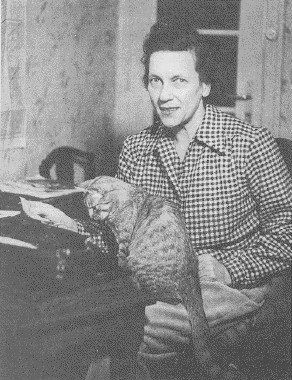
The picture is taken from the book ‘Ti-Puss by Ella Maillart.
Do as the cat! During her stay in South India (1939 – 1945), Ella Maillart was taught by two masters of wisdom, Ramana Maharishi and Atmananda (Krishna Menon). Far removed from a war-torn Europe, she leads a quasi-ascetic life and examines herself in her mirror: A tiger cat whom she baptizes ‘Ti-Puss. The remarkable animal reveals to the traveller that there is audacity in wanting to live life in the present, in searching for the meaning of existence in one’s everyday pursuits and circumstances. It is ‘Ti-Puss who encourages the author to apply the spiritual lessons to the material world. “Because a cat,” says Ella Maillart, “knows how to live the fullness of the present moment.” Written in English. W. Heinemann, London, 1951.
Polish writer Wanda Dynowska (Uma Devi) (Tenzin Chordon) lived in India from 1935 until her death in Mysore in 1971, often visited the ashram.
Wanda Dynowska came to India in 1935 on a soul-searching mission. Born to Catholic parents of Polish nobility in St. Petersburg, Russia in 1888, Wanda was drawn to the Bhagavad Gita, the Koran and other spiritual books at a young age. This drew her to Theosophy and particularly to Annie Besant.
While in India she stayed at the headquarters of the Theosophical Society in Adyar and made frequent trips to Ramana Maharshi’s ashram.
She was a bridge between Poland and India exchanging the richness of their cultures with publications and translations of over 100 books, including the Bhagavad Gita, the teachings of Ramana Maharishi, which attracted many Poles to come to the ashram.
She became a close associate of Mahatma Gandhi who christened her with an Indian name of “Uma Devi.” She raised resources for Polish refugees through the local Maharajas, and set up schools for them imparting Montessori education.
In 1944, together with another Polish visitor to Ramanasramam, Maurice Frydman, she founded the Indian-Polish Library in Madras, which became for more than thirty years a major editorial body for Polish translations of main Hindu religious texts as well as for contemporary Indian poetry and literature.
She was a spiritual seeker donning many hats. She went to north India to study Kashmir Saivism, with Swami Lakshmanjoo in the Ishwar Ashram, a distinctly variant school from that of Tamil Shaivism.
Her meeting with the the Dalai Lama, in 1956, was a turning point in her life, and drew her to a new Path. The Dalai Lama rechristened Uma Devi as Tenzin Chordon after she started to embrace Buddhism.
From 1960, she with the help of Maurice Frydman started helping Tibetan refugees in India. Living in their main centre in Dharmasala, Dynowska organised schools, education, and social infrastructure there. Additionally, she published Polish translations of Buddhist texts. She later settled down in the town of Bylakuppe near Mysore, the largest settlement of Tibetan refugees. The settlement is larger than that of Dharamshala. When her end came in 1971, she requested a Catholic burial, and her tombstone is a glaring memory of her unsung epitaph:
“Here lies a Universal Soul – a Polish Theosophist – Born a Catholic, embraced Hinduism and settled for a service in practical Buddhist altruism. She left behind a footprint which was deeply etched in the sands of time”
This East European Yogi was indeed an epitome of Light and Compassion. She opened the doors of Inner Light in both India and her native Poland.
Face to Face with Sri Ramana Maharshi Compiled and Edited by Professor Laxmi Narain.
https://www.stillnessspeaks.com/wp-content/uploads/2016/07/Face_to_Face_with_Sri_Ramana_Maharshi.pdf

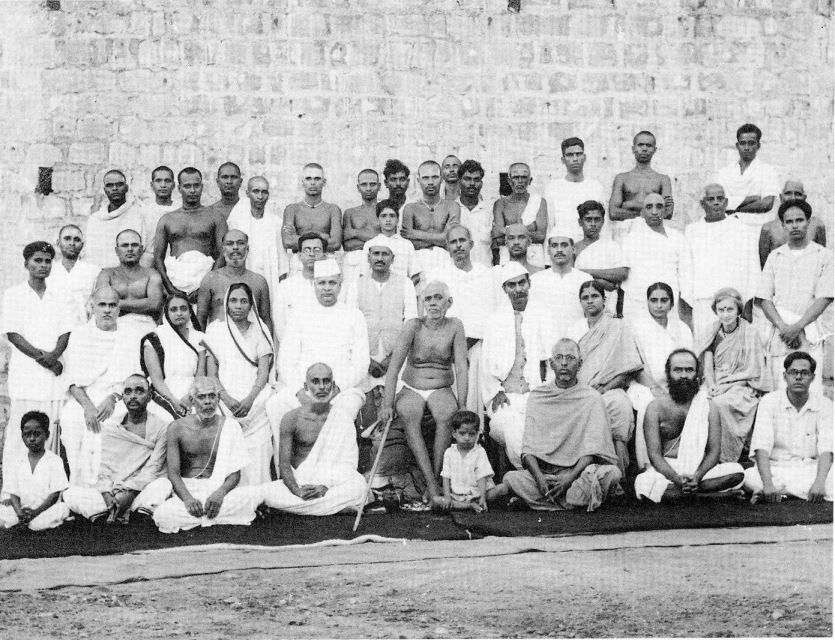

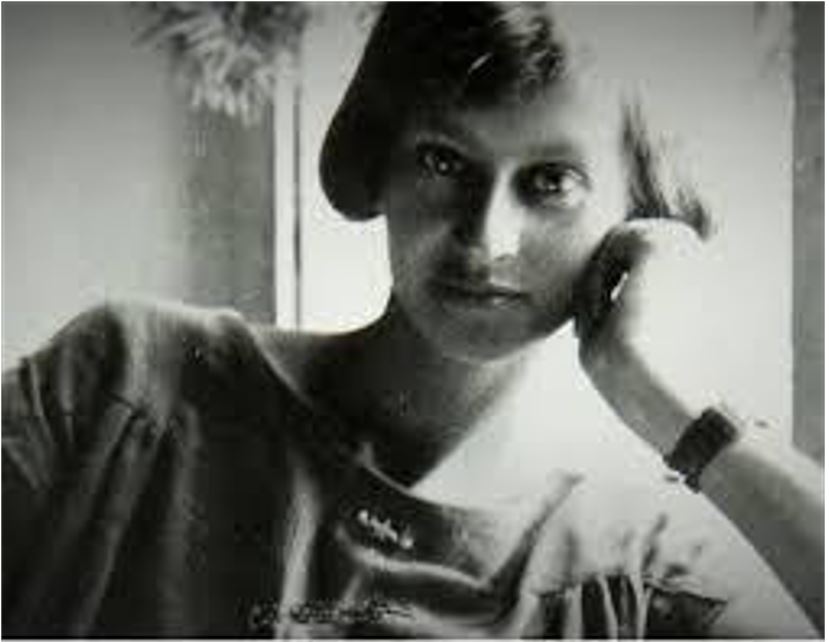
American Dr Henry Hand in 1936,
From Talks with Sri Ramana Maharshi 2nd March, 1936. Talk 174. Dr. Hand, the American gentleman, asked: Are there two methods for finding the source of the ego?
M.: There are no two sources and no two methods. There is only one source and only one method.
D.: What is the difference between meditation and enquiry into the Self?
M.: Meditation is possible only if the ego be kept up. There is the ego and the object meditated upon. The method is indirect. Whereas the Self is only one. Seeking the ego, i.e., its source, ego disappears. What is left over is the Self. This method is the direct one.
D.: Then what am I to do?
M.: To hold on to the Self.
D.: How?
M.: Even now you are the Self. But you are confounding this consciousness (or ego) with the absolute consciousness. This false identification is due to ignorance. Ignorance disappears along with the ego. Killing the ego is the only thing to accomplish. Realisation is already there. No attempt is needed to attain realisation. For it is nothing external, nothing new. It is always and everywhere here and now too.
American birth control advocate Margaret Sanger visited the ashram in January 1936.
Margaret Higgins Sanger (born Margaret Louise Higgins; September 14, 1879 – September 6, 1966), also known as Margaret Sanger Slee, was an American birth control activist, sex educator, writer, and nurse. Sanger popularized the term “birth control,” opened the first birth control clinic in the United States, and established organizations that evolved into the Planned Parenthood Federation of America.
Sanger and How Martyn left Bombay on December 25, 1935, to attend the AIWC meeting in Trivandrum on December 28, “the famous day for which I came to India.” The opening ceremony was held at the New Hall, decorated with “a ceiling of white linen stretched beneath the roof, from which hung ropes and lanterns of white jasmine and crimson roses.” Sanger greeted the AIWC on behalf of the international birth control movement, wishing the women of India “success in their efforts to establish political, social, economic and biological rights for the joyful health of mothers in the new world of tomorrow.” After the AIWC, Sanger spent a week in Madras, giving speeches and attending meetings, then took two days to visit Paul Brunton, whose book on Indian mysticism, A Search in Secret India (London, 1934), had intrigued her.
She arrived January 10, 1936.
From The Selected Papers of Margaret Sanger, Volume 4: Round the World for Birth by Margaret Sanger;
About nine am P.B. called on his bicycle & I in a “tonga” & he on his cycle went to see Maharshi or Sri Ramana Maharshi or the Sage of Arunachala the one time Hermit of the Hill of the Holy Beacon & one of the last of Hindustan’s race of noble Rishees.
As we trotted along behind the horse in the tonga through a thickly settled village or town we passed the Pogoda Temple & always the Beacon Hill loomed up at every turn. The Secty was in the tonga with met & as we stopped at the market for a few plantins (bananas) as a gift for the Maharshi we could see the same colouring & hear the constant chattering of men women & babies, while always far & near is the rumbling of the bullock carts & the shrieking “[hay?]” of the driver shouting to people to get out of the way. At last we got to the ashram at the foot of the hill which is according to ancient lore the heart centre of the God Shiva a holy place & the spiritual pivot of the world. As we alighted, the Secty took the plantins in his hands but no sooner had he turned to help me out of the tonga than a temple monkey leapt from a near by tree, grabbed two bananas & as quick as a flash had the skins off & gobbled them down & with no concern whatever of his conduct looked around for another “grab.”
The ashram at last, shoes & sandals left outside & the Secty went ahead in case the Maharshi was elert to my arrival. He was, he was reading the morning paper but looked up quickly & asked who it was I heard the Secty say Mrs Sanger & the Maharshi repeated Mrs Margaret Sanger? The Secty said Yes I bowed & took my seat on the floor near the door way, crossed my legs & feet under my dress & looked about me to get & feel & sense the atmosphere. The Maharshi went on reading his paper. There was a book shelf & table revolving kind near his couch. He was seated cross legged on a couch about 1 1/2 feet from the floor.
It was covered with a silk cover pillows behind him & a leopard skin thrown over the foot of the couch. He sat reading, evidentially the news of his birthday celebration. Over two thousand people had assembled the day before Jan 9. to celebrate his 56th birthday at the [space left blank] of the moon.
The Maharshi’s face was one of character, peace & suffering transmuted into joy.
He has battled with the Self & subdued it. He has thought through dogmas & cults & brought himself through to Principle, upon which all his answers are based to questions his devotees put to him. He sits unconcerned at the prostration of the Self of hundreds of men, women & children who bow & fall full length, spread hands above their heads on the floor before him. Head touches the floor three times. They arise & take a place in the ashram to sit & meditate as long as they like. Only when children, babies, are made to lie flat before him, does he smile, sceptically I thot. Also when a small boy about three or four came in alone & said part of a prayer in Tamlino but forgot the rest did the Maharshi look amused in understanding, but for the rest he was unconcerned. A small char coal fire & incense burned beside him & attendants saw to it that it burned throughout the day. At first it was nicely quiet, then some women began to sing. These songs are Sacred hymns & are sung in a pitched tone much through the nose & head doubtless good for the pineal gland & may exercise it. The men chant aloud & then someone plays a stringed instrument, but the Maharshi pays no attention to it all. His eyes are open, his body relaxed, his fan held straight there he sits apart from it all. The hundred people in the ashram are left over from the birthday celebration. So there is more confusion & chatter than usual. I got into a silence full of lightness for a while, but the women’s voices in Song brought me out of it.
We sat until noon when P.B. took me to his hut for lunch. He cooked it himself a very nice one of Cauliflower, millet curry beans, potatoes, pineapple oranges & grated cocoanut. We went back to the ashram about three thirty & I asked two questions “Does knowledge cause morality or immorality” “are we made immoral by outside factors or forces.”
Also “Is continence the only means allowed married people to control the size of the family.”
There was much stir at the first question & as the questions had to be interpreted the answer came back “What is birth?” “When we find the cause of birth we can control it.”
I insisted that I had said nothing about control of birth at all, but morality. So then the answer was that It was not the question of morals at all but of desire. This seemed to please all present, including myself. Then the next question was replied to by “of course” meaning that Continence was the only means allowed or morally sanctioned. I came back to expostulate & tried to bring the fact of mothers & infants loss in death & the waste of life in trying to impose this method on the masses. Much talk & silence. The interpreter seemed to impose his own ideas and we could do nothing but take them. Later on when we were assembled in the yard several men alive & alert came & told me he had not correctly interpreted the Maharshi’s answers. So I’ll try again. We all sat around on the floor in the dining hall & had our supper on a banana leaf as a plate. This time we the Westerners had spoons. This leaf is folded up & each one clears his own place neatly & the leaf is thrown in the garbage pile hands are washed & back I came in a tonga drawn by a white bullock. The moon was full & the drive back was full of colour & peace, but not quiet as the driver shouted himself hoarse at other drivers who all go higgly piggly this way & that through the streets. The parade of people with torches carrying goods to the temple was on!
From Margaret Sanger An Autobiography (1938) she writes;
I had determined to take advantage of Paul Brunton’s offer and visit Sri Ramana Maharshi, the sage of Arunachala, the quondam Hermit of the Hill of the Holy Beacon, and one of the last of Hindustan’s race of noble rishis. Consequently, one evening a little after six, the train came around the bend and I beheld the sacred mountain, according to ancient lore the heart centre of the god Siva and, therefore, of the world. I knew it must be the mountain even without being told so. The sun had just set, and the afterglow gave a lovely, serene effect.
The Maharshi’s secretary, Shastri, met me, and we walked through the gathering dusk to the guest house about a half-mile away, a simple room with veranda in front. Paul Brunton had not been able to come because it was the Maharshi’s birthday and thousands of devotees had to be fed. Shastri was very loquacious, and wanted me to realize that the apparent success I was having was only with the educated classes; the masses knew nothing of it. This, I said, would come in time.
After breakfast I looked out at the great tamarind trees on the lawn, up and down which monkeys ran. Often twenty, from babies up to grandparents, were in sight all at once. The windows had to be barricaded at night to shut them out of your room; they especially loved bananas but did not disdain cakes of soap.
While I was watching them scamper about, Paul Brunton pedalled up on a bicycle accompanied by a tonga for me. The driver cried out continually, “Haiee! Haiee!” which seemed to mean both for people to get out of the road and for the white bullock to move faster; he shouted himself hoarse at other drivers, who went higgledy-piggledy this way and that through the streets. We stopped at the market for a few bananas as a gift for the Maharshi; he preferred food to flowers, because this he could give away. Then we trotted along through the thickly settled village, always hearing far and near the rumbling of the carts and the screeching of the drivers, “Haiee! Haiee!”
At last we reached the ashram at the bottom of the Hill. Shastri gathered up the bananas in his hands, but no sooner had he turned to help me out of the tonga than a temple monkey leaped from a neighbouring tree, snatched two of them, and as quick as a flash had the skins off and had gobbled them down with no concern whatsoever as to the ethics of his conduct. Instead, he peered around for another grab.
Shoes and sandals were left outside the ashram, and Shastri went ahead to announce my arrival. I bowed in the entrance and took my place on the floor just within, crossed my legs under my skirt, and looked about me to feel and sense the atmosphere. The Maharshi, naked save for a loin cloth, was sitting cross-legged on a silk-covered couch, pillows behind him and a leopard skin thrown over the foot. A small charcoal fire and incense, which attendants kept burning all day, sweetened and made heavy the air. The Maharshi’s luminous eyes were fixed in a trance, although sometimes his fan lifted a bit and his stare widened.
At first it was nicely quiet; then some women began to sing in a high-pitched tone, much through the nose and head, doubtless good for the pineal gland, once supposed to be the seat of the soul. The men chanted aloud and someone played a stringed instrument.
Towards eleven the Maharshi shared his gifts among those who sat in reflection, and shortly afterwards a man from Kashmir, six feet tall and massively built, entered, prostrated himself as hundreds had done already, falling full length, hands outspread above him on the floor, touching his brow three times. As he rose again his whole body shook, tears streamed down his cheeks. To see women cry from excess of emotion did not bother me, but when a man of such a type as this, in no sense a weakling, went into paroxysms of ecstasy, it was beyond my comprehension. With no critical intent, but curious to know why he had been so moved, we asked what had happened to him.
“When I came into the Maharshi’s presence it was as though electricity had passed through my body. I felt when I bowed I would be calmed, yet when I looked into those eyes, he was like a flame.”
This pilgrim had come with financial problems, illness in his family, and other troubles, but two or three hours of contemplation had wiped them out; he knew they were insignificant and trivial in contrast to his regeneration. In faith, the people in the ashram were comparable to those who cast away their crutches at some miracle-working shrine, except that they had come for inner illumination rather than healing for bodily ailments. They visited the Maharshi to receive the radiance of his soul, just as we sought the sun to be warmed.
Only when children or babies were made to prostrate themselves did the Maharshi smile, somewhat sceptically it seemed to me. He appeared amused when a boy of three or four began a prayer in Tamil but forgot the rest. Otherwise he remained apart from it all. He was gradually withdrawing himself and letting go material things. He wanted spiritually to fade away, leaving the shell behind.
The second day the Maharshi slept; nothing save an occasional singer broke into the hush, or a monkey had the temerity to dash in and seize an orange.
For the third day I attended the ashram. Now the meditation was like a linking up of mind and emotion, where even breathing was stilled. I could understand why the yogis went into the silence. Even the noises next door, the clatter of dishes, sounded remote and very far away. It was a state of consciousness rather like that which precedes sleep.
I regretted that I did not feel the Maharshi’s power. His utter indifference – sitting all day in a semi-trance, engaging in no activity – seemed to me a waste. Nevertheless, I was most grateful to Paul Brunton for the experience, and understood the Indians better thereafter. They saw within and beyond the external appearance; this was at the very basis of their character, akin to the sensitivity of the grapevine telegraph. All people in the Orient spoke of it. Something happened to you or to me and before you could get to another place by the fastest conveyance it was known. Perhaps it was a primitive function of mind, this form of thought transference, but it existed there.
Margaret Sanger (1879 – 1966) – Through her work as a nurse in New York’s Lower East Side in 1912, she worked hard to improve birth control practice to prevent unwanted pregnancies. This groundbreaking shift in attitude led to the foundation of the American Birth Control League. Sanger is credited with playing a leading role in the acceptance of contraception.



Women and the New Race by Margaret Sanger (1920).
Margaret Sanger wrote this book in 1920 at the high water mark of the first wave of feminism. Women in the United States could now vote, own property, acquire higher education, and many other rights won through hard struggle. Sanger saw a woman’s right to control her own body (specifically her reproductive system) as the next big goal. It took more than forty years before a new wave of feminism, along with advances in medical technology, made this attainable.
Of course, this is still the fault-line which runs through the topic of women and religion. The themes which Sanger raises in this book still arouse vehement debate, and pertain to contemporary issues which would have seemed unimaginable to Sanger, such as human cloning and stem-cell research.
Some of the language in this book may mystify or confuse contemporary readers. When she speaks of a ‘New Race’ she means the improvement of the human species in general. She occasionally uses arguments similar to the Eugenics movement (which was later embraced by the Nazis). This has been used as ammunition by some opposed to women’s reproductive rights, and several misleading quotes either taken out of context or completely fabricated have been attributed to her in an attempt to demonize her. This is a disservice and dishonours Sangers’ legacy.
Sanger later denounced the Eugenics movement. Her books were among the first burned by the Nazis. She also personally helped several Jewish women and men escape Nazi Germany. Sanger was about as far from a reactionary as could be imagined–note her opposition to militarism, her ardent feminism and activism on behalf of working-class women, her support for labour and the rights of immigrants, all of which she makes clear in this book. She opened clinics in Harlem to bring health services to the African American community, and worked closely with such African American activists as W.E.B. DuBois and Adam Clayton Powell. In 1966, the year Sanger died, the Rev. Martin Luther King, Jr. said:
There is a striking kinship between our movement and Margaret Sanger’s early efforts. . . . Our sure beginning in the struggle for equality by nonviolent direct action may not have been so resolute without the tradition established by Margaret Sanger and people like her.
Sanger’s opposition to abortion has to be considered in the light of the reality of pre-Roe v. Wade ‘back-alley’ abortion, which often had fatal or harmful side-effects. She states that she would not be opposed to abortion if it could be performed safely.
Sangers’ transcendent (and very spiritual) vision of women and humanity in general free from the shackles of sexual repression and endless child-bearing is impressive, and overwhelms the shortcomings of this book. — jbh
Women and the New Race by Margaret Sanger (1920).
https://www.sacred-texts.com/wmn/wnr/index.htm

From Margaret Sanger An Autobiography (1938).
I had determined to take advantage of Paul Brunton’s offer and visit Sri Ramana Maharshi, the sage of Arunachala, the quondam Hermit of the Hill of the Holy Beacon, and one of the last of Hindustan’s race of noble rishis. Consequently, one evening a little after six, the train came around the bend and I beheld the sacred mountain, according to ancient lore the heart center of the god Siva and, therefore, of the world. I knew it must be the mountain even without being told so. The sun had just set, and the afterglow gave a lovely, serene effect.
The Maharshi’s secretary, Shastri, met me, and we walked through the gathering dusk to the guest house about a half-mile away, a simple room with veranda in front. Paul Brunton had not been able to come because it was the Maharshi’s birthday and thousands of devotees had to be fed. Shastri was very loquacious, and wanted me to realize that the apparent success I was having was only with the educated classes; the masses knew nothing of it. This, I said, would come in time.
After breakfast I looked out at the great tamarind trees on the lawn, up and down which monkeys ran. Often twenty, from babies up to grandparents, were in sight all at once. The windows had to be barricaded at night to shut them out of your room; they especially loved bananas but did not disdain cakes of soap.
While I was watching them scamper about, Paul Brunton pedaled up on a bicycle accompanied by a tonga for me. The driver cried out continually, “Haiee! Haiee!” which seemed to mean both for people to get out of the road and for the white bullock to move faster; he shouted himself hoarse at other drivers, who went higglety-pigglety this way and that through the streets. We stopped at the market for a few bananas as a gift for the Maharshi; he preferred food to flowers, because this he could give away. Then we trotted along through the thickly settled village, always hearing far and near the rumbling of the carts and the screeching of the drivers, “Haiee! Haiee!”
At last we reached the ashram at the bottom of the Hill. Shastri gathered up the bananas in his hands, but no sooner had he turned to help me out of the tonga than a temple monkey leaped from a neighboring tree, snatched two of them, and as quick as a flash had the skins off and had gobbled them down with no concern whatsoever as to the ethics of his conduct. Instead, he peered around for another grab.
Shoes and sandals were left outside the ashram, and Shastri went ahead to announce my arrival. I bowed in the entrance and took my place on the floor just within, crossed my legs under my skirt, and looked about me to feel and sense the atmosphere. The Maharshi, naked save for a loin cloth, was sitting cross-legged on a silk-covered couch, pillows behind him and a leopard skin thrown over 487the foot. A small charcoal fire and incense, which attendants kept burning all day, sweetened and made heavy the air. The Maharshi’s luminous eyes were fixed in a trance, although sometimes his fan lifted a bit and his stare widened.
At first it was nicely quiet; then some women began to sing in a high-pitched tone, much through the nose and head, doubtless good for the pineal gland, once supposed to be the seat of the soul. The men chanted aloud and someone played a stringed instrument.
Towards eleven the Maharshi shared his gifts among those who sat in reflection, and shortly afterwards a man from Kashmir, six feet tall and massively built, entered, prostrated himself as hundreds had done already, falling full length, hands outspread above him on the floor, touching his brow three times. As he rose again his whole body shook, tears streamed down his cheeks. To see women cry from excess of emotion did not bother me, but when a man of such a type as this, in no sense a weakling, went into paroxysms of ecstasy, it was beyond my comprehension. With no critical intent, but curious to know why he had been so moved, we asked what had happened to him.
“When I came into the Maharshi’s presence it was as though electricity had passed through my body. I felt when I bowed I would be calmed, yet when I looked into those eyes, he was like a flame.”
This pilgrim had come with financial problems, illness in his family, and other troubles, but two or three hours of contemplation had wiped them out; he knew they were insignificant and trivial in contrast to his regeneration. In faith, the people in the ashram were comparable to those who cast away their crutches at some miracle-working shrine, except that they had come for inner illumination rather than healing for bodily ailments. They visited the Maharshi to receive the radiance of his soul, just as we sought the sun to be warmed.
Only when children or babies were made to prostrate themselves did the Maharshi smile, somewhat skeptically it seemed to me. He appeared amused when a boy of three or four began a prayer in Tamil but forgot the rest. Otherwise he remained apart from it all. He was gradually withdrawing himself and letting go material 488things. He wanted spiritually to fade away, leaving the shell behind.
The second day the Maharshi slept; nothing save an occasional singer broke into the hush, or a monkey had the temerity to dash in and seize an orange.
For the third day I attended the ashram. Now the meditation was like a linking up of mind and emotion, where even breathing was stilled. I could understand why the yogis went into the silence. Even the noises next door, the clatter of dishes, sounded remote and very far away. It was a state of consciousness rather like that which precedes sleep.
I regretted that I did not feel the Maharshi’s power. His utter indifference—sitting all day in a semi-trance, engaging in no activity—seemed to me a waste. Nevertheless, I was most grateful to Paul Brunton for the experience, and understood the Indians better thereafter. They saw within and beyond the external appearance; this was at the very basis of their character, akin to the sensitivity of the grapevine telegraph. All people in the Orient spoke of it. Something happened to you or to me and before you could get to another place by the fastest conveyance it was known. Perhaps it was a primitive function of mind, this form of thought transference, but it existed there.
Margaret Sanger An Autobiography (1938).
https://www.gutenberg.org/files/56610/56610-h/56610-h.htm

American spiritual writer, author of the spiritual book series Life and Teaching of the Masters of the Far East, Baird T. Spalding (1872 – 1953) with a party of tourists that included the American couple Mr and Mrs Taylor in 1935 or 36.
From Nirvana Expresss by Mick Brown ~ Major Chadwick tells a story of an American couple named the Taylors, who arrived with a party of tourists, who had been persuaded to part with a small fortune to come to India on a peculiar tour, led by a man named Baird Spalding, in search of the mythical group of Masters (Blavatsky, again) who were supposed to live in caves buried deep in the mountains of the Himalayas. When the Masters proved mysteriously reluctant to show themselves, the tour party threatened mutiny, and to placate them, after a visit to the Aurobindo ashram in Pondicherry, Spalding led them to Ramana’s ashram.
It seems that Mrs Taylor became particularly attached to the Maharshi Sitting with him one day, she suddenly burst out: ‘Bhagavan, I want Self-realisation.’ ‘Wait,’ replied Ramana, ‘it will come in due time.’ ‘No,’ she insisted, ‘that’s no good. I want it here and now.’ Ramana said nothing, but gazed into her eyes for five minutes, at which Mrs Taylor burst into tears and fled from the hall. She would never tell anybody what had happened.
From the DeVorss website ~ Baird T. Spalding, whose name became legend in metaphysical circles during the first half of the 20th century, played an important part in introducing to the Western world knowledge of the Masters, who are assisting and guiding the destiny of mankind. Born in England, at age four he went to India. At age seventeen he finished the University and went to California were he stayed two years. He then traveled to Heidelberg, Germany and studied for eight years and then returned to California for post-graduate work in Archaeology at Berkeley and Stanford. After years of working with publisher Douglas DeVorss to write and promote the Life & Teaching series, Spalding died in 1953 in Arizona.

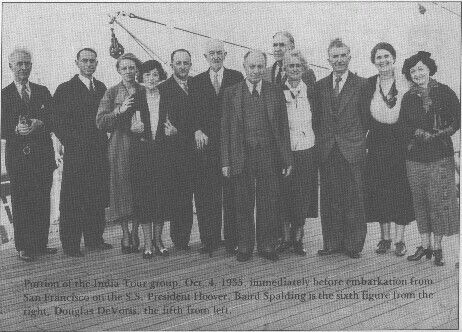


Baird Spalding’s Far East travels in 1894 played a ground-breaking role in introducing to the Western world the knowledge that there are “Masters” assisting and guiding humanity. Handsomely boxed in their own sleeves: the six volumes of Baird T. Spalding’s monumental classic – the work that more than any other has bequeathed the wisdom and knowledge of the immortal masters – assist and guide the heart in every age. Since 1924, when these writings first appeared, they have influenced and inspired generations of seekers. Astonished at the interest in his discoveries and experiences, he wrote Volume 2 (1927). Volume 3 (1935) followed along with a 30-city tour. Volume 4 (1948) and Volume 5 (1955) were compiled from his question-and-answer material and Volume 6 (1996) contains historical reference to his articles for the Mind Magazine 1935-37.
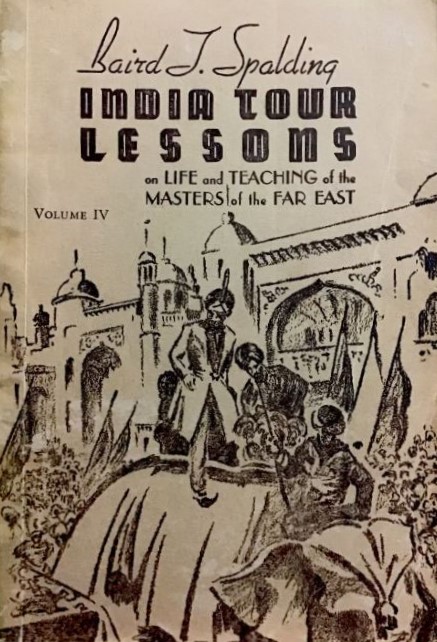
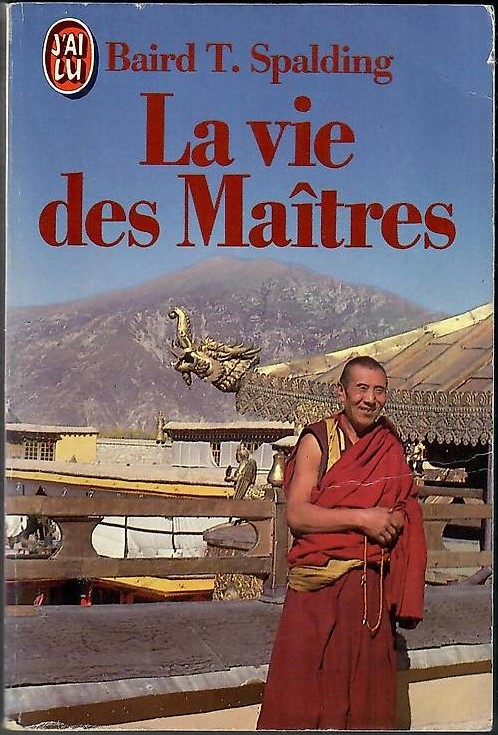
Sulaiman Samuel Cohen was a Jew born in Basra, Iraq, but went to India in his early youth (1927) and settled down for life. He worked in Bombay for a few years as an accountant. He joined the Theosophical Society and lived at its headquarters in Chennai (then Madras) for five years. He was one of the founders of the Association of Hebrew Theosophists. On the 3rd of February 1936, he visited the ashram of Sri Ramana Maharshi and stayed there until the Maharshi’s death in 1950.
He arrived at Sri Ramanasramam with the intention of staying for 14 days. He stayed for 14 years, living in Palakothu, the sadhu’s colony near the ashram, where he built a cottage.
He stayed in Tiruvannamalai for some years after Ramana’s Mahanirvana. later he would retire to a quite life in Vellore where he died in 1980. He is buried in the Korangu Thottam compound of Ramanasramam, he was a realised Jnani.
He authored Guru Ramana, Residual Reminiscences of Ramana, and Reflections on Talks with Sri Ramana Maharshi.
“It was then the Ashram’s custom to honour the newcomer by giving him his first meal in a line directly opposite the Maharshi’s seat. After food, someone announced that the Maharshi was coming to the hall. I rushed there. Behind me calmly walked in the tall, impressive figure of the Maharshi with leisurely though firm steps. I was alone in the hall with him. Joy and peace suffused my being, never before had I such a delightful feeling of purity and well-being at the mere proximity of a man. After a while, I saw him looking at me with large penetrating eyes, rendered divinely soothing by their child-like innocence. I became absorbed in the entrancing personality of this magnificent human magnet – Sri Ramana Bhagavan. It is needless to say that from that day Sri Ramanasramam became my permanent home. I constructed a hut for my residence near the Ashram in March 1936. I hardly stayed in it in the daytime: my mind was wholly fixed on the Master. So I spent my days and a part of my nights in the hall, where the Maharshi lived and slept. There I quietly sat and listened to the visitors’ talks with him and to his answers, which were sometimes translated into English, particularly if the questioner was a foreigner or a North Indian. His answers were fresh and sweet. His influence was all-pervasive in his silence not less than in his speech. To the serious-minded, Bhagavan was a beacon light in an otherwise impenetrable darkness, and a haven of peace.” Guru Ramana, Reflections on Talks with Sri Ramana Maharshi and Residual Reminiscences of Ramana.
Face to Face with Sri Ramana Maharshi Compiled and Edited by Professor Laxmi Narain.
https://www.stillnessspeaks.com/wp-content/uploads/2016/07/Face_to_Face_with_Sri_Ramana_Maharshi.pdf


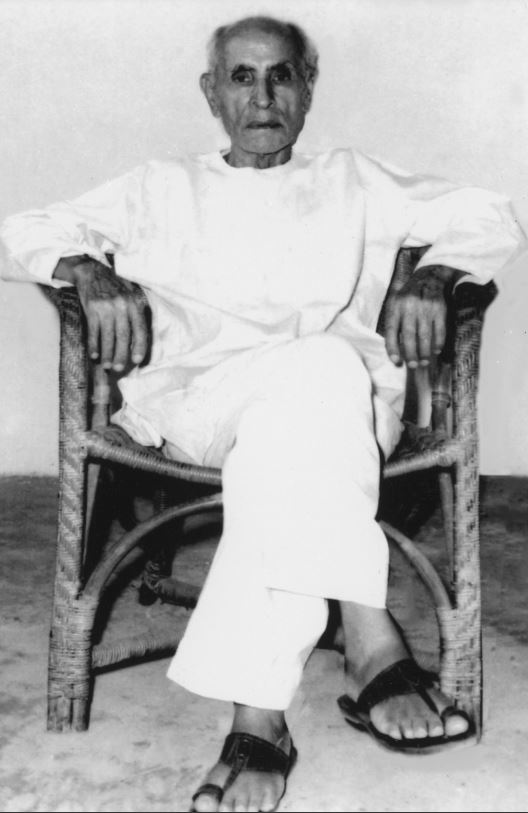
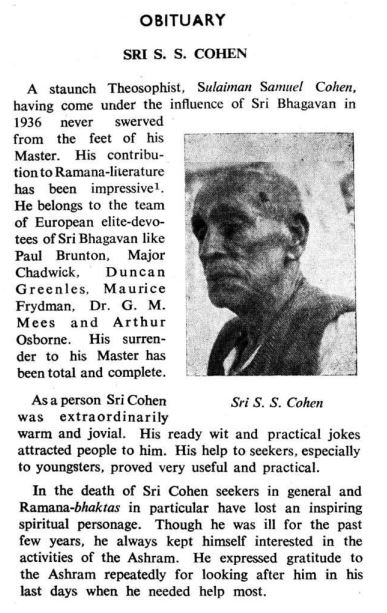
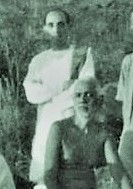

There were some French ladies and gentlemen and American as visitors to the Asramam in January 1936.
From Talks with Sri Ramana Maharshi 5th January, 1936. Talk 128. There were some French ladies and gentlemen and American as visitors to the Asramam. They asked Sri Bhagavan several questions. Among them, one was: “What is the message of the East to the West?”
M.: All go to the same goal.
To another question Sri Bhagavan said: “How do you say ‘I am’? Do you take a light to find yourself? Or did you come to know it on reading books? How?”
The questioner said: “By experience.”
M.: Yes. Experience is the word. Knowledge implies subject and object. But experience is non-terminal, eternal
Dr Gualthernus H. Mees (Sadhu Ekarasa) studied Buddhism, the Sufis and all the major religions and cultures of the world. In 1936 he toured in India and while halting in Bangalore a friend suggested to go and meet “a wonderful living Sage in the nearby town of Tiruvannamalai.” Within twenty-four hours he knew his search was over: he had found his Sat-Guru! He gave up his career, his ambitions, and settled in Tiruvannamalai and later bought a property in Kerala by the sea at Varkala. He travelled constantly between Varkala and Tiruvannamalai until 1954.
Mees was already acquainted with Carl Jung when he met him in Trivandrum, during the renowned psychiatrist’s three-month visit to India from December 1937 to February 1938. They had long discussions about Ramana Maharshi, however, Jung would not be persuaded to visit the Maharshi at the ashram.
He mentored Hildegard Elsberg (1906 – 1997), a German Jew who lived in India for 10 years from 1937, teaching at schools in Kodaikanal – it is not known when she first arrived in the ashram but is thought to be 1937/38.
Face to Face with Sri Ramana Maharshi Compiled and Edited by Professor Laxmi Narain.
https://www.stillnessspeaks.com/wp-content/uploads/2016/07/Face_to_Face_with_Sri_Ramana_Maharshi.pdf
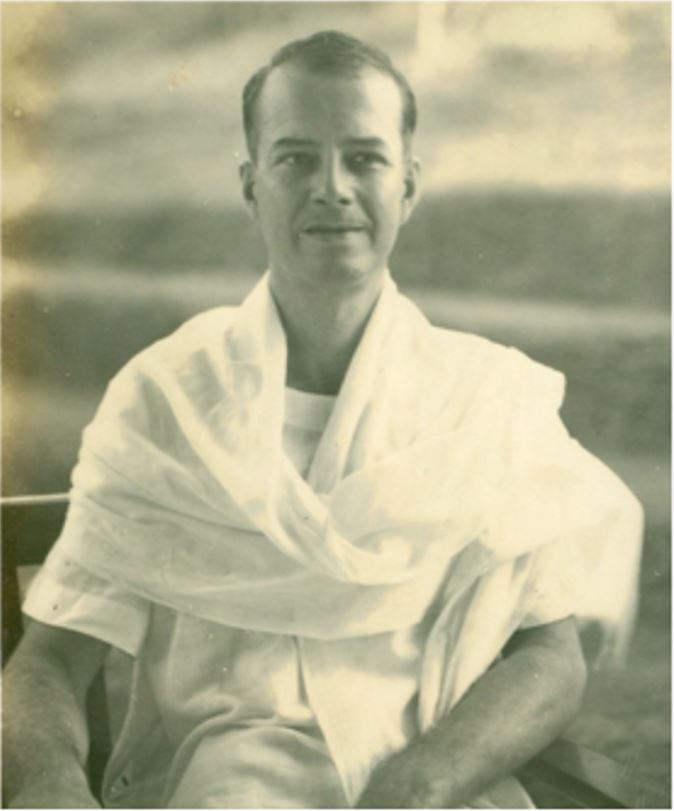


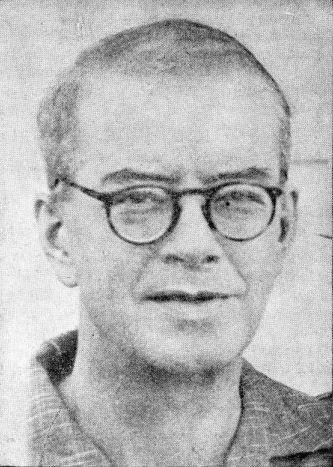
Dr G.H. Mees M.A., Cantab., LL.D., Leyden (The Netherlands) 1903–1955.
Dr G. H. Mees, known in India as Sādhu Ekarasa was born in Rotterdam, Holland on 6 August 1903. He was a scion of private bankers, Con. R. Mees & Zoonen. At 19 he went to Cambridge University at St. John College to study Law and Comparative Law.
The young Mees was especially fascinated by India and its Great Ones. After obtaining his Master’s degree he settled at Leyden University in the Netherlands and worked some eight years on his Ph.D. — an LL.D. thesis Dharma and Society — and in 1935 became Holland’s first sociologist.
Dr Mees found that the root of law was in religion; so he studied Buddhism, the Sufis and all the major religions and cultures of the world. In 1936 as a young man of thirty-three he toured in India in the style of the British Raj, with a huge seven-seater car and a big entourage. While halting in Bangalore a friend suggested to go and meet “a wonderful living Sage in the nearby town of Tiruvannamalai.” He went. It was Bhagavān Śrī Rāmaṇa Mahārṣi.
Within twenty-four hours he knew his search was over: he had found his Sat-Guru! He gave up his career, his ambitions, and settled in Tiruvannamalai at the Feet of Śrī Rāmaṇa, who occasionally called him “Śāstri-swāmī” because of his appearance, and maybe more than that! However Tiru’s hot climate didn’t suit him for year-round residence. He found and bought a property in Travancore, now Kerala by the sea at Varkala. There, “on wings of direct insight”, after long years of inspired association with Śrī Rāmaṇa Mahārṣi, finally the reservoir of vast esoteric knowledge of this erudite servant of Truth imploded toward the Centre. A grand work of transcendental vision was born: The Revelation in the Wilderness (published by Kanvashrama Trust) — an exposition of Traditional Psychology, revealing the meaning of the symbolism in the Tradition of old, and its significance in the wilderness of the mind and the modern world.
Between 1938 and 1954 he travelled constantly between Varkala and Tiruvannamalai. He met many people in Sri Ramanasramam but always kept to himself. He had good friendship with Major A. W. Chadwick (Sadhu Arunachala) and Swami Viswanathan, Arthur Osborn, Mr. Cohen etc. A few written lines were penned down during this period in poems such as, “Tear-drops in my eyes, I offer” and others. He wrote an article for the Ramanasramam Golden Jubilee Souvenir, entitled: “Bhagavan Sri Ramana: God-Reality incarnate”.
He fell severely ill in spring 1954, and on his way by ship to England accompanied by a young Dutch student — Mr J. J. de Reede (Sri Hamsanandan) — lost consciousness and went into coma. His last words were: “What a wonder: Paradise is Here and Now…” He passed away two days later on reaching the shore of England, on 5 June 1955. His Samadhi has been erected there inscribed with a quotation from the Bible: “The Scholar, the Devotee, the Man.” — Romans 7:6.
But we best remember him from these lines:
“If a man were to do the greatest deed in the world, and come and sit in the presence of Bhagavān Śrī Rāmaṇa Mahārṣi, he would realize that his deed was as nothing compared to the perpetual Deed of Self-realization of the Sage.
“If a man were to write the greatest book in the world, and come and lay it as an offering before the Sage, he would realize that the Sage was a greater Book, which is written from day to day, not with the medium of pen and ink and paper, but without intermediation, and even without any conscious effort, in the inner being of all who care to come and read it.”
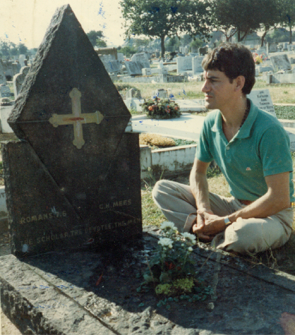
at the Samadhi Dr D. H. Mees (Sadhu Ekarasa).

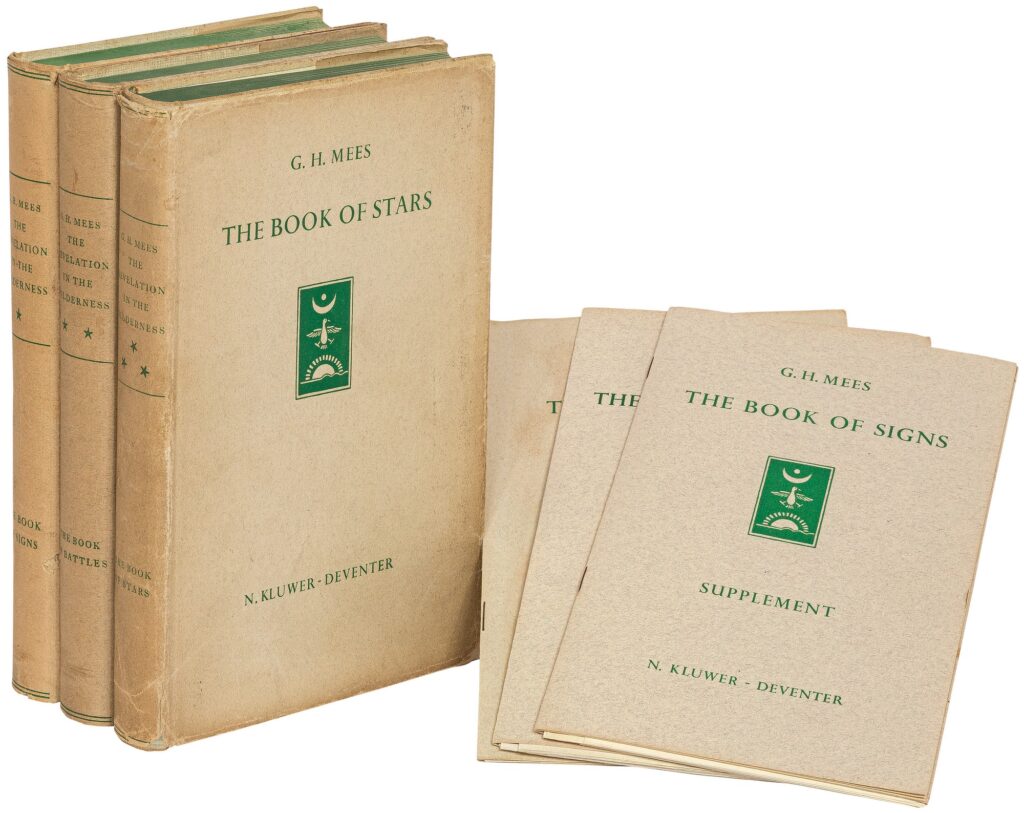
From The Mountain Path October 1975 – Johannes de Reede writes about G. H. Mees’ return to the ashram – He is glad to come back to Tiruvannamalai, to ‘test the near-tangible relationship with the Master. He renews and deepens his friendship, often stormy, with Chadwick, with the early David Mclver and Roda, with the young Swami Viswanathan, with S. S. Cohen with the thin, friendly, ascetic looking Raja Iyer, with Ethel Merston, Ella Maillart and “everybody “. He photographs a lot, more for friends and relations. Many of the famous photos we owe to his “courage,” since, as he said, “one really needs courage to aim at the Guru through a viewfinder.” He is often “surprised that on the negative the figure of Bhagawan does appear.” In 1943, he is allowed to return to the Kanvashrama. There, twenty years of his having absorbed the traditions and religions of the world, a huge reservoir of universal poetic imagination is sparked by that magnetic polarity with the Guru an implosion takes place – a mountain-top view of Comparative Symbolism is experienced and humbly his hand writes about the memory of that “vision,” four years long. It is in this connection that our Muruganar once protested: “Mees was called a Pandit by some, but he was more — he was a rishi.”
The full article;
Since many inmates of Sri Ramanasramam and disciples of Ramana know well Dr G. H. Mees (or Sadhu Ekarasa, under which name he was known after 1943) it may be interesting to note that it is now twenty years and four months since he passed away.
What do we remember? That in 1936, having been offered professorates in Ceylon and in Mysore, and while roaming around in India, comparing these two places with “the rest,” travelling with a big seven-seater tourer accompanied by a driver, a cook, a secretary, a couple of friends and two dogs, one good day back at Mysore, chatting in the company of the then Maharaja and Sir Mirza Ismael, the Dewan, somebody tells him: there is a strange and wonderful man in Tiruvannamalai; a journalist, Brunton, has written a chapter on him.
The then brilliant thirty-three-year-old research scholar, of an ancient patrician Dutch family, who had won acclaim with his new classic Dharma and Society, (which pro- moted him from Leyden University after he had obtained his M.A. at Cambridge) travels to Tiruvannamalai with his entourage, but his ideas about a career come to an end here and give up the ghost then and there. At the feet of Bhagawan he discovers himself in his natural role of devotee and disciple. As a devotee he writes: “the tear-drops of my eyes.” as a disciple: “Two mirrors facing .. and the emptiness between, which is the fullness.” It is because of this that he hardly puts a question to Bhagawan or, if he does, it is on matters of secondary interest “just for the joy of hearing Him speak, see His gracious gestures…” Since “all so-called important questions related to practice (he never speaks of “Sadhana”) or private worries or problems, are solved minutes after I sit down at His Feet.” Later, in Travancore, he experiences that contact “just as strong or stronger, a kind of magnetic bipolarity.”
It was his health that compelled him to settle down in what is now Kerala. Having found a place which is “kindred in spirit” he is not surprised to discover that the place had always been an Ashram, the Kanvashrama, graced by a sacred Vishnu Tirtham (pond) and several wholesome springs, so-called underground Ganges streams. He is leading a less active life, awaiting something.
This “something” is the 1940 war. The British, suspicious of an alien with Congress and Independence sympathies, whose friends. are usually in jail somewhere, extradite him from all coastal areas of India where the Japanese fleets are cruising around! Vague marriage plans evaporate…
He is glad to come back to Tiruvannamalai, to test the near-tangible relationship with the Master. He renews and deepens his friendship, often stormy, with Chadwick, with the early David McIver and Roda, with the young Swami Viswanathan, with S. S. Cohen with the thin, friendly, ascetic looking Raja Iyer, with Ethel Merston, Ella Maillart and “everybody.” He photographs a lot, more for friends and relations. Many of the famous photos we owe to his “courage,” since, as he said, “one really needs courage to aim at the Guru through a viewfinder.” He is often “surprised that on the negative the figure of Bhagawan does appear.” In 1943, he is allowed to return to the Kanvashrama. There, twenty years of his having absorbed the traditions and religions of the world, a huge reservoir of universal poetic imagination is sparked by that magnetic polarity with the Guru an implosion takes place a mountain-top view of Comparative Symbolism, is experienced and humbly his hand writes about the memory of that “vision,” four years long. It is in this connection that our Muruganar once protested : “Mees was called a Pandit by some, but he was more he was a rishi.
Until 1955, he continues to visit Ramanasramam, between stays in Kerala and a last visit to his aging parents in Holland. At the Kanvashrama he is surrounded by his trusted caretaker and a few friends and pupils, one also hailing from Holland, who will accompany him on his last journey to England. To this friend and pupil he confides his last words. Somewhat surprised, he says: “But Heaven… is HERE!” The source of his inspiration having been the living experience of the relationship with the Guru, his pupils have put up a shrine to Sri Dakshinamurti and a guest cottage in Ramananagar dedicated to Ekarasa.
R. Subramanian writes – There is also another person I knew, who like myself, had an indirect connection with Jung and this was a long term Dutch resident of Tiruvannamalai, J.J. de Reede or Hamsa as he was known. His mentor, Dr. Gualthernus Mees was a Dutch sociologist and a friend of Jung. I remember well our first conversation in the early 1980s.
‘You told me that a friend of yours knew Jung very well.’
‘Yes. I was tortured in a POW camp in Java during the Second World War and was brought to the mountain to recover by another Dutch man called Dr. Mees. Jung stayed at Dr. Mees’s house in Trivandrum during his visit to India. Jung kept in touch with Dr. Mees after returning to Europe.’
‘Why do you think Jung did not visit Tiruvannamalai?’
‘Well,… apparently there was a lot of thought that he may have been overcome by Sri Ramana, by His authenticity. You see Jung was a mystic and Sri Ramana was an ‘ordinary man’. Jung was fundamentally a psychological guru and a mystic.’
Curiously Jung is very critical of Sri Ramana in his letter to Dr. Mees. Like Zimmer, Dr. Mees strongly encouraged Jung to visit Sri Ramana, but was probably left surprised and disappointed by Jung’s avoidant behavior. In his letter to Mees, Jung refers to Raman Pillai, who was not disciple of Sri Ramana. It is very uncharacteristic of Jung to get such an important detail wrong but what is worse is that he doesn’t seem to care and just rationalises it by a sweeping generalisation.
Jung not only generalises, which reveals his lack of understanding of the subtleties of Indian spirituality, he repeatedly uses the excuse that Sri Ramana was just the same as any other Indian teacher to explain why he avoided meeting Him.
Hildegard Elsberg was born in Germany. She was active as a gymnast in Loheland during her childhood, she studied languages and performing arts, focusing on the Laban method and modern dance with Kurt Joos. After earning a degree in physical therapy, her understanding of her body and her role in human transformation was profoundly influenced by the intuitive approach to inquiry used in Elsa Gindler’s school.
In 1937, Hildegard Elsberg left Hitler’s Germany for India, where she taught dance and music at Catholic schools in the hill station of Kodaikanal, primarily at the English/Irish Presentation Convent School for Girls, and spent several summers under the tutelage of Ramana Maharshi at his ashram in Tiruvannamalai. Two other schools where she began to also teach from 1939 onwards were the American Missionary and Swedish Missionary schools. She initially stumbled her way through English on her arrival in India. The American school also asked her to teach piano, purely on the strength of having heard her accompany students in dance lessons. This culminated in having 30 students in three different schools outside the convent.
She spent the first two years living by herself in India at the convent, where the Mother Superior had vacated her own room for Hildegard’s use. She was later able to secure two affidavits for her mother and her mother’s friend, who Hildegard refers to as her ‘second mother,’ so both women where able to come to India in 1939. The nuns helped procure a little house for the family in Kodaikanal, with a beautiful garden and a wonderful view down on to the plains 7000 feet below.
On her arrival she heard about Ramana Maharshi and contacted the ashram to ask if she could visit and stay on her vacation, from mid December for two an a half months. Before the outbreak of WW2 she was able to travel throughout India freely, afterwards, she had to submit a travel travel itinerary to the British Authorities. She made her first trip to the ashram before these restrictions where imposed.
She met many interesting people there, but one of them, Dr Gualthernus H. Mees took pity on her and her “absolute ignorance” as she describes it. Mees lived in a little cottage across the road from the ashram, and every day he offered Hildegard private instruction. Hildegard says that it was his original idea to found an academy for comparative religions studies, and for this purpose he had acquired some land which was to become his own ashram. But later he had trouble with the British Authorities because of his Dutch citizenship and they were also somewhat suspicious of him.
In 1947, she emigrated to the United States, where she quickly established a practice that integrated Eastern and Western principles of spiritual self-awareness through the body. Over the next several decades, she taught alongside Alan Watts, cooperated with Fritz Kunkel at her Institute in Los Angeles, and worked with Jungians such as Helen Luke and Robert Johnson and with the Guild for Psychological Studies.
Elsberg’s extraordinarily pure, powerful, and insightful mystical poetry has only been published in very limited private editions; the vast majority of it was written during a decade of near-total isolation from the world (1975-85) and has the solid authority of true spiritual solitude. Elsberg wrote about herself: “My life is a sacred path to which I pay a natural reverence. I was born with the genes of introspection… and strangely life or God has answered me in this way. It is a mystery to be born, in the same way.” So it is a mystery to die and between these two mysteries life itself is another mystery, life itself is sacred.” Scource: Andrew Harvey and ‘Oral history interview’ for the United States Holocaust Memorial Museum Collection.

Oral history interview with Hildegard Elsberg Part 1 – June 06, 1996.
Oral history interview with Hildegard Elsberg Part 2 – June 06, 1996. Here she talks of her 10 years in India.

Olivier Lacombe (1904 – 2001) (L’Attache Culturel, Consulat General de France, Calcutta) was a French doctor of philosophy who came for Ramana Maharshi’s darshan in May 1936. While Stationed in Calcutta, looked after the French Comptoirs (settlements) in India (Pondicherry, Karikal, Chandernagor) where Indian opponents of the British presence took refuge, such as Sri Aurobindo whom he met in Pondicherry. It is also the time of a new meeting with Gandhi and of a first contact with Pandit Nehru and his daughter, Indira Gandhi.
He writes in an article The Grandeur of Advaita “The visit I had the honour to pay in May 1936 to Tiruvannamalai was only a short one. It was long enough, anyhow, to impress me with a strong feeling that I had met there, for a few moments, with a genuine Vidvan, an exceptionally true representative of Hindu spirituality. As my souvenirs from this visit have already been published in a French catholic review, Les Etudes Carmelitaines, I shall have to give to the present reflections a more impersonal character.”
He was an honorary professor of the Universities, and emeritus professor of the Sorbonne. He was a member of the Asian Society and the French Society of Philosophy in Paris, as well as the Asian Society of Calcutta; president of the Cercle d’Etudes Jacques et Raïssa Maritain, honorary president of the Catholic Center of French Intellectuals, of the French Association of Friends of the Orient and of the Jacques Maritain International Institute in Rome. Olivier Lacombe was also a member of the Académie Septentrionale.
Face to Face with Sri Ramana Maharshi Compiled and Edited by Professor Laxmi Narain.
https://www.stillnessspeaks.com/wp-content/uploads/2016/07/Face_to_Face_with_Sri_Ramana_Maharshi.pdf
From Talks with Sri Ramana Maharshi 19th May, 1936. Talk 189. Mr. M. Oliver Lacombe, a middle-aged Frenchman who was on a visit to India being delegated by the Institute of Indian Civilisation of the University of Paris, came here from French India. Among others he had desired to meet Maharshi; he came and stayed here about three hours. He had read, in the Sanskrit original, the Bhagavad Gita, the Upanishads and the Sutras with commentaries by Sri Sankara and Ramanuja.
He asked: Is Maharshi’s teaching the same as Sankara’s?
M.: Maharshi’s teaching is only an expression of his own experience and realisation. Others find that it tallies with Sri Sankara’s.
D.: Quite so. Can it be put in other ways to express the same realisation?
M.: A realised person will use his own language. Sri Bhagavan added:
SILENCE is the best language.
D.: What does Maharshi say about hatha yoga or Tantric practices?
M.: Maharshi does not criticise any of the existing methods. All are good for the purification of the mind. Because the purified mind alone is capable of grasping his method and sticking to its practice.
D.: Which is the best of the different yogas, Karma, Jnana, Bhakti or Hatha?
M.: See stanza 10 of “Upadesa Sara.” To remain in the Self amounts to all these in their highest sense.
Maharshi added: In dreamless sleep there is no world, no ego and no unhappiness. But the Self remains. In the waking state there are all these; yet there is the Self. One has only to remove the transitory happenings in order to realise the ever-present beatitude of the Self. Your nature is Bliss. Find that on which all the rest are superimposed and you then remain as the pure Self.
D.: Yes. It amounts to the removal of alien limitations for discovering the ever-present Self. That is what Sankara says. There is no attainment or loss.
M.: Quite so. (Aside) He understands.
D.: How is work to be done ordinarily for an aspirant?
M.: Without self-identification with the actor. For instance, did you intend visiting this place while in Paris?
D.: No!
M.: You see how you are acting without your intention to do so? The Gita says that a man cannot remain without acting. The purpose of one’s birth will be fulfilled whether you will it or not. Let the purpose fulfil itself.
D.: Why are there so many methods mentioned? For instance Sri Ramakrishna says that bhakti is the best means for salvation.
M.: It is according to the standpoint of the aspirant. You have studied the Gita. Sri Krishna said: “There was never a time when I, and you, and these kings were not; nor will they not be in future. That which is unreal never exists. But that which is real never disappears. All that ever was even now is and will ever be.” Again, “I taught this Truth to Aditya; he taught it to Manu; etc.” Arjuna asked: “How can it be? You were born some years back and only recently. How could you have taught Aditya?” Sri Krishna answered; “Yes. We have had several births in the past. I know mine; whereas you do not know yours. I tell you what happened in those past births.”
Look! That Krishna who began saying there was not I, nor were you, nor these kings, says now that he had several births before. Krishna does not contradict Himself, though it looks like it. He conforms to the outlook of Arjuna and speaks to him from his level.
There is a parallel passage in the Bible where Jesus says, “Before Abraham was, I am.” The teachings of the Sages are suited to the time, place, people and other surroundings.
The visitor said he was leaving with regret. …
Maharshi smilingly interrupted, “There is no leaving or returning.” The Frenchman at once said, “He has transcended time and space.” He returned to Pondicherry.
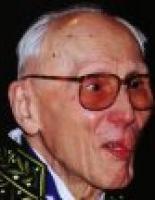

Being a great admirer of Ramana Maharshi, in 1975 Maria Burgi-Kyriazi published an insightful volume Ramana Maharshi et l’experience de l’Etre (Ramana Maharshi and the Experience of Being) in French.
Conversation with Professor Olivier Lacombe, 14th June, 1974, Paris.
Room Conversation with Professor Olivier Lacombe (prabhupadavani.org)
Thomas Richard Duncan Greenlees who stayed for four days in October 1936, would later write that the kind welcome given by the ashram people was his first impression, none of the arrogant and ignorant contempt for foreigners as he had met at times elsewhere, “but rather an eager kindliness and anxiety to make me feel at home in what must be a strange environment.” “Of course, living in the ashram has its strains and stresses. I have known moods of black despondency and disgust, of quick irritation, of what seemed at the moment like disillusionment. When the body’s impurities are stirred up by a fast ready for elimination, there is a time when they seem to rule the body and pains of every kind increase. So, when the mind is to be purged by a great Soul like this Maharshi, many dark things of the past are stirred to life again before they can be expelled. But I must add that those who are in the ashram are very gentle, considerate and kindly when they see us dropping into such a mood.”
Duncan Greenlees was born in Grahamstown, Cape Colony, South Africa, the son of Scottish physician Thomas Duncan Greenlees (of Kilmarnock, Ayrshire) and Edith White Greenlees of Norwich. He had his early education in England. Greenlees received his MA degree in 1922 from Oxford, where he studied Egyptian, Coptic and Arabic. For a brief period during 1925 he was a staff member of Harvard University/Boston Museum of Fine Arts Expedition to Giza in Egypt. On 2 April 1925, Greenlees was appointed Assistant Curator of Egyptian Art at the Boston Museum of Fine Arts. On completion of his studies, he moved to India, working as a schoolteacher (he taught English at Madanpalle High School) and was a headmaster in South India from 1926 onwards. While working in India, he was drawn towards the Theosophical Movement and served in one of the schools which Annie Besant founded.
Being a close associate of Annie Besant, Greenlees like her, was drawn to the Indian independence movement. Later, he became a fervent Gandhian and participated in his non-violent struggle against British rule. When India got independence in 1947, Greenlees was appointed to draft the new nation’s education policy. Gandhi and Greenlees exchanged letters on various topics.
Greenlees retired from active politics after India’s independence and spent his time researching religion and theosophy. From 1949 to 1966, he wrote 14 small ‘World Gospel’ books about various religions and faiths. He died in 1966 at the age of 67.
The Gospel of Islam No.1
The Gospel of China No.2
The Gospel of Hermes No.3 (1949)
The Gospel of the Jesus No.4
The Gospel of Zarathushtra No.5
The Gospel of the Mystic Christ No.6
The Gospel of Narada No.7
The Gospel of Peace : Guru Granth Sahib No.8
The Gospel of the Pyramids No.9
The Gospel of Advaita No.10 (1953)
The Gospel of Israel No.11
The Gospel of the Prophet Mani No.12
The Gospel of the Gnostics No.13
The Gospel of Sri Krishna No.14
He also published The Song of Divine Love (Gita-Govinda) of Sri Jayadeva
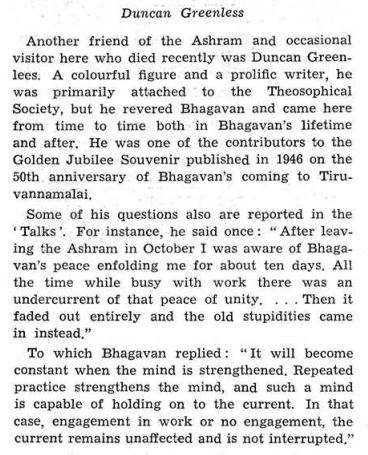
Face to Face with Sri Ramana Maharshi Compiled and Edited by Professor Laxmi Narain.
https://www.stillnessspeaks.com/wp-content/uploads/2016/07/Face_to_Face_with_Sri_Ramana_Maharshi.pdf
WHAT I SAW IN SRI BHAGAVAN by Duncan Greenlees, M.A., (Oxon)
I suppose all men and women, unless plunged too deeply in the mad struggle for unthinking livelihood, have had times when they had to stand still and ask themselves: “Well, what is the meaning of it all? What am I doing in this world at all? And who am I, any way? Where do I come from, and where do I go after this is all over?” They ask, and they receive many answers. The trouble is that the answers are all different, and their confusion is so much the more confounded that most of them have to give it up with a shrug of the shoulders, and turn to more “practical” things with a sigh.
Many can then forget the doubt, or when it next lifts its head they just give it a pat, as it were, and send it obediently to sleep once more. But there are some, the really lucky ones, who do not find it so easy. Their longing, still unsatisfied, will not go to sleep again. It gnaws away at them, and gives them no rest by day or night. At times they even ask themselves why they should put up with the wretchedness of this life unless they can find the real cause and purpose of it all. The dogmas of the creeds, the empty conceit of priest and pundit, the insolent ignorance of pseudo-scientist, alike fail to pacify their need. It grows into an unsleeping restlessness, and drives them till they make a personal enquiry into the Truth.
There are some who call such an individual search for God mere intellectual pride; they tell the seekers to submit to authority and just swallow the theological pills given them by ignorant but well-meaning teachers. But even the most homoeopathic dose of theology or philosophy may upset some spiritual digestions, and they can find no cure that way. The Truth is never found by using somniferent sedatives, and the want remains burning in the seeker’s empty heart.
Yes, this is also personal. It was somewhat like that with me for a number of years. In a sense it still is that way, for the want cannot be satisfied by anything short of the Fullness, and naturally I have not yet made that “my own.” I came out to India more than twenty years ago in the hope and full faith that I would find here in visible form one of those great Masters of spiritual realisation to whom my Theosophy had led me in the inner worlds of thought and feeling. Sent by Dr Beasant and her workers to be a teacher in the school at Madanapalle, I first had there a hint of one direction in which I ought to look.
I remember it was some time in 1926 when we read in the paper of the passing away of a great Saint, known as “Pagal Haranath,” whom they were comparing with Sri Ramakrishna Paramahamsa. One of the College lecturers there told me he had heard of another Saint like that, who lived at Tiruvannamalai, he thought in some temple. Now I had already learned that unclean foreigners like myself were not allowed into temples. (Is it for fear they defile the allpure perfection of God, or that they may not give offerings to the priest? Others must say!). So I was assured that if I went to see this supposed Saint of the Tamil land, I should only be driven away with rudeness and abuse, such as most of us foreigners (for the sins of our countrymen) have to meet with at times unless protected by Government employment. So I left the matter just there. I went on, rather half-heartedly, I must confess, with my own inner search for those Masters who live only in the inner worlds. The search was not wholly unsuccessful. To be honest, I must admit that I was at last convinced, by overwhelming evidences, that they do exist, that they take pupils, that they have vast love and wisdom. But the contact with them was very hard, and only rarely could their grace be won enough to be of much real use in my own daily life. So my discontent remained.
Then, about 1928-1930, came the great mental crisis for most of us Theosophists. J. Krishnamurti proved himself a world teacher indeed, but not in the way we had been encouraged to expect. He taught, certainly, but his teaching clashed with most of that of his precursors. I suppose we all felt much as the disciples of John the Baptist did when Jesus, to whom their own Master had sent them, began attacking the established religion of his people. I could not reconcile these differences. “Serve in a Master’s name and be taken as his pupil,” said one voice, and the other replied, “Masters and Gurus are crutches; you must stand on your own feet, and establish your own goal for yourself.” The first voice retorted, “Try to enter the Path of Initiation, and join the Great White Lodge of world-servers!” But the reply came back, “There is no Path; initiations and spiritual labels and organisations are created by your exploiters; find the Kingdom of Happiness in your own heart.” I could not reconcile these two voices, and I had to choose between them. It does not matter now which I chose. It is enough to say that I am still a keen Theosophist and that I have sat at the feet of our Maharshi. Years passed. There was a political interlude. It was followed by my failure, despite close personal contact with Mahatma Gandhi, to recapture the old discarded ideal of service before self-realisation, as a way to it. And then came nearly two years in the forests of the Central Provinces, with only one human neighbour.
One evening of that time came suddenly a startling experience in full wakefulness. It startled, because it seemed to belie much that our Theosophical books declared about the remoteness of Self-realisation from the lives of us “ordinary men.” I could not deny the experience. It was a flaming reality of bliss, that burned away much of the heaped-up dross in my mind. Nor could I explain it myself, for it should come to only very advanced souls, according to our books. And none knew better than myself how little I could fit into such a category! My one neighbour told me that as the Self is always there, it can be contacted at any moment by anyone, no matter how unworthy he might seem. That would explain the experience, of course, but it seemed too good to be true. I remembered how Krishnamurti had said, “The path can be trodden in a flash even by the savage,” but that too seemed to make nonsense of evolution and to destroy the very basis of rebirth, which had always been for me an established scientific fact. I was left to puzzle it out for myself, in vain. The wheels of time turned round, and in 1935 they brought me back to Madanpalle. There, an old friend told me one day that he thought of visiting the Ashram of Ramana Maharshi, and was willing to take me with him. That re-awakened my desire, which shyness and the fear of rudeness had put to sleep again in 1926. I at once agreed, and it was settled that we should go together in the next holidays, which fell in October 1936. He lent me a copy of Narasimha Swami’s great Life of the Sage. I cannot tell you how that thrilled me. The account of the boy Ramana’s leaving home (I have always loved young folk, and the idea of a child saint has always haunted my mind), of his entranced journey to the unknown Arunachala, of his long and intense absorption in God when he reached that place, just lit something in my heart that has not quite gone out again. God bless the writer of that book! A fever of eagerness grew in me till the holidays commenced. But somehow there was to be a little check in the even flow of events. The same friend advised me to read Paul Brunton’s book. I read it. It repelled me with a sense of the writer’s insincerity. The adulation shown in it to one Saint went very ill with the scoffing criticism of others, and the book struck me somehow as a piece of journalism of the lower kind. I am speaking quite frankly, and apologise to any whom these words may seem to hurt; that is how the book seemed to me personally. For a few days it almost dissuaded me from going to Tiruvannamalai at all. Had the Maharshi stooped to allow this kind of vulgar advertisement of him, almost like a quack doctor seeking testimonials? Of course, I soon threw this foolishness off mind, and went to see for myself.
The kind welcome given by the Ashram people was my first impression. There was none of that arrogant and ignorant contempt for foreigners as such that I had met at times elsewhere, but rather an eager kindliness and anxiety to make me feel at home in what must be a strange environment. I had already an old Theosophical friend living in Pilakottu next door, and it was with him I could speak of my impressions from day to day.
I saw the Maharshi. It did not take long for me to be sure that I was in front of one who had in that very body I could see before me solved life’s problem for himself. The radiant peace around him proved it beyond all cavil. The calm, like that of the midnight sky, was something too real to question for a moment. That part of my search, then, was over, even at the first glimpse. In the flesh I had seen a “Master.”
I told my friend that night that I knew he was what the books call a Jivanmukta. Please don’t ask me how I knew for I cannot answer that. It was just as one knows that water is wet and the sky is blue. It could not be denied,self-evident is the word. But I could not go as far as my friend went in asserting that the Maharshi is God Himself. Of course, in one sense, all are God, as the poem is its creator, but I am not by temperament a worshipper of human forms. God is transcendent as truly as he is immanent in his creation. “With one fragment of Myself…… and I remain,” says the Gita, truly indeed. I had brought the usual list of questions to be asked, of course,philosophical they were, and mostly about rebirth and spiritual evolution. As they were never asked, they do not matter. Shyness kept me silent while sitting in the Hall those first days. And before I broke that silence, the unspoken questions had solved themselves in their own irrelevance. It is a common experience; I only add my own testimony to that of many others.
The four days we had planned were soon over, and my friend went home to Madanapalle. But I could not tear myself away before the last day of the vacation, and stayed on alone, delighted, enthralled and yes, to some degree also pacified. That stillness of eternal deeps had somehow osmosed itself into my heart. The stormy nature I brought into life with me had met a Master who could quell the waves with a silent word, “Peace, be still!” like Him of Galilee. I was brought face to face with the eternal being who had entered and thrown off personalities in an unbroken chain through long ages on the earth. I knew myself to be absolutely one with that incarnate Peace on the sofa, and therefore to be one equally with the Unmanifest in whose stillness he was so obviously poised. “The mind is a wonderful thing!” as Bhagavan once said to one who talked to him in this strain and spoke of dreams and miracles. Before I left that hallowed spot, I did after all put questions to the Maharshi, to solve that problem which had arisen in the forest. He answered it in a wonderful way that was new to me. He defined the real meaning of each word in the question itself, from the standpoint of Advaita. Applying these definitions to the question threw the answer clearly before the mind. I was wholly satisfied, and filled with joy.
God’s grace is such that He gives at His will what He likes to give to any soul. The actual state of the soul then is of little importance, if it be but earnest and sincere in its desire for Him; it cannot earn His grace, even by crores of years of effort. It can never be worthy of His blessing, but receives it purely out of His mercy. His darshan can never be the fruit of sakama tapasya, whatever certain books may say. It is only the overflowing love of the Lord that brings it to us. I now find that Santa Teresa, the great Spanish mystic, says the same in her “Way of Perfection.” God sometimes tries to lure, attract, even “wicked souls” to Him by one or two rare glimpses of His beauty, a sip or two of His loveliness, just to see if they rouse a thirst in the blissful soul to drink deep of that one Fountain of Life and Sweetness, or if they pride themselves on His goodness and think that they are somebody and should henceforth be respected by the world.
This has now come to be a true fundamental of spiritual philosophy in my mind. The day came, and I had to drag the body, like a load, away with me on a dreamlike journey to Madanapalle. But the peace that Bhagavan had put upon me remained in my heart, like a shining cloud of transparency through which all things passed dreamlike for about three weeks. The mind was caught and held in that peace, in a blissfulness it had never known before, while the body went on with its work in English Grammar classes and the like, almost as if unrelated with the Self. It is a pity I cannot bring about this mood at my own will: it can come only from the touch of the real Teacher of souls, as I have found.
I went again, several times. I went for swarming birthday functions. I went when all was quiet, and a single Ashramite was drowsily pulling a pankha over the silent Maharshi, and the only sound the faint hum of summer flies. One whole summer vacation passed there in great happiness, while visitors came and went, and the pet rabbit amused our meditators, and disturbed a few of them, even the most distinguished. There are two incidents of that summer I would like to tell you, for they may be typical, and they have taught me much.
I was sitting one day in the Hall, more or less sleepily browsing in the heat over a notebook of extracts on Yoga. Now Bhagavan hardly ever spoke to me first (indeed there has been very little actual talking between us during the years; it did not seem necessary, somehow), but that day he spoke to me, in English: “What is that book?” I told him. He said quietly, “Read Milarepa.” I got up at once, and asked the friend in charge of the little library if he had a “Milarepa.” He gave me Dr Evans-Wentz’s life of the Tibetan Yogi Saint. I read it, there in the Hall. I read it again. It thrilled and stirred deep places in my heart. Somehow, I feel Bhagavan had seen that it would be so, and therefore gave me the only order of the sort he has ever given me.
There was a young lawyer from North India. He was a passionate lover of the Divine Child of Brindavan, athirst for heart-food and longing for some human soul to worship as a form of the Lord of Love. We slept next to each other under the stars, and talked nightly for hours of Mira and her Divine Spouse. This friend stayed in the Ashram restlessly for about two weeks. Each evening he told me he would go away next day, he had nothing to do with Advaita or with this cold lifeless statue on a sofa. I only told him he had come so far, he should wait a little longer. At last I failed to keep him there any more. He told me he was off that night, to go straight to Brindavan and there merge himself, if he could, in his Giridhari Krishna.
He bought some fruit for his farewell offering. Bhagavan was just going in for supper when this friend came up with his bag of oranges. Bhagavan stood and waited for him. He did not speak. His body was thrilled through and through. He ran and fell on Bhagavan’s feet in a simple ecstasy of love, tears flowing from his eyes. The oranges rolled here and there unnoticed. Bhagavan stood silently. The friend got up with difficulty and stood there trembling.
He could not speak the words of leave-taking. Bhagavan made a little gesture, with a smile and very gently said, “Sari… Po!” I had almost to bundle that friend into his waiting jutka and send him off without a word. He had seen his Lord, in a flash, and he left us in a daze of joy and emotion. I think he never returned to the Ashram, but I have never forgotten that scene. Even now the memory thrills me. Yes, Bhagavan can suddenly appear to us as the Beloved of our heart, even when we have dreamt that he would work such a miracle for us. I have neither space nor time to tell of all the many incidents I have watched in that Ashram. I have taken all the descriptions of the Jivanmukta I could find in any scripture, Hindu, Buddhist, Confucian, Christian, Muslim, Jain etc. I have watched Bhagavan under all kinds of circumstances, and checked up what I have seen with those descriptions. I have not the smallest doubt but that the impression of my first day there is the truth. He alone of all the men I have seen seems to dwell always in Sahaja-samadhi. Of course, I am not qualified to judge, for none but the saint can know the saint. Yet I can only give my word that so it has seemed to me.
I have seen him in a humorous mood; I have seen him play the host with delicate grace that seems almost awkward at times. I have seen him quickly, motionlessly, challenging and defeating injustice or unkindness. I have seen him cutting vegetables for the Ashramites long before the dawn. I have seen again and again how he has solved the doubts, the agonies, the loss of faith, of people of many types, often with a word, often with a movement of healing silence and a soft distance in his unmoving gaze. I have looked at his perfect handwriting in many scripts, all a model of beauty and care. I have heard him correcting the singers of hymns in his own glory, with an absolute impersonality that was obvious. I have watched his reactions to the noisy devotee, the lazy worker, the mischievous monkey, the crazed adorer, the over-bold flatterer, the one who would exploit his name. I have seen how totally impervious he is to all considerations of power, place, prestige, and how his grace shines equally on prince and peasant.
Then, can I doubt that here indeed we have, if not God Himself, for He is omnipresent, at least Greatness incarnate, the majesty of the ancient hills blending with the sweetness of the evening star?
Sit before him, as we used to sit those summer evenings, and as the echo of the Vedic chantings dies away in silence, see the lines of crows fly home in front of that great holy hill of Arunachala. Let the thoughts, worries, aspirations of the mind subside. A blissful glow of transparent unreality creeps across the scene, and you know you are not that foolish excited little person sitting there, but the eternal Self out of whom this world has spun its cobweb yarn of forms.
I know no other man whose mere presence has thus enabled me to make the personality drop down into the abyss of nothingness where it belongs. I have found no other human being who so emanates his grace that it can catch away the ordinary man from his stillness and plunge him deep in the ecstasy of timeless omnipresent being.
I cannot speak much of the method of Atma-vichara that he recommends. No doubt this kind of conscious search is the natural way for many, but frankly I failed to make it my way even after several attempts. But I found no need for the conscious search while in his actual presence. His grace, which is of course the grace of God whose representative and messenger he is, has been enough to give brief glimpses even to me of that Infinity wherein he always seems to live.
He will brush away all this nonsense of my talk with a wave of the hand and a smile, while saying as he once did, “It is the same in this and in another place. That bliss you feel is in the Self, and you superimpose it upon the place or environment in which you are bodily set. It has nothing to do with that.” But, Bhagavan, this book is our kingdom; in it we say what we like about you and the blessings we have received from you; we shall not let you interrupt our foolish words just now. It is our chance to publicly proclaim our debt to the silent Teacher of Tiruvannamalai.
What, then, have I learned from him? That the Self we seek is indeed, as books have said before, the nearest thing to every one of us, that it can therefore be known at once by anyone who cares to look within deeply enough, that every kind of happiness is a reflection of the eternal Bliss which is the very nature of the Self in other and, to Westerners born, more familiar words, that God dwells in our very heart as the Life of our life, the Joy of all our joys, and that if we but devote ourselves to Him He will soon reveal to us His love and hold us to Him for ever in the close embrace of perfect Union.
His message comes in many forms, according to the needs of those who come to him. Once a party of Muslims came. They asked him, “Sir, what is the highest goal of human life?” In one word he gave the whole essence of spiritual truth, the heart of their great religion as of every other. He said, “Islam,” That is the secret of his greatness, perfect simplicity. Islam, selfsurrender to the Supreme Being, whom we delight in knowing and loving as God; Islam alone can bring Salam, or Peace. The only real Peace, which is eternal, infinite, divine, is that which flows in upon, wells up from, floods and floats the soul that throws itself away in loving surrender to the Good Father, from whom and in whom all are, to whom all shall return at last. Statesmen try to build a world at peace in vain while they ignore the only possible foundation for true peace. Volumes could be written as commentary upon that perfect one word answer of his, without adding anything to its beauty and its self-sufficiency. Those Muslims sat for a while before him silently, then saluted deeply and left, satisfied that this was no mere Hindu saint, but a true Prophet of God, one who knows Him and lives always in His presence according to His will.
Of course, living in the Ashram has its strains and stresses. I have known moods of black despondency and disgust, of quick irritation, of what seemed at the moment like disillusionment. When the body’s impurities are stirred up by a fast ready for elimination, there is a time when they seem to rule the body and pains of every kind increase. So when the mind is to be purged by a great Soul like this Maharshi, many dark things of the past are stirred to life again before they can be expelled. But I must add that those who are in the Ashram are very gentle, considerate and kindly when they see us dropping into such a mood. The generous services of one friend who used to translate for me the Tamil answers to my English questions, and get his translations approved by Bhagavan himself before giving them to me, did far more than he dreamed of service to this “foreigner,” as he appears. The kindliness of the Sarvadhikari has also been unfailing in my several visits; no one should forget the help given to his darshan of the Master by the very existence of an efficiently run organisation on the spot, where he can stay, take food, and sleep. For that, we are almost entirely indebted to the work of our Swami Niranjanananda. Even the human hospitality of Bhagavan himself, though sometimes a little embarrassing to my innate shyness perhaps, has always been a delightful thing.
Fifty years! Some have asked him why he does not come out and serve the world. For fifty years he has served the world as not a man whose name is loudly shouted by the crowds can ever dream of serving it. His very presence among us is a benediction. His attaining a clear and unflickering vision of the Self has raised the whole world a little nearer to the truth. His words have been an unfathomed ocean of comfort and inspiration to thousands. His silent peacefulness has revealed the Eternal in human form, as mountains, seas and skies alone can usually reveal It. Would that we all could serve the world as he has done! A French writer has written, “Every soul that uplifts itself uplifts the world,” and the divine Chinese Sage Confucius said the same thing as the Elizabeth Leseur.
Salutations, therefore, to him though he is beyond such childishness, as also to the hallowed place Arunachala! Salutation on this happy Jubilee day to the people of South India, honoured and blessed by his being their companion! Salutation to those who have been wise enough in their day to bask in his grace, unrepelled by the almost frightening non-personality that broods around him!
This is a golden opportunity to come in touch direct with one of our Earth’s greatest children. May it be used by more and more thousands during the coming years! And may some who see this happy Golden Jubilee of his attainment be present to celebrate the centenary in his visible presence at Tiruvannamalai!
1937 Application of Mr T R Duncan Greenlees for the renewal of his Passport to enable him to leave for England. Request to the India Office that the Passport of Mr Greenless should be cancelled and impounded on his arrival in England on account of his undesirable activities in India.
Dr Suzanne Alexandra Curtil Sen, popularly known as Sujata Sen, was a gifted dancer, medical doctor, the first Theravadin Buddhist priestess in eight hundred years, and a feminist! Born in Paris in 1896, at age 18 she joined The Theosophical Society, and went to India in 1925 to attend the annual Theosophical convention at Adyar, where she met Sri Jinawansaswami and soon after became a Buddhist nun. She later met Tromo Geshe Rinpoche in Kalimpong, who had spent years in solitary meditation in the caves of Tromo in Southern Tibet. Dressed inconspicuously as a young Nepali man, she joined a caravan to Lhasa, but fell ill on the way and never reached her destination.
In 1927, Suzanne left her life as a nun to marry an Indian army surgeon, Ranjit Sen, and together they had one child. When the marriage was dissolved, Suzanne resumed her vows. After seeing a newspaper article about Ramana Maharshi she went to Ramanasramam in December 1936 with two other western ladies from Adyar, settling down in Big Street (first at number 58, then later at number 59), Tiruvannamalai, where she ran a desperately needed medical practice in the town. When World War 2 broke out her mother and her daughter Monica came out to India and stayed for a few years. Eventually, in 1945 she decided to leave and to go to Swami Ramdas, who was himself an admirer of Ramana Maharshi. At this traumatic moment of parting, Ramana did not say a single word, but she heard him say “There is no separation. All gurus are one. They are the indwelling self of everyone. I shall ever remain as the Jewel shining in the lotus of your heart.” Almost as soon as she had arrived in Ramdas’s ashram, he willingly gave her the initiation she had craved for so many years but never received from Ramana Maharshi. The atmosphere being much warmer and friendlier with Ramdas, she stayed on for 18 months.
Suzanne and Monica were not present on the last day of the Maharshi’s physical life. But when Suzanne did return to Tiruvannamalai there was a change in her in that she no longer had the desire to find a Master. Through her friendship with the Benedictine monk Swami Abhishiktananda, Suzanne became reconciled also with her original faith, the Roman Catholic religion. The quest for a Master was futile now that she knew the Divine Master reigned in her own heart. The Biographical and Autobiographical book, The Hill of Fire was written by her daughter Monica Bose (Arunachala is also known as the Hill of Fire) and published in 2002.

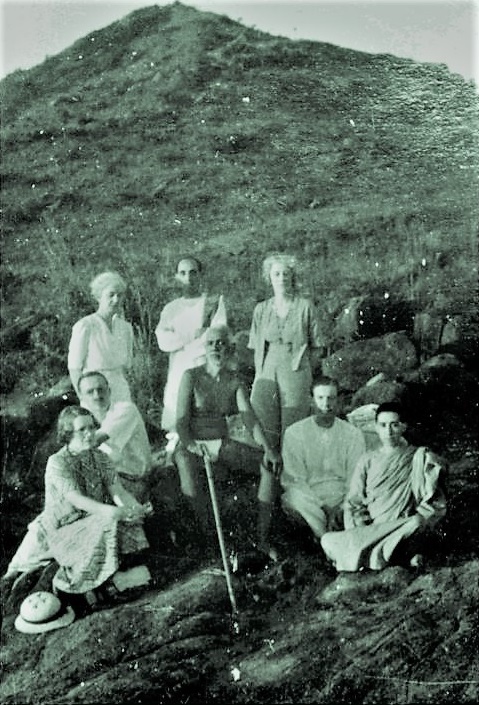


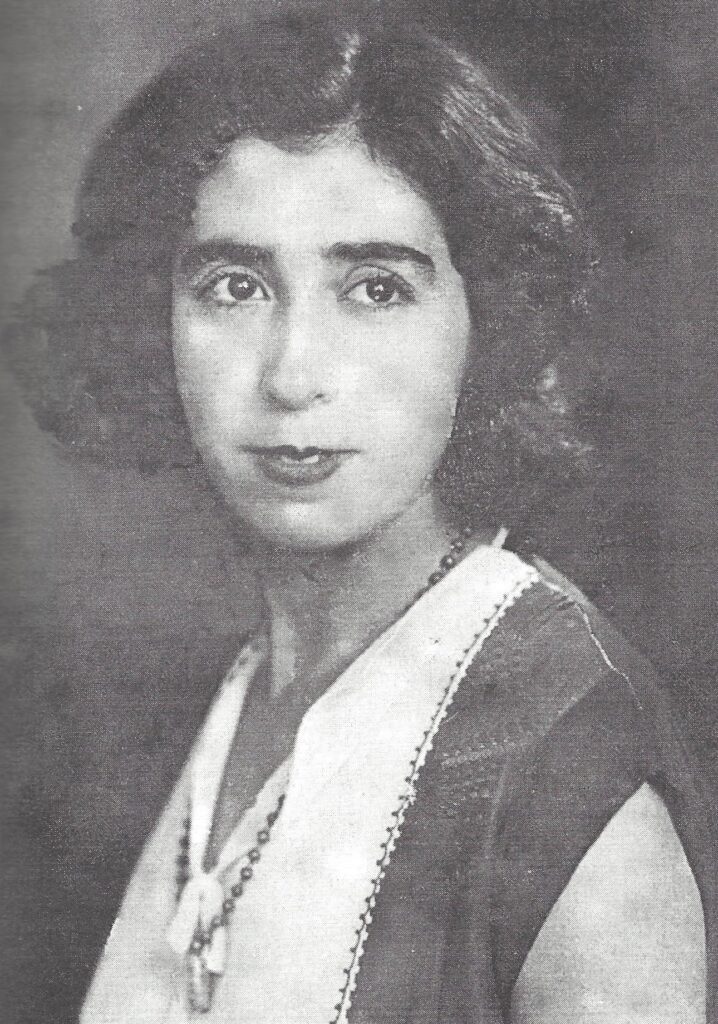


Pascaline Mallet visits in December 1936, a French writer and seeker whose 1938 book Turn Eastwards details her nine-month pilgrimage in India from December 1936 to September 1937.
Pascaline Mallet (24 May 1901 – Varengeville-sur-Mer, 2 December 1989 – Varengeville-sur-Mer). This French writer’s 1938 book Turn Eastwards was appreciated by Sri Ramana. In the second edition of Self Realization by B. V. Narasimha Swami included a short excerpt from a book entitled Turn Eastwards by Pascaline Mallet who visited the ashram in 1937. For reasons unknown, this excerpt was deleted from the subsequent editions; In May 1938, Bhagavan Ramana, after having gone through the whole book of Mme. Pascaline Mallet’s book Turn Inwards, spoke for about an hour on that book. He said that the writing was full of feeling and the writer was sincere. The book is written in a simple style and finishes off with remembrance of Himself. Bhagavan Ramana thinks that the book was well written. He interprets ‘Turn Eastwards’ as ‘Turn to the Source of Light.’
Face to Face with Sri Ramana Maharshi Compiled and Edited by Professor Laxmi Narain.
https://www.stillnessspeaks.com/wp-content/uploads/2016/07/Face_to_Face_with_Sri_Ramana_Maharshi.pdf




Jean Francis Auburtin kept in his library a copy of At The Feet Of The Master, by Alcycone (Jiddu Krishnamurti). This was the first book written by Krishnamurti, then aged 14. Alcyone is the brightest star in the Pleiades. Krishnamurti had been a guest of the Mallet’s in their home, Bois des Moutiers, located in Varengeville-sur-Mer, Normandy, France. Reflecting the Theosophist philosophy of Guillaume Mallet and his wife, Marie-Adélaïde Grunelius, it was understood that the architecture and gardens should work together towards the harmonious development of the spirit. The presence of the young Indian is also mentioned in Jean Cocteau’s Le Potomak (during his visit with André Gide, in 1913).
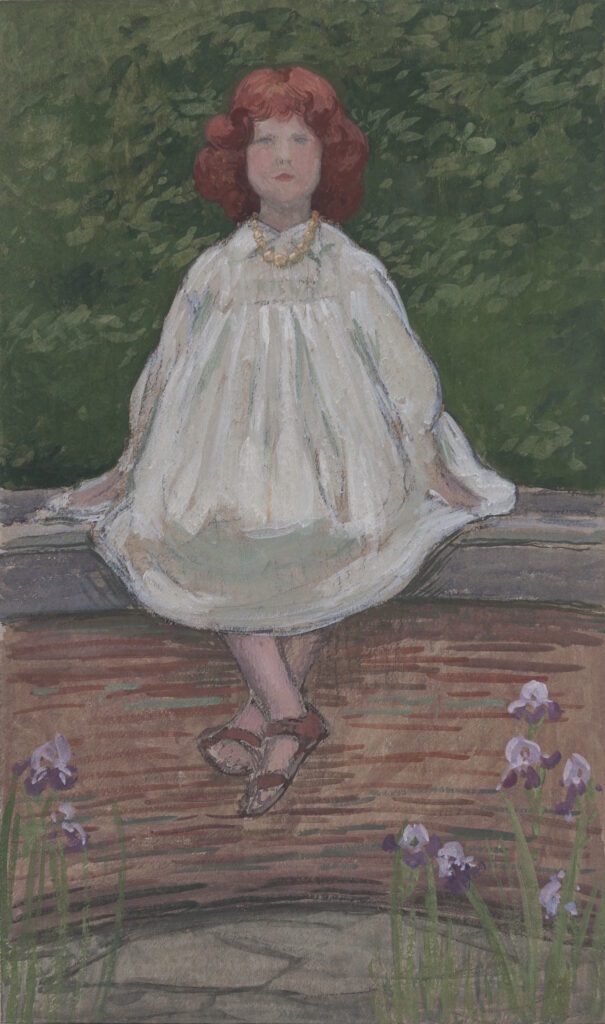
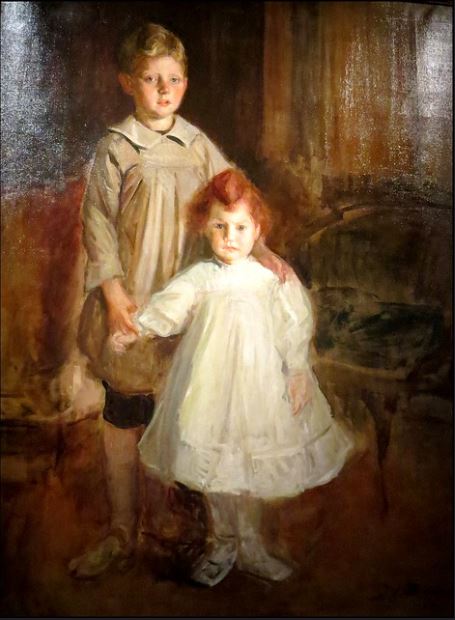
American Mrs Roorna Jennings of the International Peace League, January 1937.
From Talks with Sri Ramana Maharshi 18th January, 1937. Talk 331. Mrs. Roorna Jennings, an American lady of the International Peace League, asked Sri Bhagavan about the spread of Peace in the world.
Sri Bhagavan replied that if one gains the Peace of the Self it will spread itself without any effort on the part of the individual. When one is not oneself peaceful, how can that one spread peace in the world?
The lady asked if it was not true that the East has a scientific approach to the Realisation of the Self.
M.: You are already the Self. No elaborate science is necessary to establish it.
D.: I understand the general truth of it. But there must be a practical method for it which I call ‘science’.
M.: The cessation of such thoughts is the realisation of the Self. Illustration: the necklace supposed lost. One does not see the world or one’s own body, being away from the Self. Always being the Self, one sees everything else. God and the world are all in the Heart. See the Seer and everything will be found to be the Self. Change your outlook. Look within. Find the Self. Who is the substratum of the subject and the object? Find it and all problems are solved.
The lady was then told of the pamphlet, Who am I? She agreed to read it before asking further questions of Sri Bhagavan.
23rd January, 1937. Talk 338. Mrs. Jennings, an American lady, asked a few questions:
D.: Is not affirmation of God more effective than the quest, “who am I?” Affirmation is positive, whereas the other is negation. Moreover, it indicates separateness.
M.: So long as you seek to know how to realise, this advice is given to find your Self. Your seeking the method denotes your separateness.
D.: Is it not better to say ‘I am the Supreme Being’ than ask ‘Who am I?’
M.: Who affirms? There must be one to do it. Find that one.
D.: Is not meditation better than investigation?
M.: Meditation implies mental imagery, whereas investigation is for the
Reality. The former is objective, whereas the latter is subjective.
D.: There must be a scientific approach to this subject.
M.: To eschew unreality and seek the Reality is scientific.
D.: I mean there must be a gradual elimination, first of the mind, then of the intellect, then of the ego.
M.: The Self alone is Real. All others are unreal. The mind and intellect do not remain apart from you.
The Bible says, “Be still and know that I am God”. Stillness is the sole requisite for the realisation of the Self as God.
D.: Will the West ever understand this teaching?
M.: There is no question of time and space. Understanding depends on ripeness of mind. What does it matter if one lives in the East or in the West?
Sri Bhagavan referred the lady to a few stanzas in Truth Revealed and to Thayumanavar. She retired.
Later Sri Bhagavan said the whole Vedanta is contained in the two Biblical statements:
“I am that I AM” and “Be still and know that I am God.”
Mr. K. S. N. Iyer, a Railway Officer, said to Sri Bhagavan that the compiler of Cosmic Consciousness considers realisation to be possible only within certain limits of age in an individual’s life.
M.: Does anyone say “I must come into being before or after some age?” He is here and now. Statements like this are misleading because people come to believe that they cannot realise the Self in this incarnation and must needs take chances in another. It is all absurd.
Alfred Julius Emmanuel Sorensen (1890 – 1984) also known as Sunyata, was a Danish natural born mystic who lived in India for 40 years. In 1929, he met Rabindranath Tagore in England, who invited him to visit Santiniketan, his centre near Calcutta. He went to India the same year and stayed 18 months travelling after staying with Tagore for only a short while. Either on this or his next trip to India, he was befriended by a young American on his way to Swami Ramdas to pay his respects and to offer thanks and gratitude for sending him to Ramana Maharshi several years earlier. The young American was to become famous anonymously years later in Somerset Maugham’s book The Razor’s Edge. The meeting was a turning point for Sorensen because the man, basically no different than himself, had awakened to the absolute under the auspices of the sage Ramana Maharshi. After returning briefly to the West, he returned to India and stayed for approximately 40 years. First, he lived in a tree on a small island in the Ganges near Haridwar. In 1934, he became the gardener to the Nehru family on their estate ‘Khali,’ near Binsar. One of their friends offered him land on Crank’s Ridge where he could live, where the remains his cave dwelling can still be seen. He read Paul Brunton’s A Search in Secret India (1934), and soon after he met the author who arranged for his first visit to Ramana. He made four trips to the ashram between 1936 and 1946. Brunton told him that Ramana had referred to him as a ‘janam-siddha’ or rare born mystic. Sorensen’s life is captured in the 2015 biography Dancing with the Void: The Innerstandings of a Rare-born Mystic by Betty Camhi and Gurubaksh Rai.

From A Woman’s Work With Gurdjieff, Ramana Maharshi, Krishnamurti, Anandamayi Ma & Pak Subuh by Mary Ellen Korman – He first visited India in 1930 and “toddled about,” as he said, for eighteen months before returning to England. In 1933 “Brother Alfred,” as he was called in India, returned to live permanently. Given a plot of land for his use for his lifetime, he built a one-room stone hut at Kalimat, on a ridge of tall pine trees and chattering monkeys overlooking Almora, which lay three miles below. The ridge was known as Kasardevi because it stretched out to the rock of Kasardevi, a natural hollow where in ancient times human sacrifices were offered. From the ridge loomed a majestic, 23 mile view of a vast and towering snow-capped Himalayan landscape. On his land he created what he called his “Garden of Emptiness” and planted shrubs, mimosa, winding morning glory and blossoming cherry trees. He lived on what life would bring, and five rupees a month which a devotee promised.
Despite Kasardevi’s grand vista, because of the oddity of its foreign inhabitants, locals called it “Cranks’ Ridge.” And Sunya was regarded as one of the “cranks” along with Lama Govinda, the German author of The Foundations of Tibetan Buddhism, and his Parsi wife, Li Gotami; W. Y. Evans-Wentz, the Oxford don who translated The Tibetan Book of the Dead and other esoteric Tibetan texts; the artist Earl Brewster; the Indian sage Sri Anirvan and his pupil Lizelle Reymond. (A good friend of Anirvan’s, Sunya had introduced Lizelle Reymond to him. She would later write To Live Within about her days with Sri Anirvan, and upon returning to France would meet Madame de Salzmann and join her Gurdjieff group in Geneva, Switzerland.)
He learned of Sri Ramana Maharshi from Paul Brunton, who had come to see him. Recognising Brother Alfred’s natural Advaitic quality, Brunton suggested he see Ramana Maharshi. And so in 1936 he visited Sri Ramana Maharshi’s ashram. He had no problem, no disease, and no quest and so asked no questions. Maharshi, however, did ask him some questions which he forgot. But his first darshan with Maharshi remained forever memorable. “We are always aware, Sunyata,” said the Maharshi. The message, telepathic in medium, answered Brother Alfred’s one question-did the wholeness remain during sleep? Not only did the Maharshi answer his question but he felt he had also been given a name. And so thereafter Brother Alfred was known as “Sunyata” or “Sunya.”
Face to Face with Sri Ramana Maharshi Compiled and Edited by Professor Laxmi Narain.
https://www.stillnessspeaks.com/wp-content/uploads/2016/07/Face_to_Face_with_Sri_Ramana_Maharshi.pdf
Sunyata met with Gandhi, Ramana Maharshi, Anandamayee Ma, Yashoda Ma (Mirtola), Swami Ramdas and Neem Karoli Baba. He died in a car accident in California in 1984. There is a couple of books about Sunyata out there. They are all based on this raw 486 typewritten manuscript. The document is unfortunately in a very bad shape and it is more than 92 Mb.
For a more readable version choose this carefully retyped version:
https://holybooks-lichtenbergpress.netdna-ssl.com/wp-content/uploads/Nectar-of-Sunyata.pdf
The Nectar of Sunyata:
https://holybooks-lichtenbergpress.netdna-ssl.com/wp-content/uploads/Nectar-of-Sunyata.pdf

Face to Face with Sri Ramana Maharshi Compiled and Edited by Professor Laxmi Narain.
https://www.stillnessspeaks.com/wp-content/uploads/2016/07/Face_to_Face_with_Sri_Ramana_Maharshi.pdf
Professor Harold Banning Richardson (1910 – 1993) arrived in May 1937 and stayed for three days. Professor Richardson, M.A. (Hons.) (Cantab.), A.B. (Princeton), came to teach English literature at St. Stephens College, Delhi, in the 1930s. He felt ‘ravished’ by the description of the Maharshi in A Search in Secret India.
“In the presence of Sri Ramana Maharshi I felt an inward joy, which suffused (to spread all over) my consciousness, and made thinking seem superfluous. I had come in touch with spiritualism of the finest type. When I was in the presence of the Master I was so filled with joy and peace that the desire to ask questions disappeared. This happened throughout the three days I stayed at Sri Ramanasramam. When one comes into the presence of a man who is ‘good’ not merely because he shuns ‘evil’ but because his love is universal and falls alike on just and unjust, then one experiences immediate recognition of a soul that is not great as the world values greatness, but great when compared to an absolute standard of values – a precious stone, an emerald without flaw. It is a difference not merely of quality but of kind.” – Sri Ramana Jyothi January – December 2013.
The Princeton Alumni Weekly says that Banning was born in Berkshire, England. He lived in a number of places in the US and Canada. Banning had a colourful career. He spent many years in India, teaching at several universities, including as Professor of English at the Government College in Lahore, and as minister of education of Indore State. During WWII, Banning was a captain in the Eighth Gurkha Rifles. He attended the UN Conference in San Francisco in 1945 as secretary of the Indian delegation. He returned to England in 1949, and later moved to Canada, where he was a broker in Toronto and president of the Princeton Alumni of Canada.
In 1937, Banning married Dian Vivien Johnson, in London. They had a son, Raymond and three daughters, Joanna, Rhea, and Sarah. There are six grandchildren. Dian and Banning were divorced in 1966. He later married Gladys Loat.
The article Faith in Destiny of Man that appeared in the March 1944 issue of The Aryan Path
https://ashramsofindia.com/wp-content/uploads/2022/04/March-1944-The-Aryan-Path.pdf
Swiss author Lizelle Reymond (1899 – 1994) and future French Interpreter husband Jean Herbert (1897 – 1980) first visited the ashram in 1937. Lizelle visited the ashram several times during Bhagavan’s lifetime. In a letter that she wrote to Monica Bose more than forty years later, she still recalled the peace that she had felt in that little garden where the Maharshi had spent many happy moments with the animals in the ashram. In the same letter she described her first meeting with the Maharshi. What happened on that occasion provides yet another instance of his singular insight and of his way of guiding people according to their particular need. In her case he turned her in the direction of a Guru in the North, knowing that it was his teaching to which she would be best attuned. As she wrote, ‘When I met the Maharshi for the first time he asked, “Why don’t you leave for the Himalayas?” I answered, “Tomorrow if you wish.” That was my place. I stayed there five years with Sri Anirvan.’ Anirvan’s ashram was just twenty miles from Mirtola, and Lizelle visited Krishna Prem and Madhava Ashish a number of times.
During their 1937 tour of India they also stayed at the ashrams of Sri Aurobindo, Anandamayi Ma, Swami Ramdas and at the Belur Math in Calcutta.

In 1922 Ramdas met Ramana Maharshi. As a result of this, he went into his first retreat, living for 21 days in solitude in a cave in Arunachala. Upon leaving this cave he began claiming that, “All was Ram, nothing but Ram.” After continuing to live as an itinerant for many years, his devotees established Anandashram for him in Kanhangad, Kerala in 1931. The ashram worked to improve the living conditions of the local people, and continues till present day to share Ramdas’ teachings. Ramdas’ well-known disciples includes Mataji Krishnabai, Swami Satchidananda, Swami Muktananda and Yogi Ramsuratkumar.

David MacIver belongs to the very early group of western devotees who came under the powerful influence of Ramana Maharshi.
Arriving in 1938, he was, perhaps, the first Westerner to build a house in Ramana Nagar. During his stay with Bhagavan, he helped Munagala Venkataramaiah to translate many of the works of Ramana Maharshi. While staying with Bhagavan, he went to Malakara, Kerala and lived with Swami Atmananda. He passed away there on September 19th 1981 after a prolonged illness.
MacIver was a friend of the Osborne’s, having met in Kashmir during the summer of 1942. When Arthur had to go return to Bangkok alone in 1942, his wife Lucia and their three children initially stayed with MacIver in Tiruvannamalai. Osborne eventually arrived in Tiruvannamalai after the conclusion of WW2 in 1945.

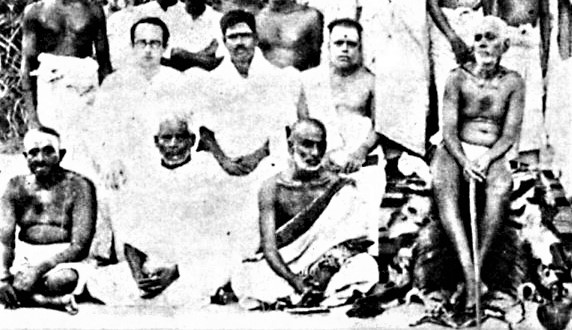
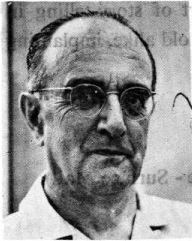
American engineer Guy Hague who originally came from Long Beach, California arrived in Sri Ramanasramam in 1938 after travelling the world, he stayed 2½ years. There has been considerable speculation among the Maugham scholars as to whether the character of Larry Darrel in the book The Razor’s Edge is derived from Guy Hauge. There are similarities, but there is no evidence that Maugham had met Hague either in India or anywhere else. It is also thought that Hague was not at Sri Ramanashram, or even in India, on the day that Maugham visited the ashram. The current consensus is that Larry Darrel is a composite character derived partly from different people Maugham had met and partly from imagination.



https://www.youtube.com/watch?v=IrrpNhQB5uo&ab_channel=AshramsofIndia
Christina Austin brought Somerset Maugham (and his companion Gerald Haxton ?) to the ashram in January 1938 for a few hours (his 1944 novel The Razor’s Edge models its spiritual guru after Sri Ramana).
After a month touring holy sites in the south, Maugham had arrived in Madras, where at a cocktail party Christina Austin (known as Nena), the wife a senior British civil servant, offered to take him to meet Ramana Maharshi. She was a remarkable woman in her own right, she was both a Doctor and a Missionary. She was the wife of Thomas Austin, who had entered the Indian civil service in 1910 and served in various junior positions before being appointed District Collector of Nilgiris in 1929. He served as Collector of Nilgiris from 1929 to 1932 when he was appointed Diwan of Travancore on a two-year contract. In his later life, Austin also served as Chief Secretary of the Government of Madras. Austin Town in the city of Bangalore, India is named after Thomas Austin who had built houses for low-income groups in the Cantonment section of the city. Austin was made a Knight Commander of the Order of the Indian Empire in 1945. Kathy Myers writes in 2018 that when Sir Thomas Austin returned to the UK he moved into Home Park House Hampton Wick KT14AE. It was originally a ‘grace and favour’ house to Hampton Court Palace, but was no longer so when he bought it. He came back to the UK with servants from his time in India who looked after him and a mass of Indian furniture and hunting exhibits – he had a whole 60ft room stuffed with elephant tusks, taxidermised tigers and photos of his time in India. The house gradually fell into disrepair and by the time it was sold in 1960, it featured ‘untouched’ regency wall paper and wisteria trees growing through the roof and living rooms. My parents bought the house in 1960 and tried to find ‘homes’ for all the exhibits left in the house – including miniatures of Clive of India. The house was an extraordinary time capsule of the end of the Raj pre Independence.
In January 1938 Somerset Maugham, the British novelist, visited Sri Ramanashram for a few hours. The brief contact he had with Bhagavan inspired Maugham so much, he decided to use him as the model for a fictional Guru in The Razor’s Edge, a novel of his that was published a few years later in 1944. Maugham also wrote a non-fiction account of his visit in an essay entitled The Saint, which was published twenty years after the event in 1958. davidgodman.org
The Razor’s Edge – It is thought that sometime in the late 1920s a young traveller from America bumped into Swami Ramdas one night at the Meenakshi Temple in Madura, the two of them had previously met in the caves of Elephanta three years earlier. The young American would eventually gain fame, albeit anonymously, in W. Somerset Maugham’s 1944 novel The Razor’s Edge. Given the name Larry Darrell by Maugham in the book, that same American, in real life following the advice of Ramdas, went to see Ramana Maharshi. Through the grace and light of the Maharshi, the anonymous American awakened to the absolute. Although today among the Maugham scholars it is thought that Darrell is a composite character, made up of the different people Maugham had met and partly fictional.
The novel follows the idea that since time immemorial people have sought out enlightenment and spiritual awakening. As was the case of the novel’s young character, the American pilot Laurence Darrell after he had personally witnessed a devastating wartime event during World War 1 that changed his perspectives on life. He leaves his fiancée and the opportunities for an affluent lifestyle and sets out on a journey in search truth regarding life. He travelled to India eventually studying with a highly venerated Maharshi in a South Indian ashram that is presided over by a Guru who is clearly Ramana Maharshi, but is identified in the book as Shri Ganesha. He experiences enlightenment and after several years at the ashram, Darrell returns to America with the aim of living, so far as it is possible, the life of a sadhu.
When The Razor’s Edge was published it immediately became a best-seller, and is thought to be Maugham’s most successful novel. He sold the film rights to Twentieth Century Fox soon after it’s publication. Maugham worked on the screenplay but not a single word of Maugham’s dialogue was used in the released film that was a critical and financial success and nominated for four Oscars. Maugham declined to write a sequel for Fox and never worked in Hollywood again. The film was remade in 1984 and was a commercial failure.
A William Somerset Maugham Encyclopedia by Samuel J. Rogal.
Prior to the actual writing of The Razor’s Edge, Maugham felt a need to see India and Buddhism for himself, particularly the southern states under native rule, where English influence would be the least. Thus, in January 1938, Maugham and Gerald Haxton arrived in Bombay, armed with letters of introduction from the Aga Khan, his neighbor on the French Riviera, to various maharajas. He planned a three-month tour. Remaining in Bombay for ten days, he then set off for the Portuguese Catholic state of Goa, where, to his dismay, he met a Catholic priest whose Brahmin ancestors had been converted from their religion. In Madura, he visited the large seventeenth-century temple built to the goddess Siva, where he found priests and their pupils, as well as homeless poor, praying and setting forth burnt offerings. From Madras, Maugham traveled by car to Tiruvannamalai, at the foot of the sacred mountain of Arunachala. There he met a holy man, Bhagavan Ramana Maharshi (d.1950), a strict vegetarian whose meditations, his disciples claimed, produced spiritual illumination. However, the writer fainted as he waited to be presented to the holy man, and the interview did not achieve the expected results. Nonetheless, Maugham found there an American ex-sailor from Long Beach, California, named Guy Hague, who had joined the Bhagavan to find peace and spiritual serenity. Hague stands as the primary candidate for the model of Lawrence Darrell in The Razor’s Edge, while the Bhagavan undoubtedly emerged in the novel as the Swami who meets Larry on the ship from Alexandria to Bombay.
Hyderabad proved Maugham’s next stop, where he met the finance minister, Sir Akbar Hydari, who thought that the writer had come to shoot tigers. When the writer asked to meet with scholars and religious teachers, Hydari supplied another holy man who merely repeated everything that Maugham had already heard. From Hyderabad to Bidar, Maugham came across a healer, a former contractor in a dirty white turban, a swami who practiced aestheticism, and fakirs in a Moslem cemetery putting skewers through their eyes and cheeks. At Nagpur, he lunched with the prince and princess of Berar, the prince telling him that the difference between the Yacht Club at Bombay and the Bengal Club at Calcutta depended upon the former’s allowing dogs on the premises, while the latter did not. From there, Maugham and Haxton took in Calcutta, Banaras, Agra, the Taj Mahal, New Delhi, and finally, at the end of March, back in Bombay. Although Maugham did indeed learn something about India, its religion, and its holy men, he came away with a poor impression of the English there, particularly their racism and provincialism. A second visit planned for the autumn of 1939 to gather still more material on India had to be canceled because of World War II.
Maugham regarded Haxton as indispensable to his success as a writer; Maugham himself was painfully shy, and Haxton, an extrovert, gave him access to the human material that fed Maugham’s fiction.
In a 1959 biography of Maugham, New York University English professor Karl G. Pfeiffer maintained that Maugham actually had an interview with Gandhi. However, Maugham angrily denied that such an event had occurred.
The Secret Lives of Somerset Maugham: A Biography by Selina Hastings.
At Tiruvannamalai, near Madras, Maugham visited the ashram of the famous sage Sri Ramana Maharshi, where he enjoyed the unique opportunity of talking to an English sadhu Major A. W. Chadwick, a retired British army officer, currently incarnated as Sadhu Arunachala, had lived in the ashram for years, and was more than happy to discourse at length about karma and reincarnation and to describe his personal efforts “to realise the self in him in communion with the universal self, to separate the I that thinks from the self, for that is the infinite.” But even with a fellow Englishman, Maugham was left little the wiser, and by the end of the interview still “could not get from him exactly what he meant.” The Maharshi received visitors at an audience every afternoon, and Maugham and Haxton having arrived at midday were halfway through their picnic lunch on the veranda outside Chadwick’s room when Maugham suddenly fainted. Chadwick carried him indoors and laid him on his bed, where he stayed for some time, feeling too unwell to join the crowd in the central hall. The Maharshi, informed of what had happened, graciously consented to come and see him, and “Bhagavan [the Maharshi] and Somerset Maugham sat opposite to each other for about half-an-hour without uttering a word,” Chadwick recalled.
At the end of which Somerset Maugham looked nervously across in my direction and said, “Is there any need to say anything?” “No,” replied Bhagavan. “Silence is best. Silence is itself conversation.”
He may have failed to achieve enlightenment, but so intrigued was Maugham by this first visit to India that before embarking from Bombay on the voyage home he had already determined to return the following year, a project that events far outside his control were to render impracticable. While still at sea, on board the Conte Biancomano, the gravity of the situation in Europe was forcefully impressed upon the passengers, as news reports arrived daily over the ship’s radio of Franco and the Civil War in Spain, of the Fascist imperialism of Mussolini in Italy, and now, on March 14, of the Anschluss, of Hitler’s invasion of Austria. “We have been much disturbed over the Austrian business [and] Gerald has been much in the dumps over it all because so many of his friends are affected,” Maugham wrote to Alan Searle. “For a moment I was terribly afraid that it might mean a general war; but that seems now not to be the case.”
In Bombay, Maugham had a brief meeting with none other than the young Congress leader, Jawaharlal Nehru, who went on to become the first prime minister of India. This fact is revealed through Nehru’s letters that he wrote to his daughter Indira (Gandhi). While Maugham’s biographers like Selina Hastings have done an adequate job of covering Maugham’s India visit, none has mentioned this particular meeting between Maugham and Nehru.
From The Mountain Path April 1966
OBITUARY SOMERSET MAUGHAM – Although by no means dedicated to a spiritual life, the late Somerset Maugham was one of those who helped to make the Maharshi widely known. He came here for a brief visit in 1939, after which he wrote the novel The Razor’s Edge presenting a highly fictionalised picture of Bhagavan. Towards the end of his life in Points of View he gave an account of the principle influences on his life, and one chapter of the book, entitled The Saint was about Bhagavan.
Since various stories of his visit here have been put abroad, we quote here that given by Major Chadwick from his own first-hand observation in his book A Sadhu’s Reminiscences of Ramana Maharshi – In March 1939, Somerset Maugham came to the Ashram. Many accounts have been given of his visit and all of them different. As I was the principal person concerned in looking after him, I have decided to give m y ow n version. He was brought to the Ashram by a friend of mine, Mrs. Austin, wife of the Collector of Madras. The party had first gone to the dak bungalow to have their lunch, but finding it full had come on to the Ashram. They asked me whether I could find somewhere for them where they could have the meal they had brought with them. I arranged for one of the small rooms near my own. As I had already had m y meal, at their request I sat and talked with them while they ate. Somerset Maugham asked innumerable questions about my life and the Ashram, apologizing for his inquisitiveness.
At the end of the meal, which they had taken on the verandah, with Somerset Maugham sitting more or less in the sun, he fainted. Many absurd stories were circulated to account for this ; that he had seen Bhagavan and this was a state of, samadhi brought on by the meeting and such like. Actually he had not seen Bhagavan at all. It was probably a slight sun-stroke, though he himself said that he had been liable to such black-outs occasionally since birth.
We carried him to my room and laid him on my bed; I then went to Bhagavan and told him what had happened and asked him, when he went out for his stroll at about 2 o’clock, to come to my room and see Somerset Maugham who was now unfit to come to the Hall, and Bhagavan agreed.
I met Bhagavan on the way and as we approached my room Somerset Maugham was just coming out; he said that he now felt better and was on his way to the hall. I told him to go back into the room and sit down, as Bhagavan had come to him there instead. Bhagavan and Somerset Maugham sat opposite to each other for about half an hour without uttering a word. At the end of which Somerset Maugham looked nervously across in my direction and said, “Is there any need to say anything ?” “No,” replied Bhagavan, “Silence is best. Silence is itself conversation.” After some further period Bhagavan turned to me and in his child-like way said “I think I had better be going, they will be looking for me.” As no one in the Ashram knew where he had gone except the attendant who always accompanied him, this was correct, The interview lasted about forty-five minutes. After Bhagavan had returned to the Hall the rest of the party remained in my room for tea. After tea Somerset Maugham, who was wearing a large pair of boots, wanted to go to the Hall and see where Bhagavan usually lived. I took him to the western window through which he looked for some time with interest making mental notes. He says in his indifferent and quite uninspired article The Saint, published in a series of essays twenty years after the event, that he sat in the Hall in Bhagavan’s presence, but this is untrue, because he could not enter with his boots; he only gazed into the hall from outside. He also tacked a certain amount of philosophy on to Bhagavan which Bhagavan could never have uttered in his life. But such is the habit of famous authors, to put their own opinions into the mouths of others.
In this recent article, Somerset Maugham says that because of his fainting fit, which some Indians regarded as a high state of samadhi, which he denies, he has been sent a mass of literature concerning the Maharshi. This may be true, but it is certainly true that he wrote to the Ashram and told them that he was going to write about Bhagavan and asked for as much material as they could send. (pp. 45-47).



Three ladies on a short visit in Feburary 1938, Mrs Hearst from New Zealand, Mrs Craig and Mrs Allison from London.
From Talks with Sri Ramana Maharshi 8th February, 1938. Talk 453. Three ladies are on a short visit here, Mrs. Hearst from New Zealand, Mrs. Craig and Mrs. Allison from London.
A young English woman, identified as Miss J, arrived in May 1938, dressed in a Muslim sari, she had evidently been in North India and met Dr. G. H. Mees,
From Talks with Sri Ramana Maharshi 2nd May, 1938. Talk 487. An English lady, a young woman, came here dressed in a Muslim sari. She had evidently been in North India and met Dr. G. H. Mees.
Sri Bhagavan read out a stanza “The Black Sun” from the anniversary number of The Vision, written by Swami Bharatananda.
After a few minutes, Miss J. asked: One gathers from the stanza that one should keep on meditating until one gets merged in the state of consciousness. Do you think it right?
M.: Yes.
D.: I go further and ask: Is it right that one should, by conscious will, go into that state from which there is no return?
(No answer) – Dinner bell.
An American gentleman, Mr J. M. Lorey in June 1938.
From Talks with Sri Ramana Maharshi 17th August, 1938. Talk 503. An American gentleman, Mr. J. M. Lorey, has been staying in the Asramam for about two months. He asked:
I am leaving tonight. It gives me pain to tear myself away from this place. But I must go to America. I ask for a message from the Master. The Master understands me even better than I do myself. So I pray for a message to keep me up when I am away from the Master.
M.: The Master is not outside you as you seem to imagine. He is within, is in fact the Self. Recognise this truth. Seek within you and find Him there. Then you will have constant communion with Him. The message is always there; it is never silent; it can never forsake you: nor can you ever move away from the Master.
Your mind is outgoing. Because of that tendency it sees objects as being outside and the Master among them. But the Truth is different. The Master is the Self. Turn the mind within and you will find the objects within. You will also realise that it is the Master who is your very Self and there is nothing but Him.
Because you identify yourself with the body you have accepted
objects as being outside you. But are you the body? You are not.
You are the Self. There are all the objects and the whole universe. Nothing can escape the Self. How then can you move away from the Master who is your very Self? Suppose your body moves from place to place; does it ever move away from your Self? Similarly, you can never be without the Master.
Mr. Lorey was struck by the answer although he was already familiar with the Master’s ways. He was even visibly moved. He prayed that the Grace of the Master might abide with him.
Sri Bhagavan: The Master being the Self. Grace is inseparable from the Self.
Mr. L. Saluted Sri Maharshi with intense fervour, saying: that he might be enabled to realise the Truth.
M.: Is there any moment when you have not realised the Self? Can you ever be apart from the Self? You are always That.
D.: You are the great Master shedding joy and bliss on the world. Your love is indeed unlimited that you choose to abide in the world in human shape! But I wish to know if one should necessarily realise one’s Self before being of help to the country and a leader of men.
M.: Realise the Self first and the rest will follow.
D.: America is now the foremost country in industrial matters, mechanical engineering, scientific advance and other worldly affairs. Will she come up to the same level in spiritual life also?
M.: Certainly, she is bound to.
D.: Thank God that it will be so! I am a partner in an Engineering firm. But it is not of vital concern to me. I try to bring spiritual ideals into the work-a-day life of the firm.
M.: That is good. If you surrender yourself to the Higher Power all is well. That Power sees your affairs through. Only so long as you think that you are the worker you are obliged to reap the fruits of your actions. If on the other hand, you surrender yourself and recognise your individual self as only a tool of the Higher Power, that Power will take over your affairs along with the fruits of actions. You are no longer affected by them and the work goes on unhampered. Whether you recognise the Power or not the scheme of things does not alter. Only there is a change of outlook. Why should you bear your load on the head when you are travelling on a train? It carries you and your load whether the load is on your head or on the floor of the train. You are not lessening the burden of the train by keeping it on your head but only straining yourself unnecessarily. Similar is the sense of doership in the world by the individuals.
D.: I have been interesting myself in metaphysics for over twenty years. But I have not gained any novel experience as so many others claim to do. I have no powers of clairvoyance, clairaudience, etc. I feel myself locked up in this body and nothing more.
M.: It is right. Reality is only one and that is the self. All the rest are mere Phenomena in it, of it and by it. The seer, the objects and the sight, all are the self only. Can anyone see or hear, leaving the self aside? What difference does it make to see or hear anyone in close proximity or over enormous distance? The organs of sight and hearing are needed in both cases; so also the mind is required. None of them can be dispensed with in either case. There is dependence one way or another. Why then should there be a glamour about clairvoyance or clairaudience?
Moreover, what is acquired will also be lost in due course. They can never be permanent.
The only permanent thing is Reality; and that is the Self. You say “I am”, “I am going”, “I am speaking”, “I am working”, etc. Hyphenate “I am” in all of them. Thus I – AM. That is the abiding and fundamental Reality. This truth was taught by God to Moses: “I AM that I-AM”. “Be still and know that I-AM God.” so “I-AM” is God.
You know that you are. You cannot deny your existence at any moment of time. For you must be there in order to deny it. This (Pure Existence) is understood by stilling your mind. The mind is the outgoing faculty of the individual. If that is turned within, it becomes still in course of time and that “I-AM” alone prevails. “I-AM” is the whole Truth.
D.: I appreciate the whole answer.
M.: Who is there to appreciate what?
A question about Heart. Sri Bhagavan said: Leave alone the idea of right and left. They pertain to the body. The Heart is the Self.
Realise it and then you will see for yourself. (Mr. Lorey thanked Sri Bhagavan and saluted him before retiring.)
Cuban-American writer Mercedes de Acosta (1893 – 1968) travelled to Arunachala to meet Ramana Maharshi in 1938 after reading Brunton’s book A Search in Secret India,and stayed for three days. This visit made a tremendous impact on her. She later wrote in her 1960 autobiography Here Lies the Heart that these were the three most significant days of her life.
From The Nirvana Express by Mick Brown ~ The day before Mercedes de Acosta arrived at Sri Ramana Maharshi’s in November 1938, his disciple Ganapati Sastri showed the sage a letter the ashram had received from her requesting a meeting. ‘See the trouble to so many because I am here …,’ Ramana remarked with a sigh.
Travelling on the train to Madras, de Acosta and Consuelo shared the carriage with a young besuited lawyer and an elderly man clad only in a loincloth. At some point a conductor appeared and began to talk excitedly in Tamil. Perplexed, Mercedes brandished her ticket. The man leaned forward and in perfect English offered to translate: inspector, he explained, had no problem with the ticket. He was merely asking whether she believed in ‘the unity of the Divine and the dual soul.’
Acting as if this was the most natural enquiry in the world from a conductor, de Acosta replied that she was of the opinion that there indeed no separation between the Divine Source and the individual soul. The elderly man conveyed her opinion to the conductor who nodded wed, indicating that he too held these views. The conductor moved on to inspect tickets elsewhere in the train, but presently returned, settling himself down for a lively philosophical discussion until the train eventually reached Madras.
On arrival, de Acosta hired a car and driver for the long journey to Arunachala. Approaching the ashram, the road became a track, rough and rutted from the wheels of heavy ox-drawn wagons. At length, the driver said he would go no further and that she must proceed by foot. ‘As I ran those two miles up the hill,’ de Acosta later wrote, ‘deeply within I knew that I was running toward the greatest experience of my life.’ She was to stay just three days, but later wrote that these were the most significant days of her life.
De Acosta offered a characteristically dramatic description of her first encounter with Sri Ramana. Walking into the hall where he passed his days, she wrote, ‘I felt overcome by some strong power in the hall as if am invisible wind was pushing violently against me.’ She was greeted by American disciple of the Maharshi’s, Guy Hague, who took her hand and led her to a place against the wall from where she could observe the sage He was sitting absolutely straight on his divan, in the Buddha posture looking directly in front of him.
‘As he sat there he seemed like a statue, and yet something extraordinary emanated from him,’ she wrote. ‘I had a feeling that on some invisible level I was receiving a spiritual shock from him although his gaze was not directed toward me. He did not seem to be looking at anything, and yet felt he could see and was conscious of the whole world.’ Hague explained to her that the Maharshi was in a state of samadhi, in which he had be sitting for the past seven hours.
De Acosta sat for some time, ‘lost in a sort of inner world.’ Then Hague suggested she should go and sit near Sri Ramana. Shortly afterwards, the sage came out of samadhi and opened his eyes. ‘He moved his head and looked directly down at me, his eyes looking into mine,’ de Acosta wrote ~
It would be impossible to describe this moment and I am not going to attempt it. I can only say that at this second I felt my inner being raised to a new level – as if, suddenly, my state of consciousness was lifted to a much higher degree. Perhaps in this split second I was no longer my human self but the Self. Then Bhagavan smiled at me. It seemed to me that I had never before known what a smile was. I said, ‘I have come a long way to see you.’ He said, ‘I knew you were coming and I have been guiding your steps.’
Mercedes asked a series of questions, about whom or what she should follow. Sri Ramana answered as he always did: ‘You should follow the Self. There is nothing or no one else to follow.’ It is only by ‘diving deep in the Spiritual Heart that one can find the Self,’ he told her. ‘He placed his right hand on my right breast and continued, “Here lies the Heart, the Dynamic, Spiritual Heart”.’
De Acosta sat in the meditation hall with the Maharshi for two days and two nights. She wished to stay longer, but towards the end of the third day he told her that she should leave. ‘There will be what will be called a “war,” but which, in reality, will be a great world revolution,’ he said. ‘Every country and every person will be touched by it. You must return to America. Your destiny is not in India at this time,’ he continued. Sadly de Acosta packed her bags. As she was leaving, Sri Ramana told her: ‘You will return here again.’ She never did.
Face to Face with Sri Ramana Maharshi Compiled and Edited by Professor Laxmi Narain.
https://www.stillnessspeaks.com/wp-content/uploads/2016/07/Face_to_Face_with_Sri_Ramana_Maharshi.pdf
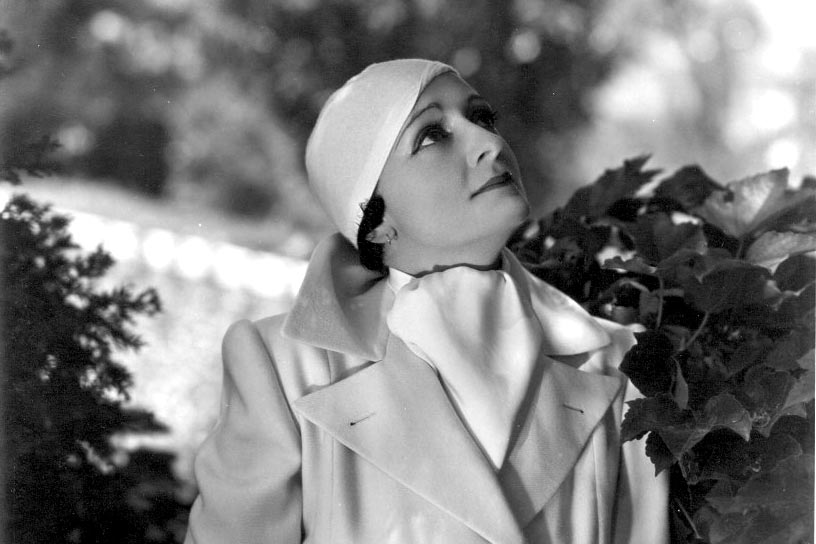


Renowned American painter Eliot Candee Clark (1883 – 1980) visited the ashram in 1938. The Maharshi sits half reclining upon a raised divan. He wears only a loincloth. I have no preconceived thought but pass before his presence respectfully. He seems quite oblivious, and if he has noted the stranger there seems no reaction or awareness. Although I am the only foreigner present, no one seems to have any visual or curious interest. I sit among others on the floor. No word is spoken.
My attention is at first a purely objective one. I study the head of the Maharshi. He is a man past sixty, with hair close cut and white, a short moustache and a beard, his complexion rather light. His features are not typically Hindu.The Backof his head is unusually full and round; high forehead, the brows almost in the center of the head, the eyes high set, the ears long and pronounced, the body in a state of composure.
A tall, dark-skinned pilgrim enters. He is nude to the waist. Then a woman enters. She kneels, bows her head three times.The Maharshi shows no sign of recognition.
The collective quietude creates a natural tranquility. Objective thought and self-consciousness gradually subside and one merges in the prevailing unity.
At the moment I have deliberately ceased my curious interest and am about to close my eyes in reverie, the Maharshi’s head is slightly turned, his eyes meet mine and there is an inexpressible radiance, the slightest indication of a smile. Then visual awareness ceases.
The teaching of the Maharshi is very simple. Quite impersonal in content, it can only be realized by personal practice and experience. The real teaching is in the revelation of silence: when the perturbation and the fluctuations of the mind are stilled, the inner presence radiates itself. He says: we know the mind only by its change; just as one is aware of the motion from a static standpoint. The mind, like motion, is a relative movement. We are made aware of its presence by change. But if the mind turns inward in quest of its origin, the ‘I’-awareness vanishes in its Source. The ‘I’ becomes identified, not with its egotistical consciousness and the world of change but with its Source, which is constant. ‘I’-consciousness is relative and finite; but the Source is infinite and eternal. In the womb of silence the light is ever shining.
The Maharshi does not lecture. He will answer questions; but in the magic of his presence the questions begin to vanish with the quietening of the mind.
Son of landscape painter Walter Clark and Jennifer Woodruff Clark, a student of psychic phenomena, Eliot Clark was a precocious artist who became a landscape painter in the late American Impressionist style. Moving to Albemarle, Virginia in 1932, he was one of the few Impressionist artists of the Southern states.
Face to Face with Sri Ramana Maharshi Compiled and Edited by Professor Laxmi Narain.
https://www.stillnessspeaks.com/wp-content/uploads/2016/07/Face_to_Face_with_Sri_Ramana_Maharshi.pdf
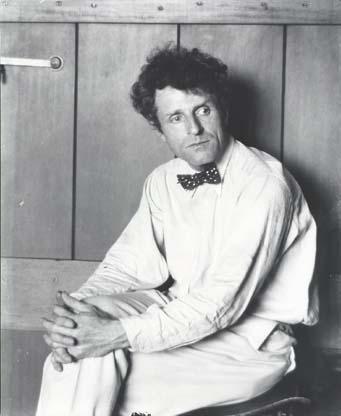
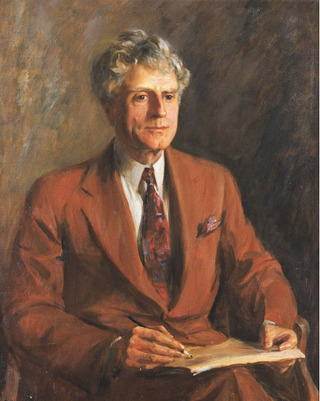

Day by Day with Bhagavan From the Diary of A. DEVARAJA MUDALIAR.
https://selfdefinition.org/ramana/Ramana-Maharshi-Day-by-Day-with-Bhagavan.pdf
20/01/1946 Morning It seems one Bernard Duval of Morocco was here for about fifteen days some eight years ago. He recently wrote to Major A.W. Chadwick (who has been living in the Asramam for ten years now) that when he was a prisoner during this war, he learnt Sanskrit and even translated Bhagavan’s Upadesa Saram into English, that later he had lost all those papers, and that he would like all Sanskrit works of Bhagavan to be sent to him. In connection with this request of Mr. Duval, Balaram was finding out what were all the works composed by Bhagavan in Sanskrit, and Bhagavan seems to have told Balaram that the above verse was also composed by him.
Two ladies, one Swiss and the other French, visited Maharshi in December 1938,
From Talks with Sri Ramana Maharshi 13th December, 1938. Talk 590. Two ladies, one Swiss and the other French, visited Maharshi. The younger of the ladies asked several questions, of which the most important was: “Brahman is the same as jiva. If the jiva be under illusion it amounts to saying that Brahman is under illusion. How is that possible?”
M.: If Brahman be under illusion and wants disillusionment let Him raise the question.
English woman Miss Ward-Jackson arrives in 1938/39
Eleanor Pauline Noye arrived in 1939, and stayed at the ashram for ten months. She made a second trip, arriving several months before Ramana’s Mahanirvana in 1950. She can be seen in archival films walking amidst a crowd of devotees directly behind Ramana.
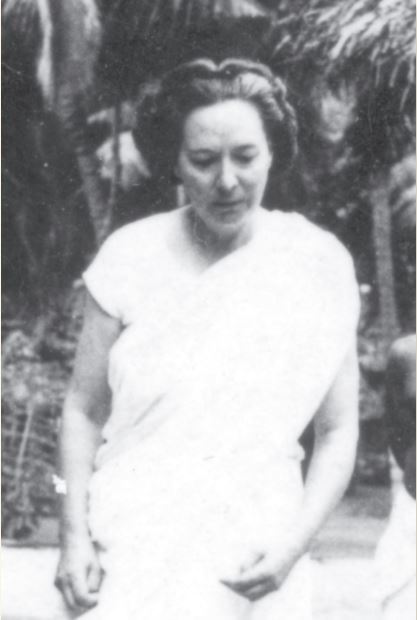

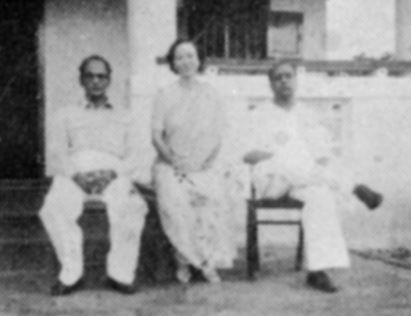





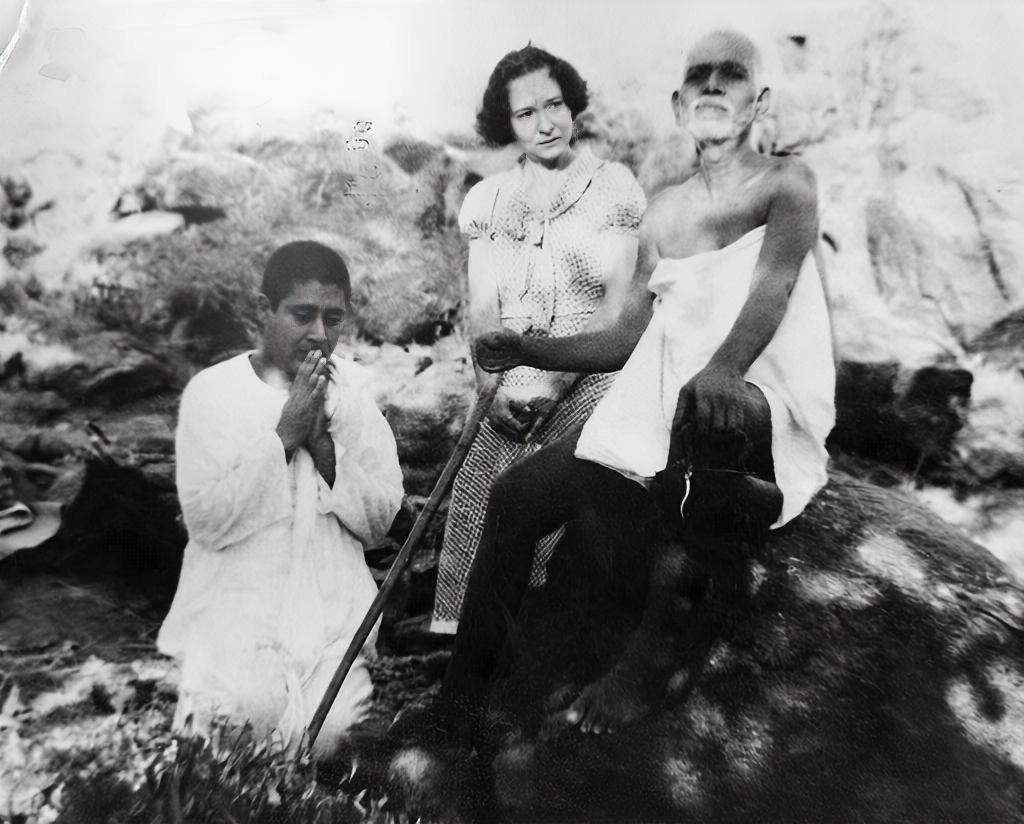
Face to Face with Sri Ramana Maharshi Compiled and Edited by Professor Laxmi Narain places Eleanor Pauline Noye as first arriving in 1940.
https://www.stillnessspeaks.com/wp-content/uploads/2016/07/Face_to_Face_with_Sri_Ramana_Maharshi.pdf
My Pilgrimage to Sri Ramanasramam by Eleanor Pauline Noye.
In the 1930s, Eleanor Pauline Noye began her spiral descent into despair, ill health and hopelessness. Throughout these difficult years she clung to an inexplicable faith that in India she would be restored to her former self. In spite of ill health and depression, she embarked on a journey that brought her face to face with her “Lord of Love” Upon arriving in the Ashrama in 1939 she was caught in the web of the Master’s love, regained her health, peace of mind and soared into the eternal expanse of freedom and joy. On her first visit to India she stayed at the Ashrama for ten months; subsequently, she made a second trip, arriving several months before the Master’s Mahanirvana in 1950. Her joy of being with the Master, walking amidst a crowd of devotees directly behind him, is captured in the Archival Films. She kept in touch with the Ashrama from her California residence till her last days, in the mid 1970s.
Crisis in Life
A few years ago I reached a crisis in my life. After years of anguish and sleepless nights, I was in a critical condition. When things seemed darkest I had an unusual feeling that I should go away. I discussed it with my twin, Betty, and decided to take a trip around the world. After making the reservation I became very ill and had to cancel it. One obstacle after another presented itself until it seemed as though I were not to go, and being so ill I did not care if I went or not. Still there always seemed to be something urging me to go and my sister also felt that I should. After a few weeks of rest I felt better and made reservations on another ship that was to sail a month later, but when the time arrived for sailing I was still not able to leave my bed. The boat sailed from San Francisco through the Panama Canal reaching New Orleans a month later. The steamship agent suggested my going there by train, which takes three days instead of one month, hoping I would feel better in the meantime.
I had a very trying trip to New Orleans, and upon arriving I collapsed and was taken to a Christian Science practitioner’s home, where they put me to bed and took care of me. They thought I was in no condition to take a long trip, but I felt as though I must. I could not turn back. Fortunately the boat was two weeks late; otherwise I would not have been able to sail. The steamship agent said, “You do not look very well. If the Captain sees you I am afraid he will not take you, as we do not carry a physician.” However, finally he agreed to my going but said, “Do not let the Captain see you until we are out at sea.” Though outward conditions were very dark, I went, knowing that God would take care of me. I felt as though I were led and if I had not followed that inner voice which prompted me I would never have had the blessed experience of finding the happiest part of my life in the presence of Bhagavan Sri Ramana.
I Want To Find Myself
The doctor who vaccinated me before I left, knew that I was not well. He said, “Why are you taking the trip?” I replied, “I want to find myself.” I was seeking something I had not found — Peace. Somehow my mind would always turn to India, especially during those days when I was in bed.
We sailed from New Orleans to Cape Town, South Africa, a three weeks’ trip without a stop. Providence was with me again, for had the boat stopped, I believe, I would have returned home. But God had other plans for me. I was torn between conflicting emotions and became worse again. My prayers seemed of no avail. I would have the most dreadful nightmares and wake up crying. I could not bear it any longer; so I sent a radiogram to the doctor: “Need help in every way, especially at night. Cold much worse; filled with fear. Will write from Cape Town.” I don’t know what I was afraid of, but my mind was never at peace. I felt better for a while but found it necessary to send a second cable. Therefore, had the boat stopped on its way to Cape Town, I should have disembarked and returned home. But Providence has always the upper hand. When we reached Cape Town, I felt much better; but as I did not like that ship I disembarked at Durban, South Africa, where I spent one month waiting for another boat.
Arriving in India
As we approached India I decided to get off at Madras, instead of going on to Calcutta, where the ship would be in dry-dock for two weeks. The people on board gave all sorts of reasons why I should not get off at Madras. It was very difficult to leave them; nevertheless I did, so they took me to the Connemara Hotel, saying it was not safe to stop at a second-rate hotel because of the food, etc. After my friends had gone I felt lost and went to my room and, with tears in my eyes, prayed for guidance. All night the heat was intense, so the next morning I asked the proprietor if he could suggest a cooler place. He said the hill station Kodaikanal was lovely and cool. So I made my plans to leave Madras immediately. Motoring there, I found it to be a charming place. The very first day I met two Hindu brothers and I asked them if they knew any Seers? I have no explanation to offer as to why I put that question. I anticipated nothing. They said they knew of one at Tiruvannamalai, Sri Ramana Maharshi. “People come from far and near to see Him. He left home,” they said, “when he was twelve-years old and never went to school. He is the greatest Seer in India. It is difficult to find one that is genuine.” This is what they told me about Bhagavan; of course, these facts are not accurate.
I decided to leave for Tiruvannamalai the next day.
My friends helped me in every way, told me to buy some bedding, etc., but did not tell me that it was the custom to take a gift to the Holy Man; in fact I knew nothing about life at an Ashram. When I left Madras I had no idea I would have this experience, but was eager to go, and felt as though something momentous was about to happen.
When I told the guests in the hotel my plans, they said it was not safe to go alone, as the place (the Ashram) was in a jungle, and I would not endure the hardships and humidity, as I had been in India only a few days and was not acclimatised. An English official and his wife insisted upon getting all the details in order to keep track of me. I bought a ticket for Madura as my friends told me to see the temples there, but I decided not to go to Madura, as I was anxious to reach my destination. So I left the car at Kodaikanal Road and took the train for Tiruvannamalai.
At the Ashram
After arriving there I engaged a bullock cart to take me to the Ashram, where I was greeted by some of the inmates, including Niranjanananda Swami, brother of Sri Bhagavan. They told me that Sri Bhagavan was on the hill, but would be in the hall shortly, and graciously invited me to have my breakfast. My heart throbbed with expectation as I was taken to the hall. As I entered it I felt the atmosphere was filled with Sri Bhagavan’s purity and blessedness. One feels a breath of the Divine in the Sage’s presence. He was sitting on a couch, clad only in a loincloth, surrounded by His devotees. When He smiled it was as though the gates of Heaven were thrown open. I have never seen eyes more alight with Divine Illumination — they shine like stars. He greeted me very tenderly and made some enquiries about me, which put me at ease. His look of Love and Compassion was a benediction that went straight to my heart. I was immediately drawn to Him. His greatness and kindness is all embracing. One feels such an uplifting influence in His Saintly Presence and cannot help but sense His extraordinary spirituality. It is not necessary for Him to talk. His silent influence of Love and Light is more potent than words could ever be. I did not know what manner of man I expected to find. But once I saw Him, I said to myself, ‘Surely, there is no one like Sri Bhagavan!’ I do not think there is another like Him on earth today. To see Him is to love Him. After spending the morning with Him, I had lunch at eleven o’clock and rested until 2 PM. Then I returned to the hall. As I looked upon Sri Bhagavan’s serene face and into His eyes, which beamed with mercy, my soul was stirred. He knew how much I needed Him, while He looked straight into my heart. Every one who comes to Him is blessed; the inner Peace, which is His, is radiated to all. A beautiful sight are the little children, kneeling before the Master as He blesses them and smiles so tenderly, sometimes taking one in His arms, reminding me of the painting, “Christ Blessing the Children.” Later I walked around the grounds, talked to the devotees. At seven o’clock I had a light meal; then I had the opportunity to say just a few words to Sri Bhagavan about my journey. Some time later I went to the Traveller’s Bungalow, as ladies are not allowed to stay in the Ashram at night.
I would like to say here, that the one reason why I had been in such a rundown condition was that I had not slept well for years, although I had been taking medicine, which never gave me any relief. Although I said nothing to Sri Bhagavan about this, the amazing thing was that I slept soundly the first night and thereafter without taking any medicine, though I lacked the many comforts I had been accustomed to. I received “the Medicine of all medicines, the unfailing grace of the Lord, whose name is Heart.” I arose next morning, feeling refreshed, as though I were born anew. Soon after, one afternoon, as I was standing by the gate, Sri Bhagavan stopped, while on His way to the Hillside, and asked me if I had more peace. His loving solicitude made me feel quite at home; and when He smiled, my joy knew no bounds.
During those sacred hours with the Master I unconsciously absorbed the Truth, which He embodies; it filled all my being. My love blossomed into deep devotion and I was filled with ineffable peace. The things which seemed so vital before were no longer of any importance. I could see things in their correct perspective; the heartaches of yesterday and thoughts of tomorrow faded into oblivion. Here, in the Ashram, far away from the noise and confusion of the busy highways, silence reigns. It is broken only by the bleating of the sheep and goats and the songs of the birds and the shepherd’s song as he takes his flocks home to rest. Time seems to stand still in this peaceful, sacred retreat, amidst the beauties of nature, with its lovely flower gardens and beautiful pools, which are surrounded by knarred oak-like trees, that greet you like old friends. It is so primitive, but therein lies its charm. It is truly the Holy Land. The air is permeated with His peace and love. Looking upon eternal Arunachala, ‘The Hill of Light,’ one is filled with awe and is overwhelmed by a great Spiritual Power. Everything is vibrant and speaks to us in Silence. On full-moon night it is especially inspiring to go around the hill. In this deep silence and quietude one readily hears the voice of God. In the inspiring words of the Master from the Five Hymns to Arunachala: “Only to convey by Silence Thy Transcendent State Thou standest as a Hill, shining from heaven to earth.” One may also say with the Psalmist, “Be Still And Know That I Am God.” These were among the first words spoken to me by Sri Bhagavan and the last ones before I left for America. I had always loved to meditate upon them, but now they seemed to take on a new meaning and filled my heart with bliss. I had been at the Ashram for two months, then made arrangements to sail one month later. I wanted to know more about India before going home. So I reluctantly made plans to leave the place. I had grown to love it and was very sad during those last days. Bhagavan said, “I will always be with you, wherever you go.”
When the last day arrived I could not stop crying. Therefore, I did not go to the hall but sat by the pool. In the afternoon when I sat before Bhagavan, He smiled and said, “She has been crying all day; she does not want to leave Me.” He was so sweet and tender. Later I went to Him for His blessing; the pain of parting was almost more than I could bear; with tears in my eyes I knelt in deepest reverence and devotion before my Beloved Master. May He always be my Father, Mother and God; and may I always be His child, and whatever I do, may it be in His Name!
I then said goodbye to the devotees who had been so kind to me. As I drove to the station in the little cart, my heart grew heavy because I was leaving my Bhagavan, but I had so very much to be thankful for, having had the privilege of spending two months in His presence and been blessed beyond measure. Indeed, I was not the same person who had come to Him two months earlier. When I reached Madras I wanted to return to Bhagavan, I really did not want to tour India; nevertheless I went from Madras to Srinagar in Kashmir, then to Calcutta (wherefrom I expected to sail for America). I had a pleasant trip, stopped at many interesting places along the way and was led to many people who were helpful and kind. What I would like to bring out is the way in which I was guided and protected. I had some blessed experiences, also two breathtaking ones on the train, and on one occasion I narrowly escaped death. It was the hottest season of the year, yet I felt no ill effects. A physician who was stopping at the same hotel in Agra said it was miraculous the way I travelled in the heat; he had seen strong Hindus drop like flies owing to the heat, which did not seem to bother me. I could hear Bhagavan’s words: “I will always be with you, wherever you go.” His dear face was always before me, no matter what I was doing. His presence filled all my heart. My eyes were filled with tears many times as I thought of returning to America without seeing Him again. One day I seemed to hear Him say, `Come back to Me again’. During the time I was separated from the Master my love and faith had deepened, and I decided to return to Him as soon as possible.
Returning to the Master
I changed my plans. Instead of going back to America by the next boat, I took the train, leaving Calcutta for Tiruvannamalai. Queer to say, I felt as though I were going home! The tender way Bhagavan greeted me, as I stood before him, will live in my heart always. I wept with joy knowing I was thrice blessed in being able to return to him. As I basked in his Eternal Sunshine in those silent hours of communion I was filled with his Grace.
It is a privilege to have some meals with the Master; to eat the food that he has handled is in itself a blessing. He would rise at dawn and help cut the vegetables, very often helping also to prepare special dishes that were delicious. The devotees prepared special food for me, and it was wholesome and good. Bhagavan was always considerate to everyone, he wanted to be sure there was plenty of everything; and the rich and poor received the same kind attention, as also the animals; no distinction was ever shown. One day I saw Bhagavan stoop down and pick up three grains of rice. That simple act taught me much more than what I could have learnt by studying ten volumes on domestic economy which is so essential in present day life but is so difficult to practise. Each day brought new lessons and Blessings. He grew nearer and dearer to me as time passed and my only wish was to be by his side.
Silent Adoration
The monsoon was on, the air was fresh and clean and all the earth seemed radiant. Whenever it rained Bhagavan’s attendants put a white cloth on his chest to protect his body from the cold weather. He looked like a sweet child wearing a bib, and with all his wisdom and greatness one is struck by his childlike nature. At other times he looks like the King of kings; His poise and dignity are outstanding. When some times at night he would throw a shawl over his head, he looked like the Madonna. I would stand outside in silent adoration. Again, at other times he looked like a devoted father, smiling upon his children. I loved to watch him as he walked up the hill, just when the sun was setting. And it was my greatest delight when I could go with him.
One morning I picked a lovely rose; my first thought was to give it to the Master. A devotee said, “What a beautiful rose!”
I replied, “Yes, it is for Bhagavan.” I sat in the hall, wondering if I should give it to him. After a few minutes I laid it on the small footstool near his sofa, and he said, “What is that?”
I replied, “Only a rose.”
He said, “Give it to me.” He took the rose and touched it to his forehead and cheeks. I was so deeply touched, I wept.
The 1939 Jayanti
I had the great privilege of being at the Ashram in 1939 for Sri Bhagavan’s birthday celebration when, as on such occasions, thousands of people were fed. He is, indeed, a friend of the poor. A special leaf-covered shelter is erected for the occasion, so that many devotees who come for the celebration may sit in the presence of Bhagavan. One can never forget the Master as he sits there on his couch so majestically, amidst garlands of flowers, surrounded by his loving devotees, who are so happy to be with him at that time. It is a day of rejoicing and thanksgiving for everyone, even the animals.
As I walked along that night and looked at Arunachala, so silent, I was held spellbound by the beautiful sight. The brightest star in the heavens shone directly above its peak, like a great Beacon Light to tell us, as it were: “This is the Holy Land, the abode of Bhagavan, the Lord of the Universe, whose greatness and spiritual power have drawn men from the remote parts of the earth, who come and kneel down and worship him, singing songs of adoration and praise to proclaim his glory.”
Lord of Love
When I left America I longed for Peace; there was a yearning in my heart that would not let me rest. Here at the feet of the Lord of Love, peace and happiness garlanded me and enriched my being. I know that Bhagavan led me to this haven of rest. In the words of Sri Bhagavan himself:
To quote a letter from the Ashram: “So then, Sri Bhagavan will guide you at every step; for, has he not guided you even before you knew you were really in search of him?”
Leaving the Ashram
I had been planning to leave the Ashram for five months, but each time I thought I was going, something unforeseen presented itself. It was not his will that I should go. Bhagavan says, “Your plans are of no avail.” I did not want to go but felt I should. My twin sister wrote several times and said there were matters which needed my attention; and she was very ill, although I did not know it at the time, somehow I sensed it. That was probably the reason why I felt I should leave.
As the time to leave drew near I was very sad; I knew this time I would really go. It had been eight months since I returned to the Ashram for the second time! Those last days I spent with the Master were blissful. He was so kind and tender, and when he smiled at me, tears would fill my eyes. I wondered how I could ever leave the place. When the day of parting came, I could not stop crying. In the morning, I walked on the Hill with Bhagavan and some other devotees; then again in the afternoon, when we had our pictures taken with him. As I walked down the Hill with him for the last time he alone knew what was in my heart.
Just before I left I went to him for his blessing and wept at his feet, as my heart overflowed with adoration and love. He is dearer to me than life itself. May I consecrate my life to him! Then I said good-bye to the devotees in the Ashram, who were invariably kind to me.
I have tried in my humble way to tell about the wonderful experience I had when I was at Sri Ramanasramam with the Enlightened One, but mere words can never express the peace and joy one feels in his Presence; it must be experienced. There, one truly has a glimpse of the Eternal.
As I am writing this article in 1946 (six years after I left the Ashram), I would like to say that I have felt the Master’s Presence more and more with the passage of time, just as he said I would. My devotion and faith have grown through the years and will never be shaken under any circumstances. I am very happy to say that I shall be returning soon to my Beloved Master. I hear his call!
Needless to say this was the most blessed experience of my life, my stay at the feet of Bhagavan Sri Ramana Maharshi, the Lord of Love and Compassion. May I be worthy of the many blessings and the great Love he has so graciously bestowed upon me!
TO BELOVED BHAGAVAN THE LORD OF LOVE
Oh Lord of Love, Who dwells within my heart!
May I sing Thy Praise through all Eternity,
Thou, the Adorable One, the All compassionate,
Whose Loving smile illumines all the world,
Who art tender as a mother and strong as a father,
Thou, whose sublime life is an inspiring sermon,
Fill me with Thy Presence, Beloved Master,
with the Nectar of Thy Grace;
May Thy great Love and Light fill my heart to the full.
Resting secure in Thy Presence
And knowing whence cometh Peace, Guidance and Strength,
May I always listen;
for, in the Silence I hear Thy Voice,
The Voice of God.
Eleanor Pauline Noye, California
http://arunachalamaharshi.blogspot.com/2008/12/eleanor-pauline-noye.html
Ethel Merston was one Gurdjieff’s first students at his Institute in France. Travelling the world, she made her first visit to India in 1934. She worked with J. Krishnamurti, Anandamayi Ma, Sri Aurobindo and The Mother, among others and chose as her guru Ramana Maharshi.
She first met him just after agreeing to manage a farm for the Rajghat School in Benares, where she lived for the next seven years in the nearby village of Sarai Mohana. Arriving on the ashram in February 1939, instead of staying one day as planned, she stayed three days, moving to a hut near the ashram where two other Europeans where – Miss Jackson-Ward and Major Chadwick.
She writes “when I finally had to leave, I knew that sometime I should return. The return came only about two years later, and from there on, for five consecutive years, I visited the ashram each summer to sit in Bhagavan’s presence.”
She was with him until his death in 1950. In her memoirs, she gave a first-person account of his death, and also the meeting between The Mother and Anandamayi Ma, with whom she travelled for some time. Though making India and Ramanasramam her permanent home, she returned to England periodically in the 1950s.
After her last trip around the world, she returned to Ramanasramam in 1959 and built a house in Tiruvannamalai, living there until her death in March 1967. The spiritual biography of Ethel Merston A Woman’s Work With Gurdjieff, Ramana Maharshi, Krishnamurti, Anandamayi Ma & Pak Subuh by Mary Ellen Korman was published in 2009.
From Death Must Die by Ram Alexander – Daniélou states in his rather eccentric autobiography, The Way to the Labyrinth that Juliet Merston (Ethel Merston) was employed as a spy by the British authorities to keep an eye on European Indophiles, such as himself and Atmananda (Blanca Schlamm). He relates, that she worked as his secretary for several years and was so sympathetic to the interests of the people she was hired to watch that she always wrote glowing reports on them. She was a powerful personality and serious devotee of Ramana Maharshi, whose unique spiritual journey is told in the book, A Woman’s Work by Mary Ellen Korman.
One of Gurdjieff’s first students at the Prieuré was Ethel Merston, who remained until 1927, when she departed for India, where she met and studied with many of the seminal teachers and spiritual figures of her times. When in her 80s she wrote her life story—a task Gurdjieff gave his students during their development – giving a picture of life at the Prieuré with Gurdjieff, and her later experiences.
Born in late Victorian London to wealthy Jewish parents, Ethel Merston led a life of privilege in the unhappy household of a disharmonious upper middle-class family. Her mother rejected her from birth and obstructed the relationship with her father, creating a psychic wound with which she would work her whole life.
Through Maurice Nicoll, Ethel learned of Uspenskii’s meetings to “disseminate the teaching of a Russian, George Ivanovitch Gurdjieff,” and began attending them in 1921. At Gurdjieff’s first London talk in February 1922, she was struck by “his silences and his piercing eyes.”
In August Ethel sought out Gurdjieff in Paris and asked if he would accept her as a student. He made no reply. “He was absolutely silent.” The two of them sat in silence for a half hour. “He was weighing up whether to take me or not.” The intensity increasing, she waited. Then Gurdjieff stood and said – “Come.” He took her to his flat for lunch, and told her to go at once to the château where he was founding his Institute. Gurdjieff made her responsible for the garden and put her immediately to work. Ethel would come to have many encounters with Fritz Peters, who wrote about her as Miss Madison in Boyhood with Gurdjieff.
After Gurdjieff’s car accident in 1924, Ethel recounts how shortly after Gurdjieff regained consciousness, though still in bed and having no memory, he began dictating the story of the redeemed Beelzebub. For the first two or three weeks of dictation he would say “‘Take down.’ ‘I am being told.’ ‘I hear.’ Only after recovering complete consciousness did he claim the writing as his, the book as his own.”
Gurdjieff wrote in Russian and Armenian. He assigned Ethel to work with Thomas de Hartmann as one of the translators; they were both fluent in French, through which she would arrive at the English. Evenings in the salon Ethel would read the translated pages to all assembled, Gurdjieff sometimes stopping her to refuse a word. “If the sentence were an active one,” she wrote, “then the endings and prepositions used had to be active and I learned which were active words and endings, which passive and which neutral. And this though Mr. Gurdjieff knew practically no English. But he could doubtless tell from the different vibrations of each word. Occasionally we even had to coin a word to satisfy him.”
In 1927, she left the Institute, Gurdjieff remaining an important influence in her life. After moving to India she often visited her friend Sunyata – a “rare born mystic” Ramana Maharshi had said of him. In 1938 Ethel went to the ashram of Ramana Maharshi, whose eyes “twinkled and looked through you – though in a very different way from Gurdjieff’s piercing gaze.” She later went to live in the ashram and was with Bhagavan until his death in 1950. In her memoirs she relates a rare first person account of his death, and how he gave darshan even while the body was dying.
Ethel traveled for some time with Anandamayi Ma and witnessed the momentous meeting between her and The Mother at Pondicherry on November 3rd, 1952.
Ethyl Merston records the meeting: Everyone sat with Khukhi (Sri Ma) for some time, expecting a meeting with The Mother. Nothing happened. They went to sit by the flower covered samadhi of Sri Aurobindo in the ashram itself. Finally a summons came from The Mother for Khukhi. She was to go upstairs for darshan. She went up with her two close attendants, Didi and Bhumi, and two sadhus. Ethel and the other four decided to see the meeting of the two “saintly women.” They went up a narrow steep stairway to a landing where a doorway opened into a room. They sat down. Just inside the open door, close to Ethel, stood The Mother with her attendants. Mataji emerged through a doorway at the far end of the room. Ethel looked at her watch to fix the time of the meeting: 11.25 am.
Anandamayi Ma came down the two steps into the room followed by her people in single file: she smiled as she approached The Mother, who stood rigid, unsmiling and motionless, her hands clenched behind her back, her head thrust forward fixing Khukhi with her eyes. It was an amazing meeting, completely silent. For a moment Khukhi looked taken aback by the fixed unwelcoming stare, then just stood still facing The Mother and relaxed, simple and childlike. There they both stood, not a muscle of their bodies moved, it was like puppets arrested suddenly, frozen; each showed her essence: power and simplicity.
It lasted 15 minutes by our watches! Then The Mother relaxed, took some flowers and handed them to Khukhi who took and then returned them: again The Mother gave them and this time Khukhi took them and passed them back to her attendants; the sadhus too each got a flower.
Khukhi then stepped forward, took The Mother’s hand, fondled it, The Mother returned the caress, whereupon Khukhi and the others passed her to leave the room. Not a word had been spoken. We eavesdroppers fled downstairs as Anandamayi Ma came to the door. Never would we forget that meeting, the tension, the atmosphere and that silence.
In the afternoon, Mataji and all her people went to watch The Mother, now seventy-four, play tennis. Afterward they went to the ashram workshops. At the drill ground there was a gym display by ashram devotees followed by a marching display. Afterwards The Mother sent prasad to Khukhi. She then gave prasad to all the ashram school children, for each of whom she had “a very sweet smile.”
The Mother now came over to Khukhi who told The Mother she was a very young child, and The Mother was her Ma. “They both laughed over this and Khukhi put her head on The Mother’s breast.” At five o’clock the next morning Mataji and her devotees left.
In 1959, on her last trip around the world, she reconnected in New York with old friends Jeanne de Salzmann, Madame Uspenskii, Olga de Hartmann and Peggy Flinsch, and was introduced to Lord John Pentland.
Returning to Ramanasramam, she built a house, where she died on March 19, 1967.
From The Mountain Path April 1967
OBITUARY MISS ETHEL MERSTON , O.B.E. With Ethel Merston another of the senior devotees who were here in Bhagavan’s lifetime has left us. Beginning in the late 1930s, she used to spend the cool months of every year here. travelling for the rest of the year. She was always a great traveller. It was only in 1959 that she built herself a house and settled down here permanently. Even that was a remarkable feat. characteristic of her terrific drive and energy to build a house, supervising every detail at the age of 77 and without speaking the language.
She had a long and active life. It was for her services in relief work in Belgium after the first world war that she was awarded the O.B.E. Before coming here she was with Gurdjieff at Fontainebleu for some years. She was a follower of Gandhi and, under his influence, adopted a village in North India, where she ran a free dispensary and unofficially settled disputes and did all she could for the villagers. She spoke Hindi but not Tamil; nevertheless, out of devotion to Bhagavan, it was here that she finally chose to settle.
Shortly after building her house Ethel Merston fell ill. She was mentally as alert and active as ever. but was unable to go out, even to walk the few hundred yards to the Ashram – and she was too independent in spirit to consent to a wheel chair. She still carried on a wide correspondence and many people came to see her. Three years ago she was taken to Madras for a medical check-up and the doctor’s told her that she had only six months more to live. Perhaps few people would have gone on longer in her state but her tremendous vitality carried her on.
She recognized and freely admitted that her long illness was a sign of Grace, forcing her to a more indrawn life when she had always been too extrovert. When the end came it was one more relapse, of which there had been several Her strength failed her and she died peacefully, with no struggle, on the afternoon of March 19 at the age of 85.
Hugo Maier, Ganesh and Narthagi were by her bed when she breathed her last.
Face to Face with Sri Ramana Maharshi Compiled and Edited by Professor Laxmi Narain.
https://www.stillnessspeaks.com/wp-content/uploads/2016/07/Face_to_Face_with_Sri_Ramana_Maharshi.pdf


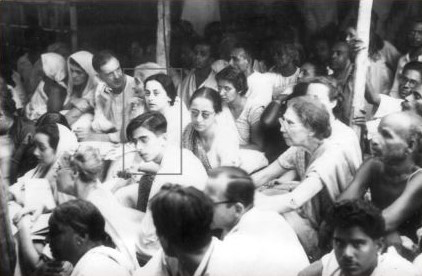




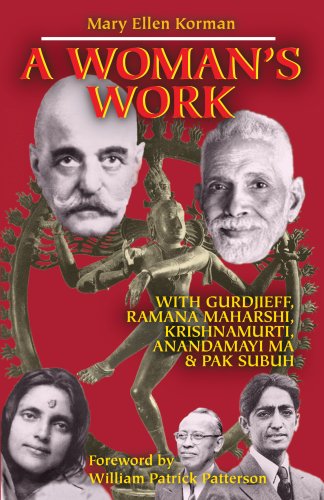
A Woman’s Work : The spiritual life journey of Ethel Merston
Forward by William Patrick Patterson
Ethel Merston was an intelligent and gifted woman of great vitality whose search for the truth of herself led her to meet many of the great spiritual luminaries of her time G. I. Gurdjieff, Ramana Maharshi, Krishnamurti, Anandamayi Ma, Sri Aurobindo and The Mother, and Pak Subuh. She was also acquainted with Helena Blavatsky’s Theosophy, the psychics Edgar Cayce and Eileen Garrett, the anthropologist Ruth Underhill, and that other intrepid seeker, J. G. Bennett.
Born to a wealthy Jewish family in Victorian London, Ethel is given all the privileges that come with her station in life, but she also bears a psychic scar inflicted by her mother, who does all she can to diminish young Ethel’s relationship with her father. This psychic wound, together with her later experience of the wondrous unity of life, appear to be the catalysts impelling her search.
There she meets and works with A. R. Orage, Sophia Ouspensky, Olga and Thomas de Hartmann, and Jeanne de Salzmann—as well as the precocious boy Fritz Peters. Given her natural organizational abilities—honed by four years of service as an officer in the Women’s Royal Naval Service during World War One—and a strong work ethic, Gurdjieff puts her in charge of running the Prieuré during his frequent absences. Eleven-year-old Peters, “a born troublemaker” Gurdjieff calls him, and the 41-year-old Ethel almost immediately collide.
After some five years at the Prieuré, Ethel returns to London, insisting in her diary that she came to Gurdjieff only in the hopes of healing a bad back and not for any teaching. Still, she continues Gurdjieff’s core practices of self-transformation and, nearing the end of her life, we find her creating the first glossary of Gurdjieff’s magnum opus, All and Everything, which years earlier she had helped translate at the Prieuré.
Her search takes her to India where she meets many prominent teachers. Krishnamurti she never quite connects with—one suspects he regards her as too mental. We hear of a meeting between him and Anandamayi Ma, who questions his rigidity concerning gurus and his rather testy reply. With Anandamayi Ma, Ethel feels more kinship and is delighted when the saint embraces Ethel and invites her to travel with her. In Pondicherry she meets Sri Aurobindo and The Mother; her impressions of them are quite insightful. She also gives a fascinating account of the meeting between Anandamayi and The Mother—the two women representing such opposite paths, one of worship, the other of transformation.
Of all the Indian teachers, Ramana Maharshi, the Advaitic Hindu sage, makes the deepest impression. She lives on and off at his ashram in Tiruvannamalai and is there for many of the talks recounted in Talks with Ramana Maharshi, several of her questions recorded in its pages. She gives one of the few first-hand accounts of his final illness and death.
When not at the ashram, Ethel manages an Indian farm at Sarai Mohana and soon becomes a leader in village life. She becomes friends with many Westerners living in India, such as Krishna Prem, Madhava Ashish, the poet Lewis Thompson, and Alain Daniélou, with whom she works on his first book, Introduction to the Study
of Musical Scales. Of all those encountered, the most unusual are Maud MacCarthy, a childhood schoolmate and violin prodigy, later known as Swami Omananda, and her medium friend, “The Boy,” as well as Sunyata, the Dane Alfred Julius Emmanuel Sorenson, whom Ramana Maharshi called “a rare born mystic.”
Ever the traveller, in her seventies Ethel makes one last voyage. In America she visits Franklin Farms in Mendham, New Jersey, the centre of Gurdjieff’s teaching in the States. There she reconnects with the women she first met decades before at the Prieuré, as well as Lord John Pentland, the man Gurdjieff had chosen to lead the Work in America. In England she visits J. G. Bennett’s teaching institute at Coombe Springs, where previously she had met Pak Subuh.
Smoothly written and faithfully recounted, Mary Ellen Korman allows Ethel to present her life as she would have wished it. Of the records of spiritual searches made at this time, Mary Ellen Korman’s A Woman’s Work is certain to take its place among the very finest evocations.
John Robert Colombo reviews Mary Ellen Korman’s A Woman’s Work
What I have before me as I write this review is a handsome trade paperback titled A Woman’s Work. It is subtitled The Spiritual Life Journey of Ethel Merston and the author is Mary Ellen Korman. Barbara Allen Patterson is identified as the book’s editor. I assume Mrs Patterson to be the wife of William Patrick Patterson, the energetic and well-known exponent of the Fourth Way, who has contributed a short Foreword.
Patterson is a partner in Arete Communications of Fairfax, California, the book’s publisher, as well as the founder-editor of The Gurdjieff Journal, the latest issues of which have been serialising the text of this book. So as a subscriber to the Journal, I knew the book was about to be published, but not so soon. Maybe the publisher was also surprised. On the book’s copyright page, there are two curiosities.
The first curiosity is that the present publication has been copyrighted in the year 2009. This is a slip-up that is certain to confuse librarians and bibliophiles. (J. Walter Driscoll, bibliographer of Fourth Way publications, take note!) For the record, I purchased my copy directly from the publisher and it arrived on August 11, 2008.
The copyright page’s second curiosity is that it runs the Library of Congress Catalogue which lists ten names for indexing purposes. Since these could double as the backbone of the book, let me list them here in the order in which they appear on the copyright page:
1. Ethel Merston. 2. G.I. Gurdjieff. 3. Ramana Maharshi. 4. J.D. Krishnamurti. 5. Anandamayi Ma. 6. Sunyata. 7. Swami Omananda. 8. Pak Subuh. 9. J.G. Bennett. 10. Fourth Way.
These names are quite a mouthful! The book also offers the reader forty-nine black-and-white photographs of gurus and other people. There are generous source-notes and also an index of names.
I know little about the author, Mary Ellen Korman, except for what it says on the book’s back cover: “Editor-writer Mary Ellen Korman has long been interested in spiritual transformation and its many approaches. She teaches a yoga of body impressions and lives in southern Pennsylvania.” I am not quite sure how a session of “a yoga of body impressions” differs from a standard session of hatha yoga, but that is what it says and I am willing to learn.
In the Preface, Mrs Korman acknowledges the contribution of her husband Henry Korman, with whom she has authored an earlier book in 1997. Its title is not promising, as least in the present context: Living with Dogs : Tales of Love, Commitment, and Enduring Friendship.
As a reader and reviewer of this book, however, I want to acknowledge the seamless prose of Mrs Korman. She has done exemplary work combining her own writing with that of Miss Merston who kept a diary of her life, travels, and reflections. Passages from this diary and
other works are introduced into the narrative. (The typescript of the diary is on deposit at the City of Westminster Archives in London.) The two voices are one voice, rather like the chanting of one of those Tibetan monks who is able to intone both a tone and an overtone in one breath simultaneously.
My sole criticism is that Mrs Korman is too vague about some facts that could have been checked. For instance, was Miss Merston really awarded an O.B.E. (Order of the British Empire) for her outstanding work with the WRNS (Women’s Royal Naval Service) during the Great war? More work should have been done here and elsewhere.
Now to Ethel Merston. The excerpts from the book that have been appearing in issues of The Gurdjieff Review did not really whet my appetite to read the full text, but the mention of the “big names” did pique my interest – enough to purchase a copy. All her life, Miss Merston was a pilgrim, a quester, a seeker. She would probably concur with this description of her way of life – but not if the definition of a “seeker” excludes someone who is a “finder.” I will return to this point shortly, but first some biographical information.
Ethel Merston was born in London, England, in 1882, into a family of professional and accomplished Jewish-German parents of some wealth and social standing. The original family name was Meyerstein. It seems the family was a secularise one and dysfunctional. Edith’s mother was artistic but high-strung and young Ethel fought with her bitterly. The mother also “dabbled” in Theosophy.
When Ethel was eight years old, Madame Blavatsky “came to tea.” She and her younger brother Will met the Madame. “Ethel and Will had heard that Madame Blavatsky had only to point her finger at an object and it would fall. The children watched her closely. When finally she pointed and nothing happened, they were disgusted with her.” That incident seems to have set the pattern for the future full of ultimately disappointing meetings with gurus.
Ethel developed various psychosomatic illnesses (the author is as vague as Ethel is about these) but as if in compensation, she had a passion for languages and gardening. She left home without any education or training and supported herself with temporary secretarial work. She joins the WRNS and apparently distinguished herself on the home front during the Great War.
After the war she sought the services of a psychiatrist, and her choice of specialists is interesting: Dr Maurice Nicoll, who was at the point of abandoning Jung for Gurdjieff. She heard Gurdjieff speak on one occasion and on another attended a lecture at the Quest Society on the Fourth Dimension delivered by P.D. Ouspensky.
All this is mentioned in passing, in so many words, as the author has hardly any other real information about Ethel’s first forty years. So the biography effectively begins on a bench on the Boulevard de la Madeleine in Paris in late August of 1922, when she meets George Gurdjieff and appeals to him to receive her at the Priory, which is on the point of opening its doors to selected members of the public. After half an hour of silence, Gurdjieff replies with one word: “Come.”
It turned out that Ethel – I will call her Merston hereafter – had organisational and administrative abilities, so she became the chief gardener at the 200-acre estate at Fontainebleau-Avon. She learned enough Russian to order the Russian residents around and she possessed enough class to intimidate the English visitors. This period is well documented in the literature of the Fourth Way, particularly by her nemesis at the Priory: young Fritz Peters who later wrote about the many run-ins that he had with her.
Merston emerged as an unliked and unlikeable martinet (with “a little black book” to record transgressions). Part of a chapter is devoted to describing how Gurdjieff took pains to humanise her in the eyes of the residents and visitors, and how he laboured to sensitise her to the needs of other people, as other people experienced her as being captious and distant.
At the Priory she learned to deal to some extent with her pressing spinal problems through massage therapy as well as exercises in self-remembering and self-observation: “I did not try to stop the worry, but just to separate it from the body.” She wrote about Gurdjieff: “I did not go to him for spiritual teaching, but solely for physical healing purposes.” She left the Priory in 1927, but continued her personal associations with Gurdjieff’s followers.
This would be a long review, indeed, if I gave equal time to Merston’s experiences with other teachers in other parts of the world. Here I will devote a sentence or two to each encounter, as she visits guru after guru. Through the influence of a psychotherapist named Adelaide Gardiner, who was also a leader of the Theosophical Society’s Esoteric Group, she undertook a study of the “astral body.”
An inheritance from the estate of her parents in 1932 left her independently wealthy and free to travel at will. In New York City she met Ruth Underhill and the two of them shared accommodation in Tucson, Arizona. She attended A.R. Orage’s groups in New York in 1924. She even had psychic readings conducted by Edgar Cayce and another by Mrs Eileen Garrett. Nothing much occurred.
In 1934, at the age of fifty-two, she arrived in Bombay. She would live in India off and on for the rest of her life. She never married or showed much interest in or understanding of men. She shared living quarters with a series of talented but unstable women who exhibited psychic abilities as well as symptoms of mental, emotional, and physical disorders. She met Saroijini Naidu, the poet and patriot, whom she admired, and Mohandas Gandhi, who impressed her (as he did everyone else, except Ali Jinnah of Pakistan).
Readers interested in how an English woman of a certain social class conducted herself in India prior to Partition will find the bulk of the book worth reading. The same is true for readers interested in trance mediumship, for Merston’s companions were always conducting seances or otherwise simply falling into trances. Seldom did the voices that spoke to them during these sessions said anything significant. Musicologists will be interested in the descriptions of violinist Maude MacCarthy (Omananda Puri) and her husband, the brilliant composer John Foulds.
In the meantime Merston read books by Alice Bailey, Helena and Nicholas Roerich, and Paul Brunton, and she received private instruction in specific but unnamed yogic techniques from a Hindu medical doctor. In 1935, she returned briefly to Europe where she attended one of Krishnamurti’s talks at Ommen, Holland. It seemed she had no rapport with the designated World Saviour, or he with her.
Then it is back to India again. In 1931, Paul Brunton had received instruction from Ramana Maharshi, “one of India’s great sages,” and Merston was drawn to the Adviatic Vedantic teacher’s ashram near the temple town of Tiruvannamalai at the foot of Aurunachala. She was struck by the place’s peace and beauty.
She sat with Maharshi and told him, “I have hopes that I shall find some interest in life.” The Maharshi replied, “If there is no interest, it is good.” Their dialogue is reproduced at some length but it seems to be a mishmash of cliché and mistranslation. She soon left to visit other places and people, but she would return at least five times: “I visited the Ashram each summer to sit in Bhagawan’s presence.”
Merston spent the Second World War in India. She immersed herself in village life and acted in many capacities – as social worker, nurse, gardener, herder, magistrate, etc. It turned out her distance from other people made her good at non-judicial dispute resolution and social mediation. But her labours were uphill battles against the centuries-old ignorance of the villagers and the new-found arrogance of the politicians and bureaucrats of the national government.
She met Alain Daniélou and his companion Raymond Burnier, musicologists who had studied at Rabindranath Tagore’s Shantiniketan. Then she met dance student Uday Shankar, guru Anandamayi Ma, poet Lewis Thompson, guru Krishna Prem at the famous ashrama of Mirtola, and Sri Aurobindo at Pondicherry.
She visited the ashram of Sri Anandamayi Ma, but rejected the Bengali guru’s approach of devotion and worship. She befriended the Danish mystic Sunyata (Alfred Sorensen) and regarded him as a “natural” mystic, as had Brunton earlier. She was attracted to the spiritualism of Swami Omananda and The Boy who channelled The Brothers.
She attended the death of Ramana Maharshi at his ashram in 1950. As she herself observed, it seemed to take decades for the lessons of her teachers to take effect. “If I understood anything of the Maharshi’s way of Self-inquiry, it is entirely due to Gurdjieff.”
On a visit to England in March 1954, J.B. Bennett invited her to stay at Coombe Springs. She undertook editorial tasks connected with his three-volume work The Dramatic Universe. All the while she continued to work on her own glossary of All and Everything. What became of that glossary is not mentioned. It seems Madame de Saltzman, with whom she had no genuine relationship, had commissioned a glossary of her own.
On a return visit to Coombe Springs in 1957, she met Pak Subuh. She was suspicious of the Indonesian teacher and felt hypnotism was behind the effects of latihan. She invoked Bennett’s repeated experiences of latihan to explain his end-of-the-day conversion to Catholicism. Latihan (from Indonesian latihan kejiwaan; “spiritual exercise”) is a form of spiritual practice. It is the principal practice of the Subud organisation.
In 1958, she visited friends in San Francisco, and in New York she met up with an old friend, Jessmin Howarth, and at Franklin Farms in Mendham, New Jersey, she conversed with John Pentland and mathematician Christopher Fremantle.
Back in India in 1959, she resumed her friendship with a Benedictine monk, Père Henri Le Saux, who wrote kind words about her, including these: “She was an Englishwoman, always ready to do anyone a kindness, no matter when or who it might be. This she always did with great sensitivity….” It seems that the five decades of wandering in search of gurus had engendered compassion. In 1967, at the age of eighty-four, Merston succumbed to cancer and died in the shadow of her beloved Arunachala.
What to make of her life? She was at once an adventurous Englishwoman and a spiritual voyager, yet it seems (at least to the bystander or interested observer) that hers was a life of to-ing and fro-ing without much sense of self-awareness or self-fulfilment. (She cruised on ocean-going vessels rather than on jetliners, but nonetheless she brings to mind a jet-setting, globe-trotting journalist like Pico Iyer.) No doubt she did what she wanted to do at the time, but did it satisfy her? Despite years of hard work, indeed labour, she seems to have scattered her attentions and her achievements. What were her goals? Simply to live? Who is to say? She, the expert, does not say.
She was definitely not a finder, if by “a finder” is meant someone who makes a self-discovery, perhaps a “personal best.” Within herself she carried her problems (psychological as well as physical), and was unable to commit herself to any single discipline or kindle within herself a spark or flame of independence. This may explain her never-ending, peripatetic pilgrimages to visit the world’s spiritual leaders and sacred sites. Perhaps it is the travel and not the terminus that is the destination.
As I read about the travels of Miss Merston, however, I kept thinking about an Alice whom I knew, not “Alice in Wonderland” but the woman who for decades until her recent death served as my research assistant. A social-worker by profession, a woman the age of my mother, all her life she was a “quester.”
Over the eighty years of her life she was, serially, a Presbyterian by birth, a member of the United Church of Canada by default, a Theosophist by interest, a student of the Kaballah through chance, a Crowleyite as it happened, an Anthroposophist for reason of residence, a Mormon by marriage, and at the end of her life an Anglican for convenience. She seemed to have missed Gurdjieff (though she once attended a function at the Foundation in New York, something I have never done) and also Krishnamurti (though she did attend one of his talks).
Looking back on this “quest” of hers, I wonder about its seriousness. Alice was an independent thinker to the degree that she yearned for a meaning and a significance in life that she could not find in organised religion. But she was stubborn and would not learn anything from anyone but herself. Was Alice passing the time? Was she in search of a miracle? Was she like Merston?
We are informed that Merston began by searching for a cure for the severe back pains that she suffered, but I believe she had much more than that in mind. She was waiting for someone to offer her a placebo with no strings attached. It never happened.
The “quests” of these two women bring to mind the famous byword of the stage magician. Referring to the “vanishment” of an object, the magician knows what his audience does not suspect: “Either the object is still there or the object was never there to begin with.” Is it a stretch to say that the same principle may be applied to the “search for truth”? Indeed, it is there to begin with, or it will not be found elsewhere.
John Robert Colombo is the author-editor of three books devoted to the life and work of Denis Saurat, the Anglo-French littérateur and metaphysician. This fall will see the publication of a collection of his essays titled Whistle While You Work.
Ella Maillart was an early 20th Century pioneer among women adventurers. Strong, ever curious about the unknown and fascinated with travel she sailed over seas and journeyed with caravans, on foot and seated on animals, throughout remote areas of Chinese Turkestan, the Caucasus, the Tien Shan Mountains, Russia, Mongolia, and Tibet. She realised that the only way for her to make a living was to write about her experiences. During World War II she remained in India from 1939 to 1945 and resided mostly in Tiruvannamalai, understanding, at last, that the ultimate adventure and real journey is to make the inner one to the realisation of the Self. Ella eventually followed Hague’s lead and began the long journey back to Europe. She took leave of the ashram in February 1945, and made her way up to Kalimpong via Madras and Calcutta. She arrived in Switzerland on June 10 1945, it had been six years since she last saw her homeland.
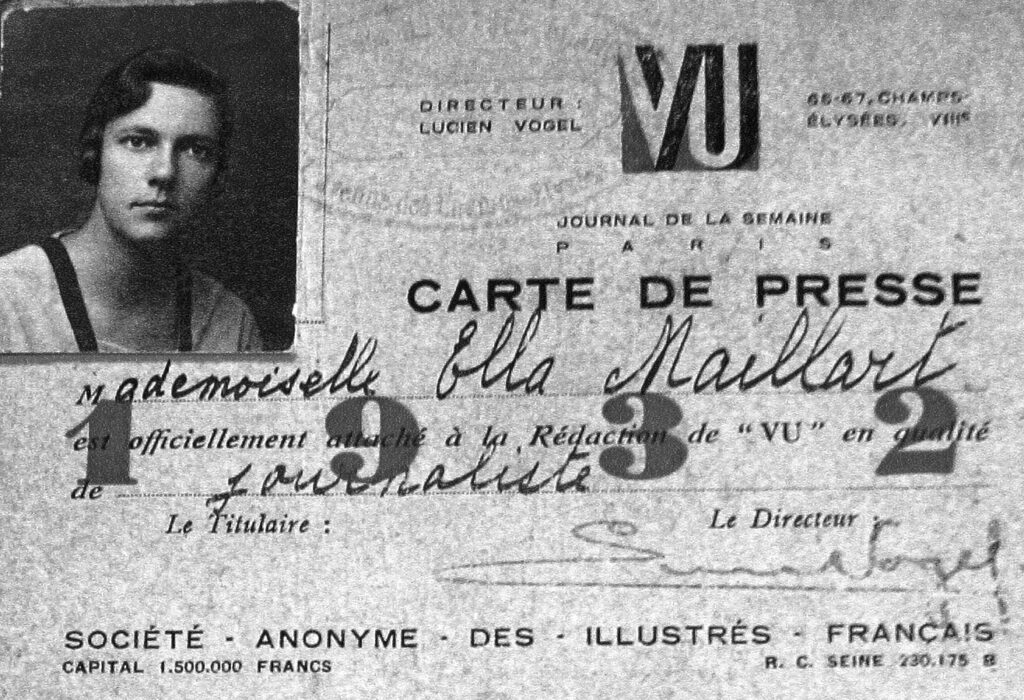

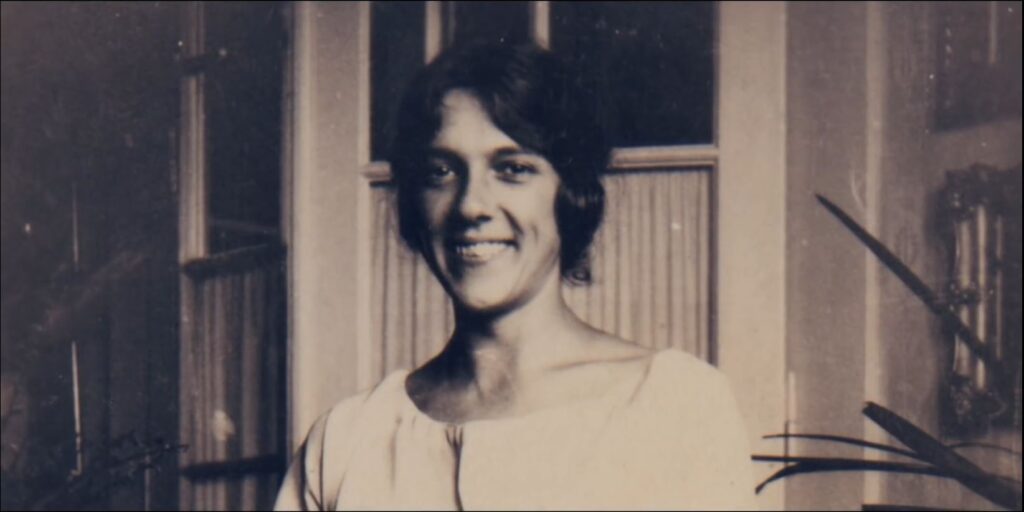

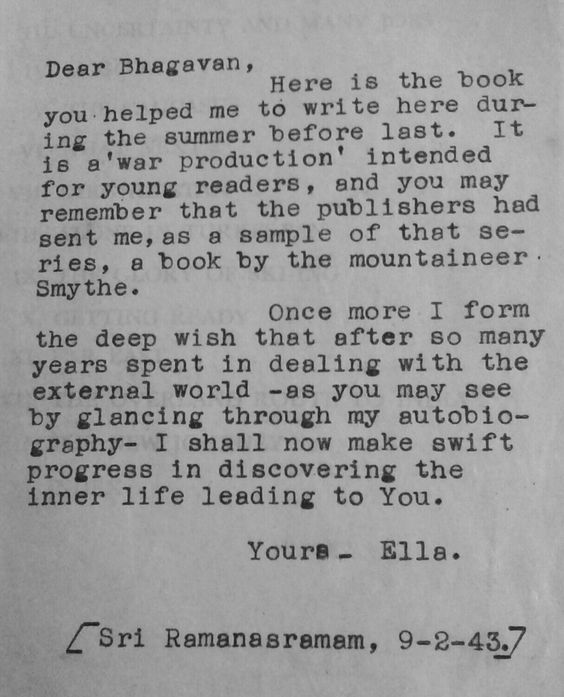
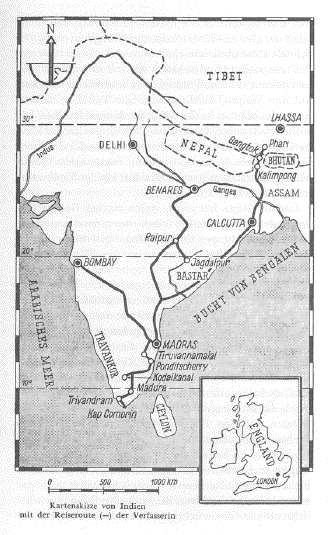
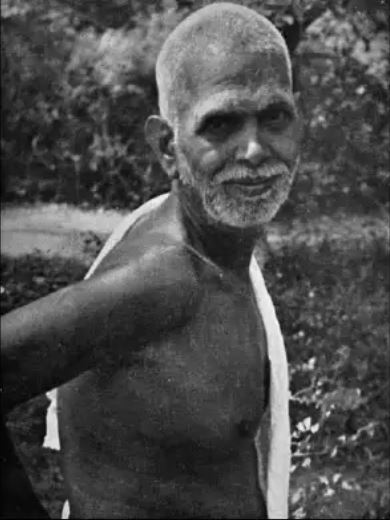


In 1935 she was sent as a special correspondent by the French newspaper Petit Parisien to Manchuria. It was there that she re-encountered Peter Fleming (whom she had previously interviewed in London), who was in China for the Times, and she suggested that they embark together on a 3,500-mile trip west from Peking through the Taklamakan desert and Sin-kiang (at that time closed to foreigners) to Kashmir: a journey which took seven months. In the foreword to his book of the journey News From Tartary (1936) Fleming wrote “I can hardly doubt that you will find her, as I did, a gallant traveller and a good companion.”

Face to Face with Sri Ramana Maharshi Compiled and Edited by Professor Laxmi Narain.
https://www.stillnessspeaks.com/wp-content/uploads/2016/07/Face_to_Face_with_Sri_Ramana_Maharshi.pdf
Face to Face with Sri Ramana Maharshi Compiled and Edited by Professor Laxmi Narain.
https://www.stillnessspeaks.com/wp-content/uploads/2016/07/Face_to_Face_with_Sri_Ramana_Maharshi.pdf
William S. Spaulding Jr of New York City visited Sri Ramana in the 1930s. As I sat in His Presence for the first time, the most powerful impression was that of what I can only call an almost palpable ‘golden radiance’, the visual effect of a tremendous spiritual force. There was an intense and subtle radiation that seems to flow from Him continually – and once having sensed this, words, questions, techniques of meditation, etc., seemed to dissolve immediately. The Maharshi also possessed to a high degree of that quality which is described as ‘divine indifference,’ attributed to certain saints of the Christian Church. This must not be taken to mean what is generally associated with the term ‘indifference’, but rather as a beneficent, unfettered out-pouring of healing radiations of a Realised Being.
Mother of Dr Suzanne Alexandra Curtil Sen, Jeanne Curtil and Suzannes’s daughter Monica arrived in 1940, Monica would attend school in Bangalore but would visit the ashram once or twice a year until 1952.


Western devotees at Ramana Maharshi’s Mahasamadhi, taken from an Indian Govt Newsreel – 15 April 1950.

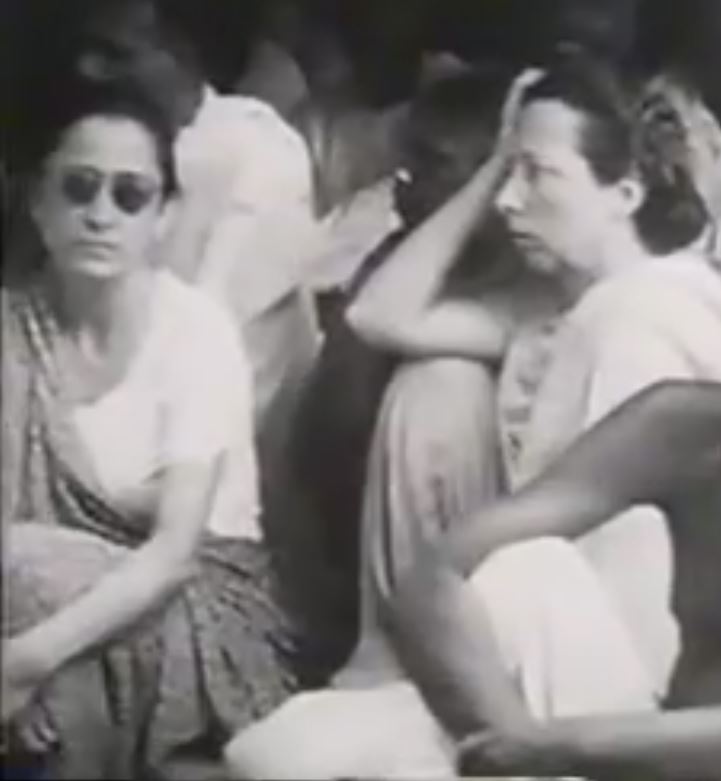
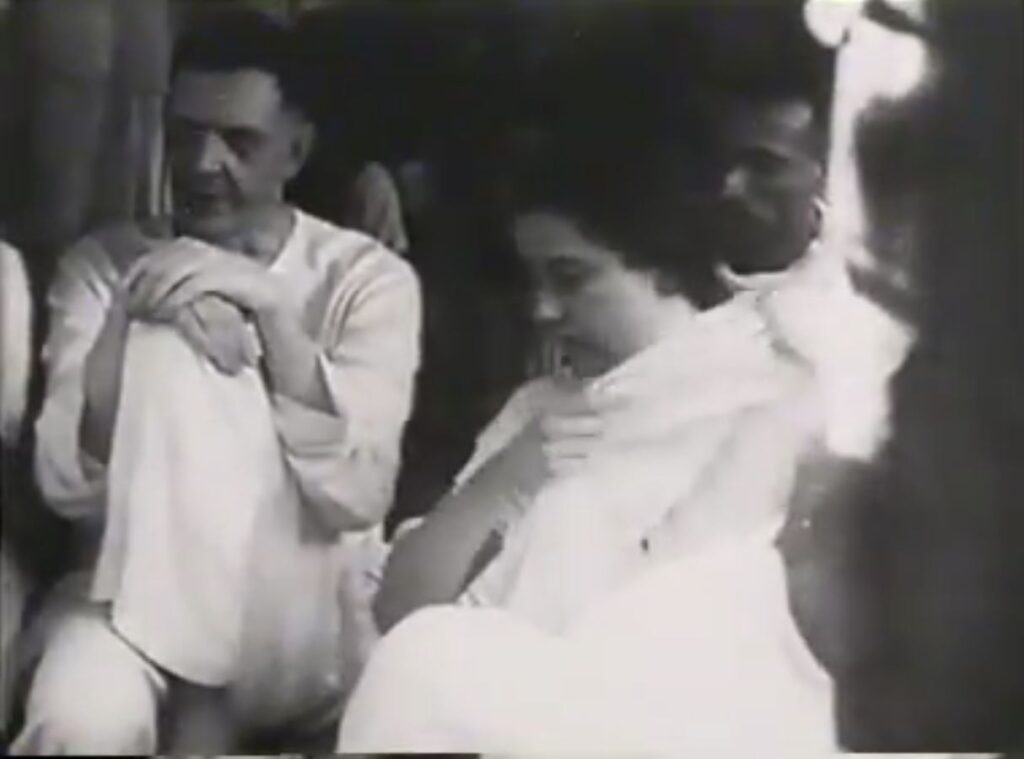

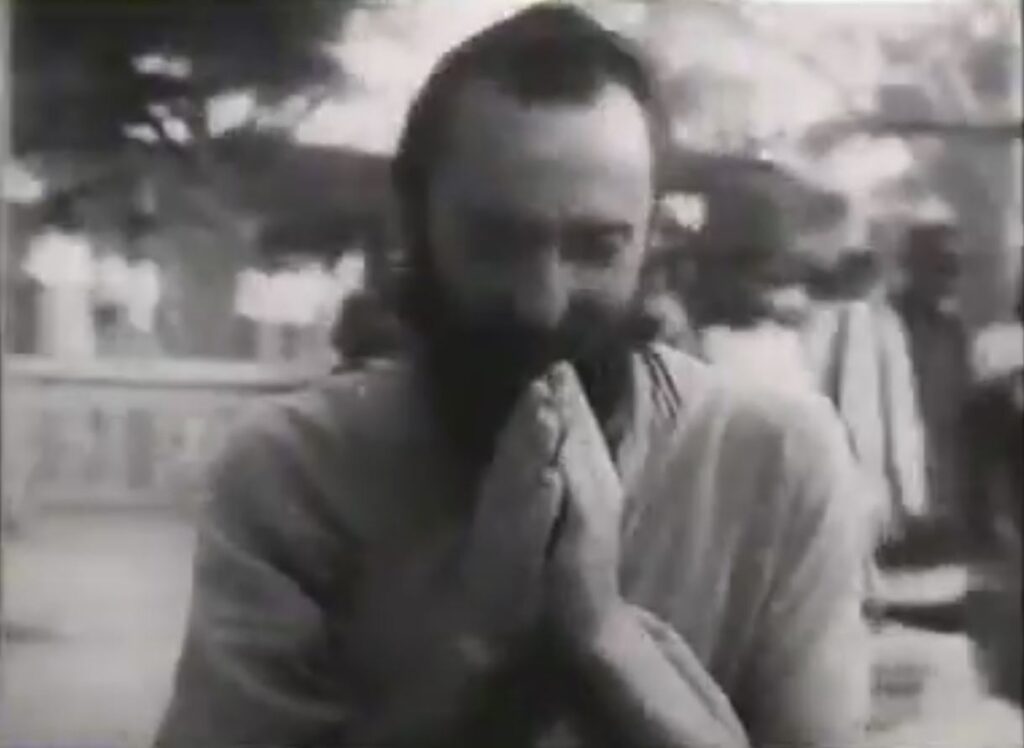
Gary Snyder and Joanne Kyger had stayed with the Osborne’s briefly in Janurary 1962, staying in a little room on the top of the house from which they could look out at Arunachala through a mass of bougainvillea. Gary Snyder was once described by fellow poet Allen Ginsberg in October 1955 at the Six Gallery reading for the first public performance of Ginsberg’s poem ‘Howl,’ as “a bearded youth of 26, formerly a lumberjack and seaman, who had lived with the American Indians.” Snyder’s uncles had all gone to sea or worked in logging camps. Ginsberg also said that Snyder was “perhaps more remarkable than any of the others.” Jack Kerouac who was also in the audience later recalled that Snyder as “the only one who didn’t look like a poet.” Kerouac thought Snyder as one of “the old-time American heroes.” Three years later, Kerouac published The Dharma Bums, a novel featuring Snyder as the mountain-climbing, haiku-hatching hero, Japhy Ryder.
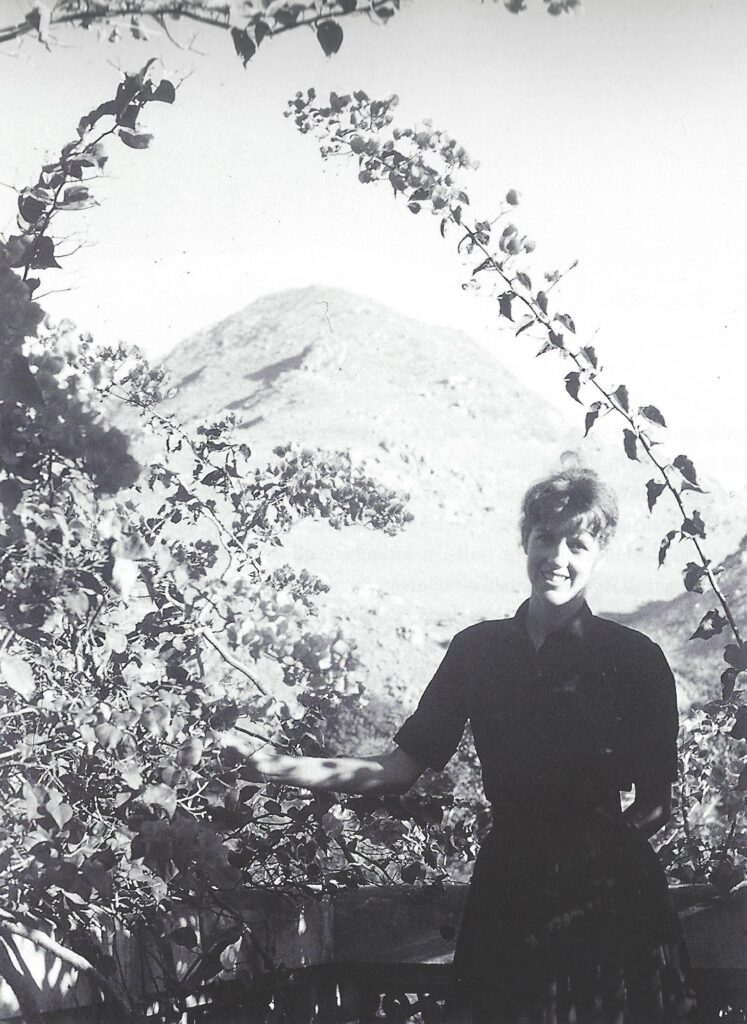
Deborah Baker mentioned while speaking at the Indian Summer Festival in Vancouver in 2019, that Gary was a serious student of Zen Buddhism. Before arriving in India, while in Kyoto to become enlightened, he was desperate for Joanne to join him from California, “If you come to Kyoto and study meditation and Buddhism with me you will lose your ego” to which she replied “why would I want to lose my ego?, I have tried for years to have one.”
From Deborah Baker’s book A Blue Hand: The Beats in India “Don’t you want to study Zen and lose your ego?” Gary Snyder asked Joanne Kyger upon her arrival in Japan and learning of her decision not to stay. “What!” Joanne had replied with koanlike economy. “After all this struggle to obtain one?”
Author David Godman arrived in Tiruvannamalai in 1976 after reading Arthur Osborne’s book, The Teachings of Ramana Maharshi in his Own Words. After three days in the ashram, he spent the next eighteen months in Arthur and Lucia Osborne’s home, taking a room at the back of the house. Arthur had passed away a few years before. Despite his intention to stay in India for only six weeks, he has been there almost continuously ever since, residing mainly in Tiruvannamalai. In 1978, he began to do voluntary work for Sri Ramanasramam. He looked after their library from 1978 to 1985, edited their magazine for a short period of time, and from 1985 onwards did research for his various books. In 1993, he went to Lucknow and spent four years with H.W.L. Poonja a well known devotee of Ramana Maharshi. He returned to Tiruvannamalai in 1997 and has since been researching and writing new books on Ramana Maharshi.
Other devotees of Sri Ramana Maharshi
https://archive.arunachala.org/ramana/devotees/
Unidentified Western visitors and devotees of Ramana Maharshi


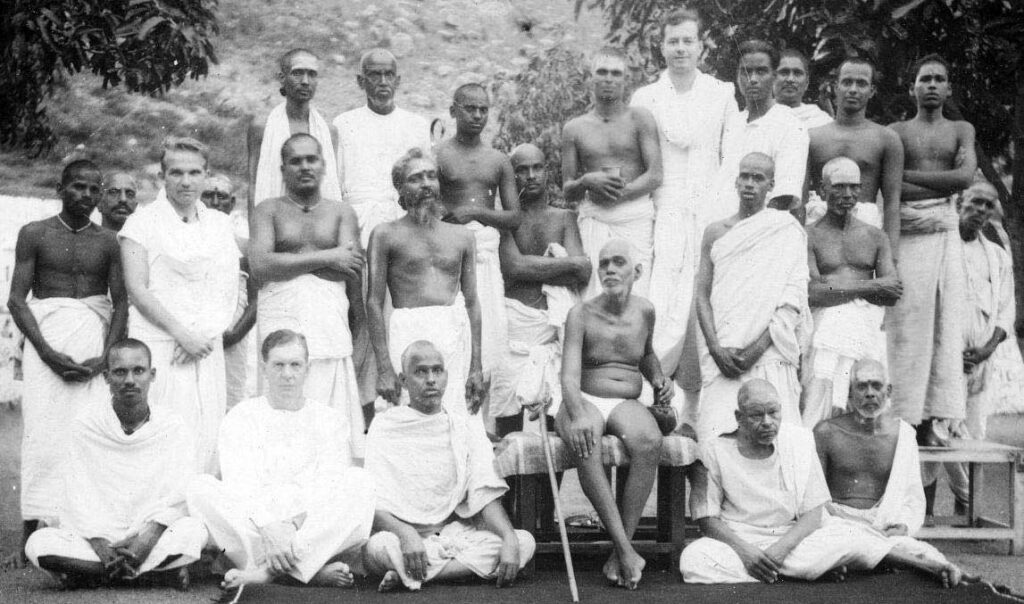

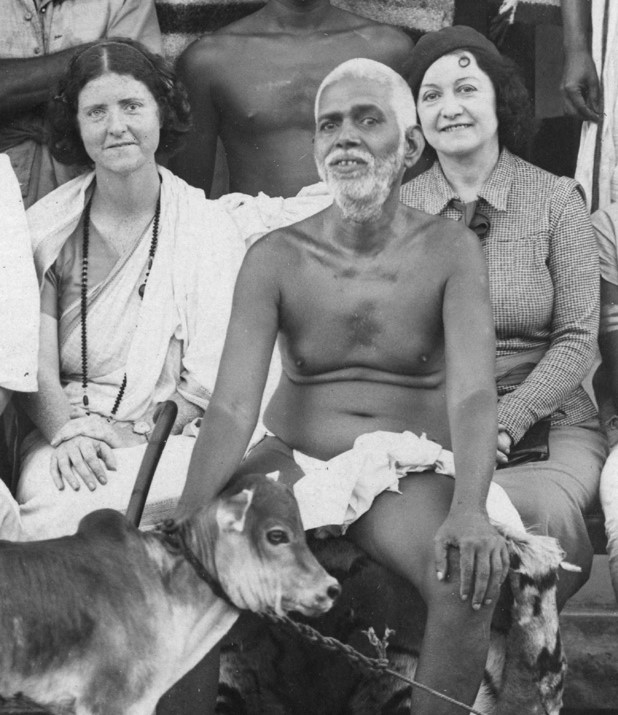




Parsi actress Feroze Taleyarkhan was born 1898. She came from a wealthy family. In the mid or late 1920s, she visited Hazrat Babajan’s shelter at the neem tree, being greeted with the words: “Oh, so you have come!” According to her own report, Taleyarkhan then broke into “a flood of tears.” Babajan consoled her. The saint herself wept. For two or three days, the visitor was not her usual self, being distracted from her surroundings. Babajan subsequently predicted a change for the visitor. After the matriarch’s death, Taleyarkhan became a devotee of Ramana Maharshi during the 1930s. She later authored the book Sages, Saints and Arunachala Ramana (1970).

https://archive.org/embed/sages-saints-and-arunachala-ramana
Fanny Guex
Ms Guex’s research deals with travel literature, connected histories and intercultural encounters. In particular, she studied 3 transnational life trajectories of Swiss citizens that went to India at the period of the Second World War and wrote about their spiritual and transcultural experiences: Ella Maillart (1903-1997), Lizelle Reymond (1899-1994) and Father Jean-Bernard Simon-Vermot (1923-2016). https://columbia.academia.edu/FannyGuex
